Meneghetti RUEI Induction Cooking Range with Oven User Manual User and Care Manual
Meneghetti SpA Induction Cooking Range with Oven User and Care Manual
Contents
- 1. Installation Manual
- 2. User and Care Manual
User and Care Manual
USE & CARE MANUAL
INDUCTION RANGE
type RUEI
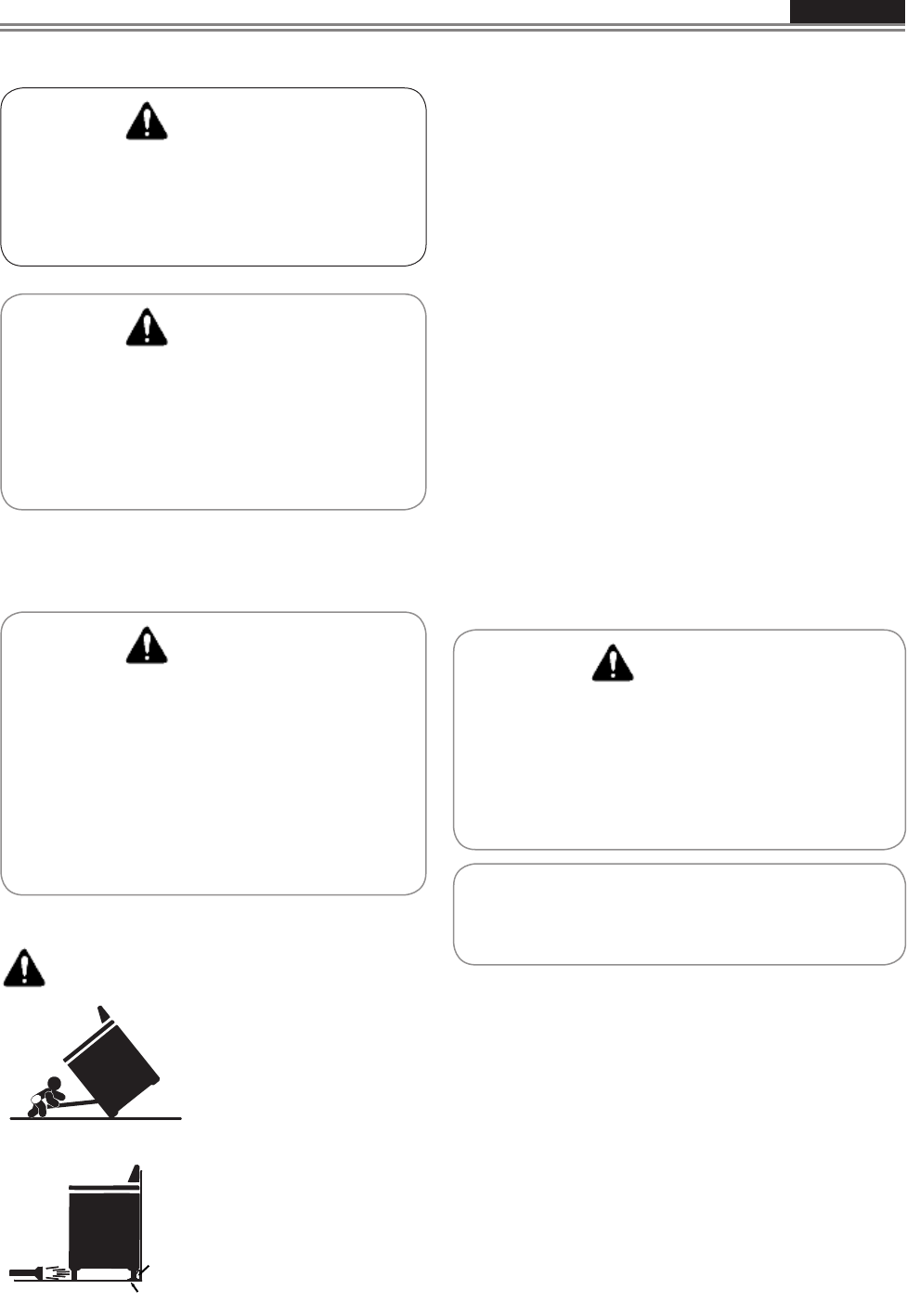
ENGLISH
Use & Care Manual
1
Pay attention to these symbols present in this
manual:
WARNING
● This is the safety alert symbol. This symbol
alertsyoutopotentialhazardsthatcankillor
hurtyouandothers.
● You can be killed or seriously injured if you
don’tfollowtheseinstructions.
READ AND SAVE THESE INSTRUCTIONS.
WARNING
If the information in this manual is not followed
exactly, a re or explosion may result causing
propertydamage,personalinjuryordeath.
- Donotstoreorusegasolineorotherammable
vapors and liquids in the vicinity of this or any
otherappliance.
WARNINGS FOR ELECTRIC
INSTALLATION
WARNING
●Installationand servicemustbeperformed bya
qualiedinstallerorserviceagency.
●Themodelsmaybepoweredat240Vor208V.
CAUTION
●Always disconnect the electrical plug from the
wallreceptaclebeforeservicingthisunit.
●For personal safety, this appliance must be
properlygrounded.
Donotunderanycircumstancescutorremovethe
third(ground)prongfromthepowercordplug.
WARNING
Persons with a pacemaker or similar medical device
shouldexercisecautionwhenusingorstandingnearan
inductionunitwhileitisinoperation.Theelectromagnetic
fieldmayeffecttheworkingofthepacemakerorsimilar
medical device. It is advisable to consult your doctor
or the pacemaker manufacturer about your particular
situation.
WARNING
TipOverHazard
Achildoradultcantiptherangeandbekilled.
Ensuretheanti-tipbracketisengagedwhentherangeismoved.
Donotoperaterangewithoutanti-tipbracketinstalledandengaged.
Failuretofollowtheseinstructionscanresultindeathorseriousburnstochildrenand
adults.
Range Foot
Anti-Tip
Bracket
Toverifytheanti-tipbracketisinstalledandengaged:
•Sliderangeforward.
•Lookfortheanti-tipbracketsecurelyattachedtooororwall.
•Sliderangebacksorearrangefootisunderanti-tipbracket.
•Seeinstallationinstructionsfordetails.
authority to operate the equipment.
to Part 18 of the FCC rules. These limits are designed
interference in a residential installation. This equipment
interference will not occur in a particular installation. If
this equipment does cause harmful interference to radio
following measures:
• Connect the equipment into an outlet or a circuit
technician for help.
IMPORTANT: Savetheseinstructionsforthelocalelectricalinspector
use.
INSTALLER:Pleaseleavethismanualwithownerforfuturereference.
OWNER:Pleasekeepthismanualforfuturereference.
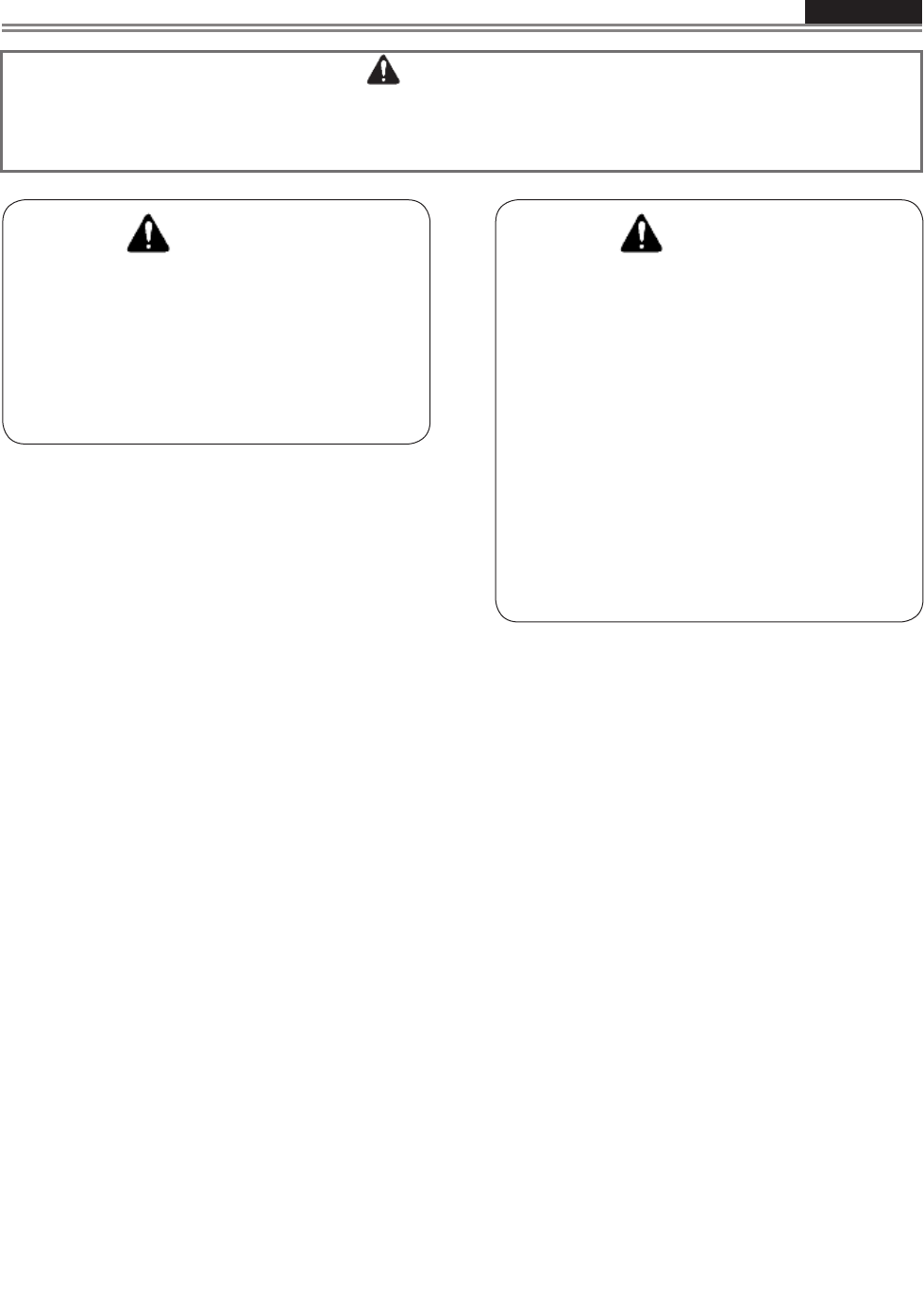
ENGLISH
Use & Care Manual
3
WARNING
When properly cared for, your new range has
been designed to be a safe, reliable appliance.
Read all instructions carefully before using
thisrange.Theseprecautionswillreducethe
risk of burns, electric shock, re, and injury
to persons. When using kitchen appliances,
basic safety precautions must be followed,
includingthefollowing:
This appliance must be properly installed and
grounded by a qualied technician. Connect only
to properly grounded outlet. See “Grounding
Instructions”foundintheInstallationInstructions.
• This applianceshouldbeservicedonlybya
qualiedservicetechnician.Contactthenearest
authorizedservicecenterforexamination,repair
oradjustment.
• Donotrepairorreplaceanypartoftheappliance
unlessspecicallyrecommended.Referserviceto
anauthorizedservicer.
• Donotoperatethisapplianceifitisnotworking
properlyorifithasbeendamaged,untilan
authorizedservicerhasexaminedit.
• Installorlocatethisapplianceonlyinaccordance
withtheInstallationInstructions.
• Use this range only as intended by the
manufacturer.Ifyouhaveanyquestions,contact
themanufacturer.
• Do notcoverorblockanyopeningsonthis
appliance.
• Usethisapplianceonlyforitsintendeduseas
describedinthismanual.Donotusecorrosive
chemicals,vapors,ornonfoodproductsinthis
appliance.Thistypeofovenisspecicallydesigned
toheatorcook.Itisnotdesignedforindustrialor
laboratoryuse.Theuseofcorrosivechemicalsin
heatingorcleaningwilldamagetheappliance.
• Intheeventthatpersonalclothingorhaircatches
re,DROPANDROLLIMMEDIATELYtoextinguish
ames.
WARNING
• BE CAREFUL TO PREVENT BURNS. If the
amesdonotgooutimmediately,EVACUATE
ANDCALLTHEFIREDEPARTMENT.
• Do not use water, including wet dishcloths or
towelsongreaseres.Aviolentsteamexplosion
mayresult.
• NEVER PICK UPA FLAMING PAN. You may
beburned.
• ALWAYShaveaworkingSMOKEDETECTOR
nearthekitchen.
• LEAVE THE HOOD VENTILATOR ON when
ambéingfood.
Toreducetheriskofburninjuriesduringcooktop
use,observethefollowing:
• NEVER use this appliance as a space heater to
heatorwarmtheroom.
• Children or pets should not be left alone or
unattended in an area where appliances are in
use.
• Theyshould never be allowed to sit or stand on
anypartoftheappliance.
• Donot storeammablematerials on ornearthe
cooktop.
• Useonlydrypotholders;moistordamppotholders
onhotsurfacesmaycauseburnsfromsteam.
• Neverleavethecooktopunattendedwheninuse.
• Boilovers cause smoking, and greasy spillovers
mayignite.Aspillonaburnercansmotherallorpart
oftheameorhindersparkignition.Ifaboilover
occurs, turn off burner and check operation. If
burnerisoperatingnormally,turnitbackon.
• Duringcooking,settheburnercontrolsothatthe
ameheatsonlythebottomofthepananddoes
notextendbeyondthebottomofthepan.
• Takecarethatdraftslikethosefromfansorforced
air vents do not blow ammable material toward
theamesorpushtheamessothattheyextend
beyondtheedgesofthepan.
• Alwayspositionhandlesofutensilsinwardsothey
donotextendoveradjacentworkareas,burners,
ortheedgeofthecooktop.
IMPORTANT
General Appliance and Range
Safety Precautions
Please read all instructions before using this appliance.
WARNING
When properly cared for, your new range has been
designed to be a safe, reliable appliance. Read all
instructions carefully before using this range. These
precautions will reduce the risk of burns, electric
shock, fire, and injury to persons. When using
kitchen appliances, basic safety precautions must
be followed, including the following:
This appliance must be properly installed and
grounded by a qualified technician. Connect only to
properly grounded outlet. See “Grounding
Instructions” found in the Installation Instructions.
x This appliance should be serviced only by a
qualified service technician. Contact the nearest
authorized service center for examination, repair
or adjustment.
x Do not repair or replace any part of the oven
unless specifically recommended. Refer service to
an authorized servicer.
x Do not operate this appliance if it is not working
properly or if it has been damaged, until an
authorized servicer has examined it.
x Install or locate this appliance only in accordance
with the Installation Instructions.
x Use this range only as intended by the
manufacturer. If you have any questions, contact
the manufacturer.
x Do not cover or block any openings on this
appliance.
x Use this appliance only for its intended use as
described in this manual. Do not use corrosive
chemicals, vapors, or nonfood products in this
appliance. This type of oven is specifically
designed to heat or cook. It is not designed for
industrial or laboratory use. The use of corrosive
chemicals in heating or cleaning will damage the
appliance.
x In the event that personal clothing or hair catches
fire, DROP AND ROLL IMMEDIATELY to
extinguish flames.
x Do not store items of interest to children above the
oven. If children should climb onto the appliance to
reach these items, they could be seriously injured.
To reduce the risk of fire in the oven cavity:
1. Do not store flammable materials in or near the
oven.
2. Do not use water on a grease fire. Smother fire or
use a dry chemical or foam-type extinguisher.
3. It is highly recommended that a fire extinguisher be
readily available and highly visible next to any
cooking appliance.
4. Do not overcook food. Carefully attend oven if
paper, plastic or other combustible materials are
placed inside the oven.
5. Do not use the cavity for storage purposes. Do not
leave paper products, cooking utensils or food in
the cavity when not being used.
6. If materials inside the oven should ignite, keep oven
door closed. Turn oven off and disconnect the
circuit at the circuit breaker box.
7. Do not block any vent openings.
8. Be sure the blower fan runs whenever the oven is in
operation. If the fan does not operate, do not use
the oven. Call an authorized service center.
9. Never use the oven to warm or heat a room. This
can damage the oven parts.
10. For personal safety, wear proper clothing. Loose
fitting or garments with hanging sleeves should
never be worn while using this appliance.
CAUTION
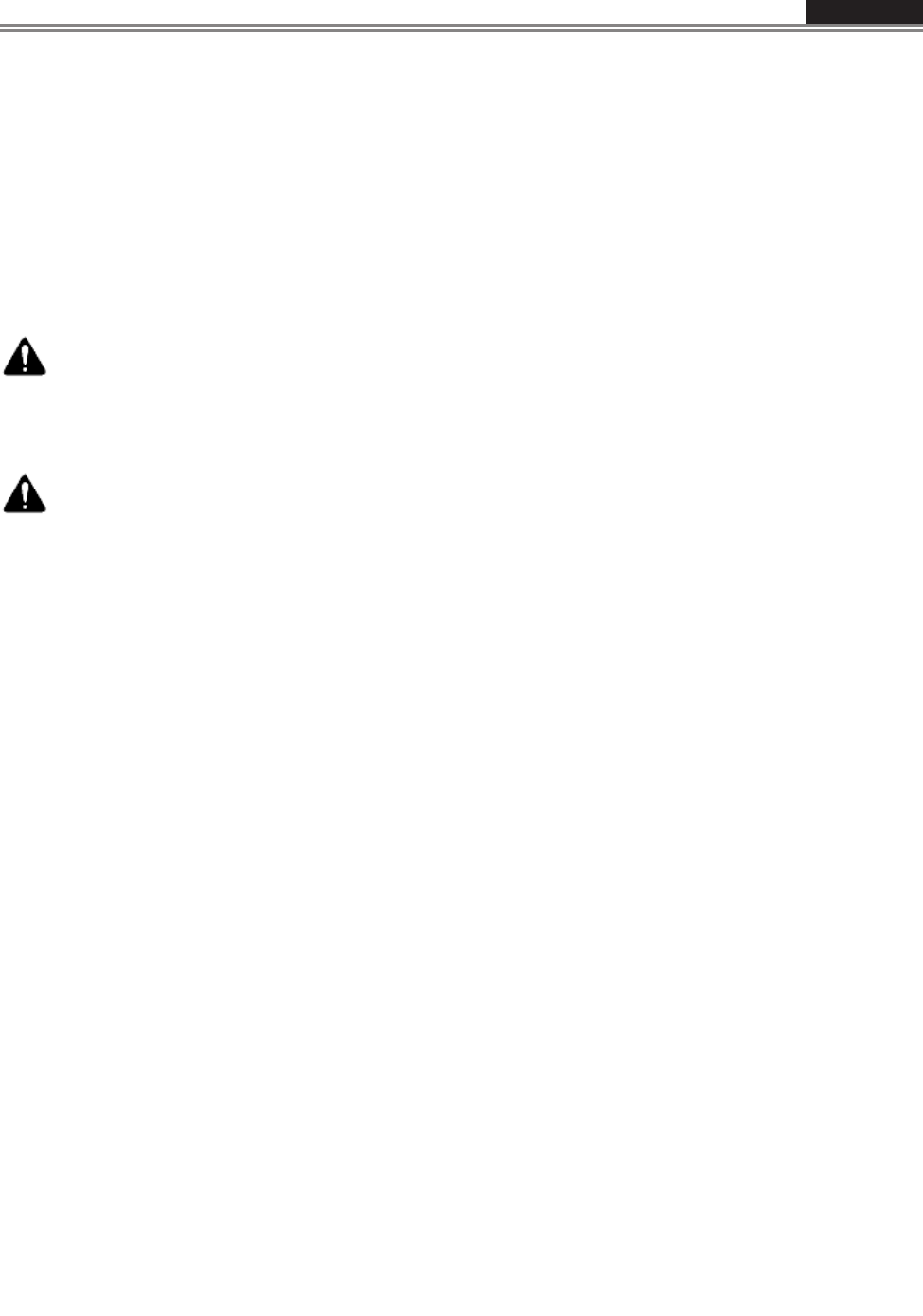
ENGLISH
Use & Care Manual
4
• Wear proper apparel. Loose tting garments or
hanging sleeves should never be worn while
cooking.
• Neverletclothing,potholders,orotherammable
materialscomeincontactwithhotburnersorhot
burnergrates.
• Use only certain types of glass, heatproof glass
ceramic, ceramic, earthenware, or other glazed
utensilsthataresuitableforcooktopuse.
• Donotcleanthecooktopwhileitisstillhot.Some
cleanersproducenoxiousfumeswhenappliedto
ahotsurface.
CAUTION
DOnotallowaluminiumfoil,plastic,paperorcloth
tocomeincontactwithhotburnersorgrates.Donot
allowpanstoboildry.
CAUTION
• Do not store items of interest to children above
the appliance. If children should climb onto the
appliance to reach these items, they could be
seriouslyinjured.
Toreducetheriskofreintheovencavity:
1.Donotstoreammablematerialsinornearthe
oven.
2.Donotusewateronagreasere.Smotherreor
useadrychemicalorfoam-typeextinguisher.
3.Itishighlyrecommendedthatareextinguisher
bereadilyavailableandhighlyvisiblenexttoany
cookingappliance.
4. Donotovercookfood.Carefullyattendovenif
paper, plasticorothercombustiblematerialsare
placedinsidetheoven.
5.Donotusethecavityforstoragepurposes.Donot
leavepaperproducts,cookingutensilsorfoodin
thecavitywhennotbeingused.
6. Ifmaterialsinsidetheovenshouldignite,keep
ovendoorclosed.Turn ovenoff anddisconnect
thecircuitatthecircuitbreakerbox.
7.Donotblockanyventopenings.
8.Besuretheblowerfanrunswhenevertheovenis
inoperation.Ifthefandoesnotoperate,donotuse
theoven.Callanauthorizedservicecenter.
9.Forpersonalsafety,wearproperclothing.Loose
ttingorgarmentswithhangingsleevesshould
neverbewornwhileusingthisappliance.

ENGLISH
Use & Care Manual
5
Safety for the Cooktop
Use Proper Pan Size
• Thisapplianceisequippedwithoneormoresurface
units of different size. Select utensils having at
bottoms large enough to cover the surface unit
heating element. The use of undersized utensils
will expose a portion of the heating element to
directcontactandmayresultinignitionofclothing.
Proper relationship of utensil to burner will also
improveefciency.
GlazedCookingUtensils
• Onlycertaintypesofglass,glass/ceramic,ceramic,
earthenware,orotherglazedutensilsaresuitable
forrange-topservicewithoutbreakingduetothe
suddenchangeintemperature.
UtensilHandlesShouldBeTurnedInwardand
NotExtendOverAdjacentSurfaceUnits
• Toreducetheriskofburns,ignitionofammable
materials,andspillageduetounintentionalcontact
withtheutensil,thehandleofautensilshouldbe
positionedsothatitisturnedinward,anddoesnot
extendoveradjacentsurfaceunits.
Do Not Cook on Broken Cook-Top
• If cook-top should break, cleaning solutions and
spilloversmaypenetratethebrokencooktopand
createariskofelectricshock.Contactaqualied
technicianimmediately.
Clean Cook-Top With Caution
• Ifawetspongeorclothisusedtowipespillsona
hotcookingarea,becarefultoavoidsteamburn.
Some cleaners can produce noxious fumes if
appliedtoahotsurface.
Safety for the Oven
● Tielonghairsothatitdoesn’thangloose.
● Donottouchheatingelementsorinteriorsurfaces
ofoven.
● The heatingelementsmaybehoteventhough
theyaredarkincolor.Interiorsurfacesofanoven
becomehotenoughtocauseburns.
● Duringandafteruse,donottouchorletclothing
orotherammablematerialscontacttheheating
elementsortheinteriorsurfacesoftheoven
untiltheyhavehadsufcienttimetocool.Other
surfacesoftheappliancemaybecomehot
enoughtocauseburns-amongthesesurfaces
are(identicationofsurfaces-forexample,oven
ventopeningsandsurfacesneartheseopenings,
ovendoors,andwindowsofovendoors).
● The trimonthetopandsidesoftheovendoor
maybecomehotenoughtocauseburns.
● Usecarewhenopeningthedoor.Openthedoor
slightlytolethotairorsteamescapebefore
removingorreplacingfood.
● Donotheatunopenedfoodcontainers.Build-up
ofpressuremaycausethecontainertoburstand
causeinjury.
● Alwaysplaceovenracksindesiredlocationwhile
oveniscool.Ifarackmustbemovedwhileoven
ishot,donotletpotholdercontactthehotheating
elements.
● Useonlydrypotholders.Moistordamppot
holdersonhotsurfacesmayresultinburnsfrom
steam.Donotletpotholdertouchhotheating
elements.Donotuseatowelorotherbulkycloth.
IMPORTANT
General Appliance and Range
Safety Instructions
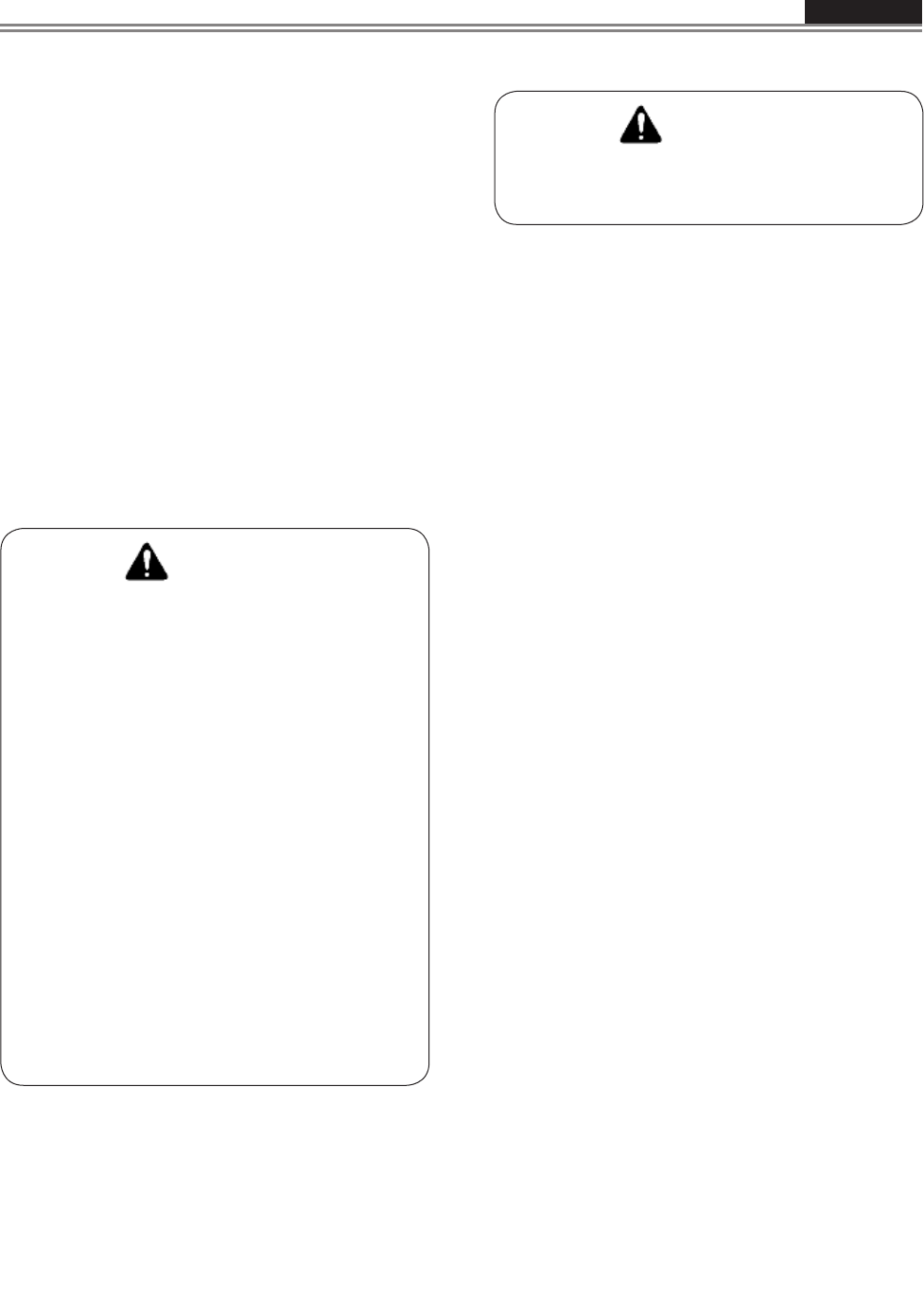
ENGLISH
Use & Care Manual
6
Safety for the Self-Cleaning Oven
• Conrmthatthedoorlocksandwillnotopenonce
bothselectorsareinCLEANpositionandthedoor
lockiconappears.Ifthedoordoesnotlock,turn
the cook mode selector to OFF and do not run
Self-Clean.PhoneforService.
• Do notcleanthedoorgasket.Itisessentialfor
agoodseal.Careshouldbetakennottorub,
damage,moveorremovethedoorgasket.
• Donotusecommercialovencleanersorovenliner
protectivecoatingsofanykindinoraroundany
partoftheoven.
• Cleanonlyovenpartslistedinthismanual.
• Beforeself-cleaningtheoven,removethebroiler
pan,ovenracks(onlywhennotmadeofporcelain),
otherutensilsandexcesssoftspillage.
WARNING
The elimination of soil during self-cleaning
generatessomeby-productswhichareonthis
list of substances.
To minimize exposure to these substances,
always operate this oven according to the
instructionsinthismanualandprovidegood
ventilationtotheroomduringandimmediately
after self-cleaning the oven.
The California Safe Drinking Water and Toxic
Enforcement Act requires the Governor of
California to publish a list of substances known
to the State of California to cause cancer, birth
defects,orotherreproductiveharm,andrequires
businessestowarnofpotentialexposuretosuch
substances.
This product contains a chemical known to the
StateofCaliforniatocausecancer,birthdefects,
orotherreproductiveharm.
This appliance can cause low-level exposure to
someofthesubstanceslisted,includingbenzene,
formaldehyde, carbon monoxide, toluene, and
soot.
Warnings for Electric Installation
WARNING
Installation and service must be performed by
a qualied installer, service agency or the gas
supplier.
CAUTION
• Alwaysdisconnecttheelectricalplugfromthewall
receptaclebeforeservicingthisunit.
• For personal safety, this appliance must be
properlygrounded.
• Donotunderanycircumstancescutorremovethe
third(ground)prongfromthepowercordplug.
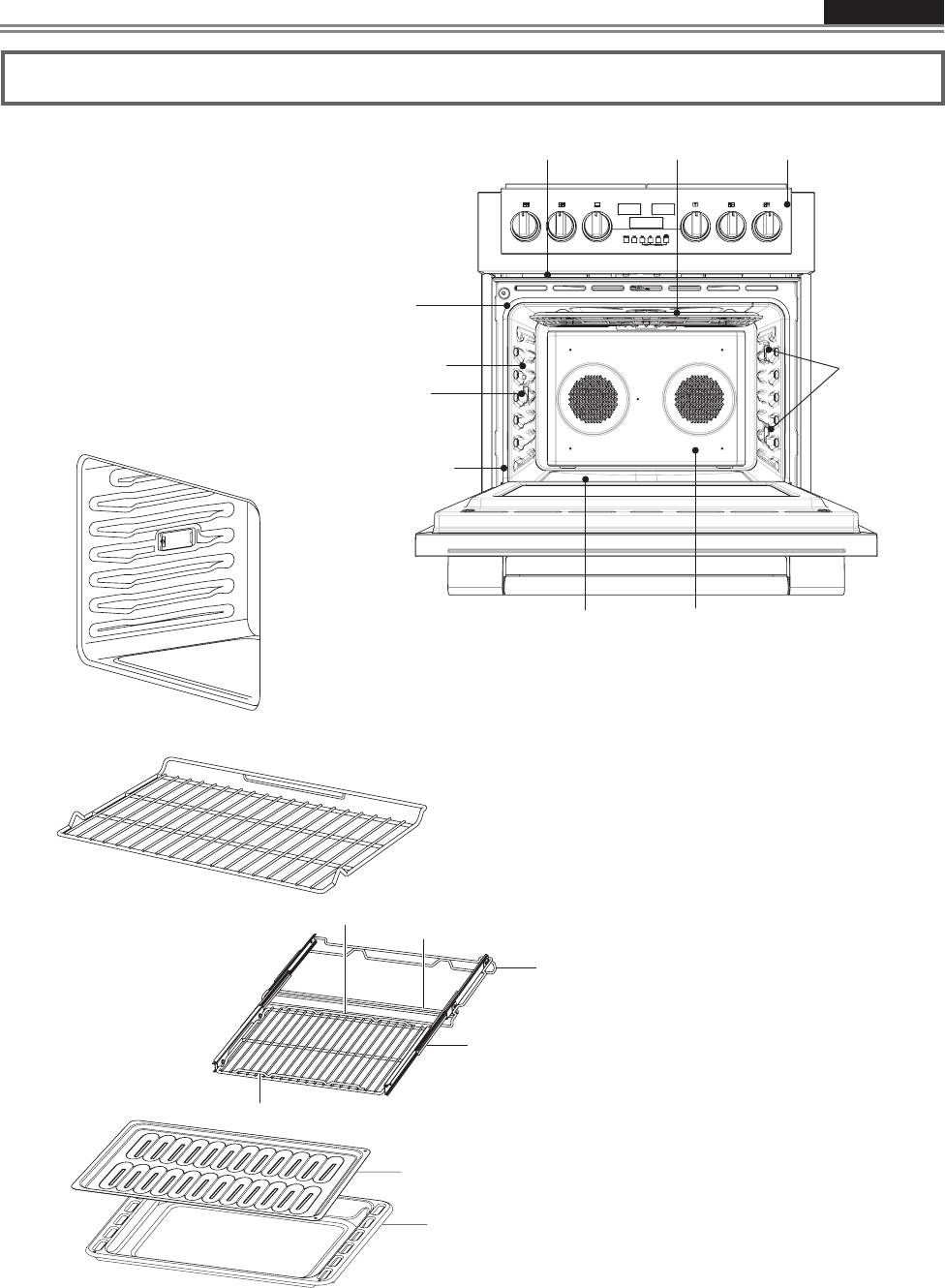
ENGLISH
Use & Care Manual
7
Level rack of cavity
Embossed
4
6
5
3
2
1
BroilerPan Racks
Extendable Rack
(if present) Stop
Pan Stop
BottomFrame
Slide Arm
Handle
Oven RackFront
Oven Rack Back
BroilerPan
Control panel
Halogen
Light
Broil ElementCooling Vents
Door
gasket
Meat probe
(if present)
Halogen
Ligh
Model and
Serial # Plate
Bottom Element
(not visible)
Convection Fan and
Element (not visible)
Features of your Oven
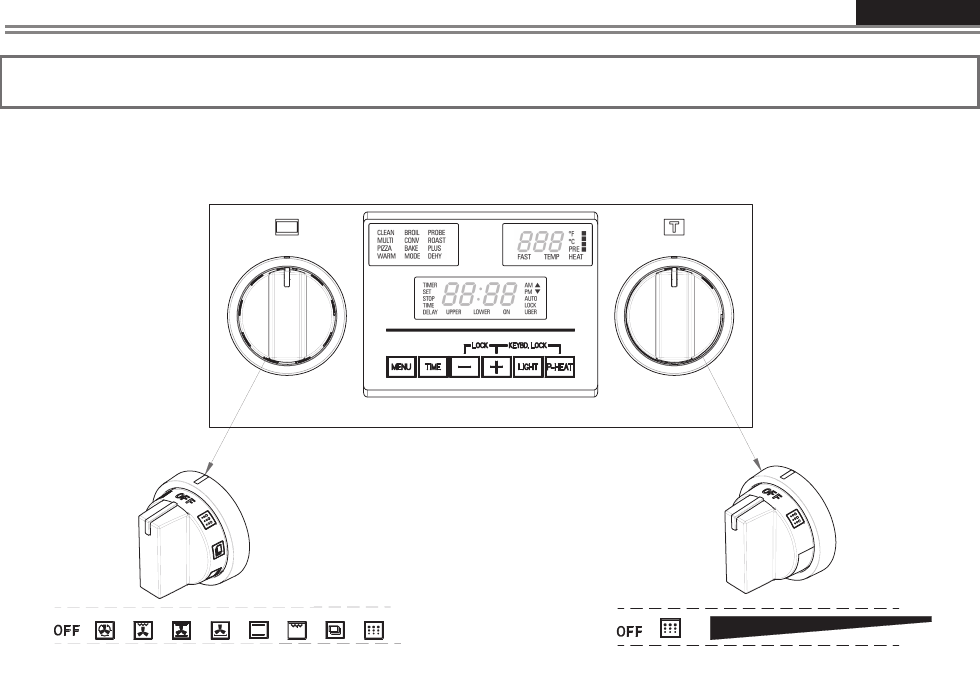
ENGLISH
Use & Care Manual
8
The Control Panels
The user interface has the following features: display, preheat light indicators, keys for commands, cooking mode
and temperature selectors.
SINGLE OVEN
DOUBLE OVEN
Command Keys
- [INC] key to increase the value.
- [DEC] key to decrease the value.
[FAST PREHEAT] When a cooking function has been
selected, touch this key to enable the fast preheat
mode. The fast preheat is not available for all functions.
[OPTIONS] Touch this key to enable special functions,
low temperature modes or to enter special menu.
[LIGHT]: Touch to switch the oven lights status.
Display
Central Display for time and miscellaneous
functions: for time of day, minute minder, automatic
cooking. AM/PM indication is also present.
Miscellaneous indications are also available to show
which cavity is currently selected and whether any
door has been locked, automatically for self-clean or
manually by the user.
Display for Temperature indications: Degree
unit (°C or °F) indication is present. It shows the
temperature set-point for the current cooking mode, in
the selected cavity.
Display with writings for Cooking Modes
indication to indicate which function has been
selected.
Knobs
Cooking mode selector (multifunction), with eight
cooking modes + OFF position.
Cooking mode selector (thermal), with three
cooking modes + OFF position.
Temperature selector with PRESET and CLEAN
positions + continuous range between MIN and MAX
values.
[TIME]: touch this key until “SET TIME” appears to set or
change the time of day. Touch this key until “TIMER”
appears to set, modify or clear the minute minder value.
Once a cooking function has been selected, touch this
key until “TIME” appears in order to set, modify or cancel
the cooking time. Touch this key until “STOP TIME”
appears in order to set, modify or cancel the end of
cooking time. Whenever one of the former modes has
been enabled and its digits flash, touch or hold:
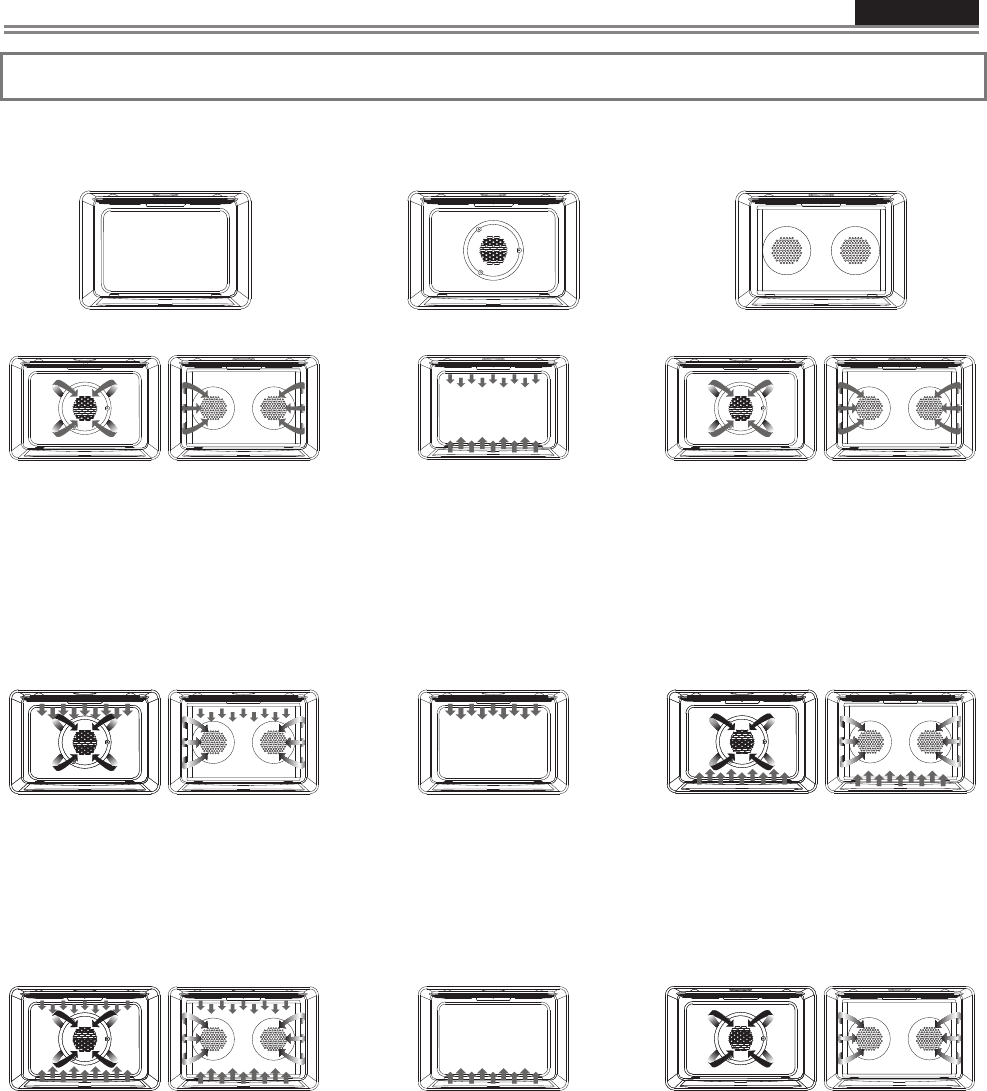
ENGLISH
Use & Care Manual
9
Oven Modes
The following illustrations give an overview of what happens in the oven with each mode setting. The arrows
represent the location of the heat sources during specific modes. The lower element is concealed under the oven
floor.
Thermal Cavity
Convection Cavity
Double Convection Cavity
Convection Bake (CONV BAKE)
Set temperature:
from 170 °F (75 °C) to 550 °F (290 °C)
(preset position 325 °F (165 °C)
Convection Bake cooks with heat
from a ring element behind the back
wall of the oven. The heat is
circulated throughout the oven by the
convection fan.
Bake (BAKE)
Set temperature:
from 170 °F (75 °C) to 550 °F (290 °C)
(preset position 350 °F (175 °C)
Is cooking with heated air. Both the
upper and lower elements cycle to
maintain the oven temperature.
Dehydrate (CONV DEHY)
Set temperature:
from 120 °F (50 °C) to 160 °F (70 °C)
(preset position 140 °F (60 °C)
Dehydrating is similar to convection
cooking but holds an optimum low
temperature while circulating the
heated air to remove moisture slowly
for food preservation.
Convection Broil (CONV BROIL)
Set temperature:
from 170 °F (75 °C) to 550 °F (290 °C)
(preset position 450°F(230°C)
Convection Broil combines the
intense heat from the upper element
with the heat circulated by the
convection fan.
Broil (BROIL)
Set temperature:
from L1 to L5
(preset position L3)
Broiling uses intense heat radiated
from the upper element.
Pizza (PIZZA)
Set temperature:
from 170 °F (75 °C) to 550 °F (290 °C)
(preset position 450 °F (232 °C)
Is a special cooking mode with
heated air. The lower elements cycle
to cook Pizza.
Convection Roast (CONV ROAST)
Set temperature:
from 170 °F (75 °C) to 550 °F (290 °C)
(preset position 325 °F(165 °C)
Convection Roast uses the upper
and lower elements and convection
fan.
Proof (WARM)
Set temperature:
from 80 °F (25 °C) to 120 °F (50 °C)
(preset position 100 °F (35 °C)
Warming (WARM PLUS)
Set temperature:
from 130 °F (55 °C) to 210 °F (100 °C)
(preset position 170 °F (75 °C)
Proof and Warming use the lower
elements to keep foods warm.
Defrost (CONV)
Does not used any heating element,
only the convection fan is used to
defrost foods.
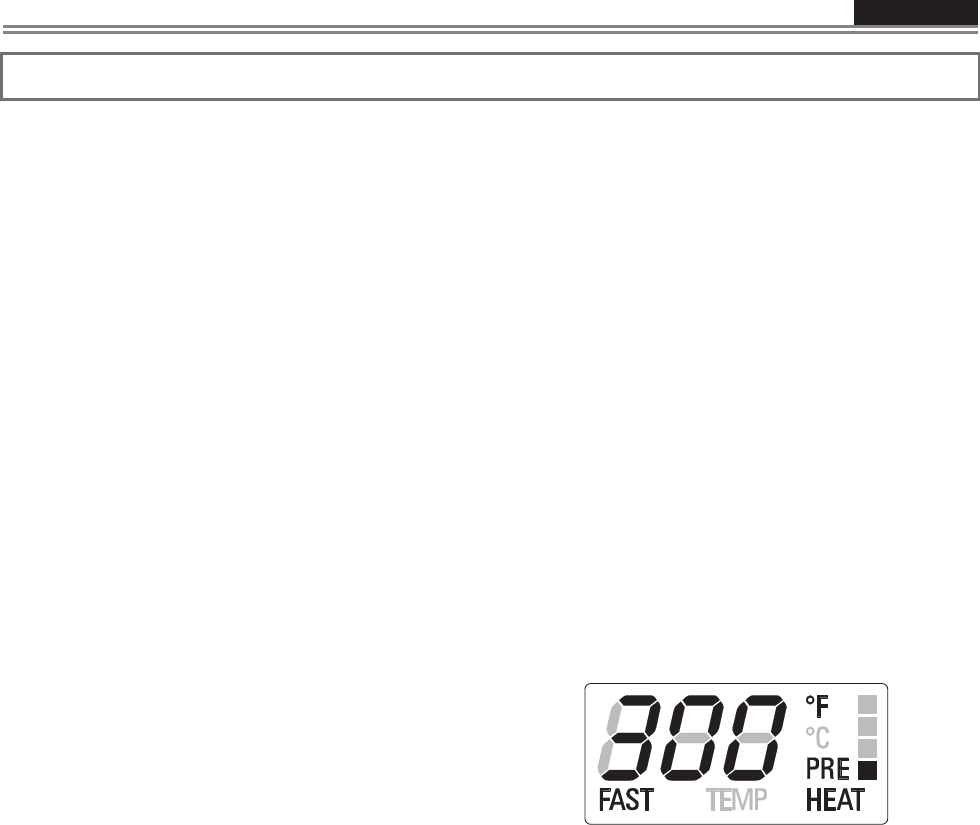
ENGLISH
Use & Care Manual
10
General Oven Information
Before using your oven for the first time remove all
packing and foreign materials from the oven(s). Any
material of this sort left inside may melt or burn when
the appliance is used.
Flashing Symbols or Numbers
Signals an incomplete action that is in progress (locking
the door, preheat, etc.) or an incomplete setting that
calls for another input.
Beeps
Signals that more information must be entered or
confirms the receipt of an entry. Beeps also signal the
end of a function or an oven fault.
It’s displayed steadily when the door is locked. The
symbol flashes when the latch is moving in order to lock
or unlock the door. Do not attempt to open the door at
this time. Door can be opened when the symbol no
longer appears. “AUTO LOCK” appears when the door
has been locked automatically due to self-clean mode.
“USER LOCK” is displayed when the door has been
locked manually by the user, for example to prevent
children from having free access to the oven cavity.
Hold both the [INC] and [DEC] keys for 3 seconds. The
latch will lock the door. Repeat the same operation to
unlock.
Locking the keyboard
Hold both the keys indicated by “KEYBD. LOCK” legend
for 3 seconds. Commands are now locked and “SENS
LOCK” will be displayed every time you touch any keys.
Repeat the same operation for 3 seconds to unlock the
keyboard.
Power Failure
After the power returns to the oven, the clock displays
the time 12.00AM.
Default Settings
The cooking modes automatically select a suitable
temperature when the selector is in the preset position.
These can be changed when a different one is needed.
It’s also possible to set a user option in order to save the
last used temperature per every cooking mode.
F Failure Number Codes
These codes are displayed when the electronic control
detects a problem in the oven or in the electronics.
Convection Fan
The convection fan operates during any convection
mode. When the oven is operating in the convection
mode, the fan will turn off automatically when the door
is opened. The convection fan always runs during the
preheat time.
Preheat and Fast Preheat
Whenever a cooking mode is set and the oven is
heating, the “PREHEAT” writing appears in the
temperature display: the vertical bar indicates, in four
steps, when the oven reaches the 25%, 50%, 75%,
100% of the set-point temperature.
As soon as the 100% is reached, the control sounds
an “end of preheat” tone and the “PREHEAT” writing
disappears.
When it’s necessary to heat up the oven rapidly, a
Fast Preheat mode is available: it uses the heating
elements and the convection fan in a special way, in
order to reduce the heating time as long as possible.
After having set one of the cooking functions for which
the fast preheat is available, touch the [FAST
PREHEAT] key, the “FAST” writing is shown in
addition to the “PREHEAT” one.
As soon as the set-point temperature is reached, the
control sounds an “end of preheat” tone and both
“FAST” and “PREHEAT” writings disappear. The oven
switches automatically to the desired cooking mode
that was previously set: put the food inside now.
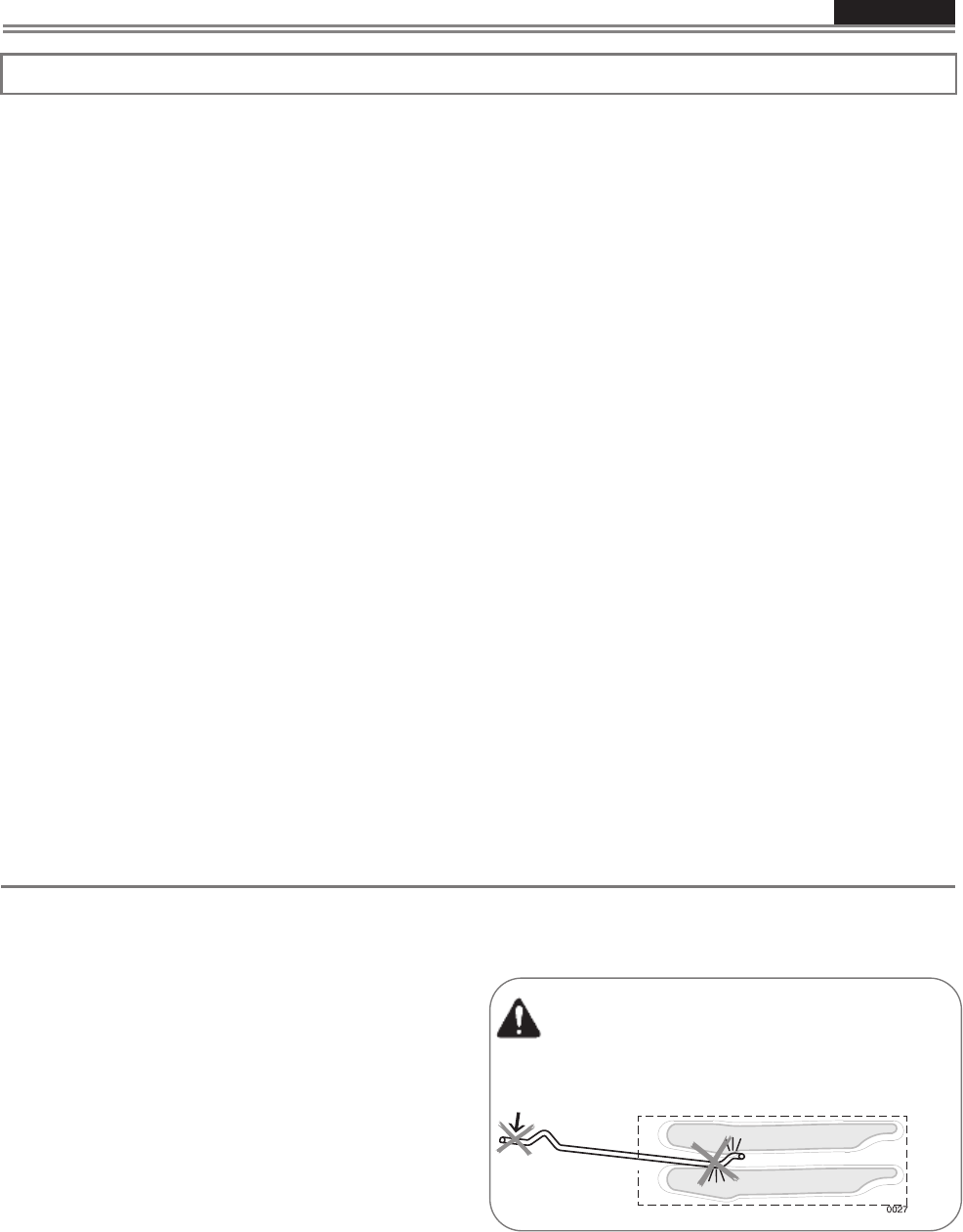
ENGLISH
Use & Care Manual
11
General Oven Tips
Preheating the Oven
x Preheat the oven when using the Bake, Convection
Bake and Convection Roast modes.
x Use Fast Preheat mode when a shorter time
is desired to preheat the oven.
x Selecting a higher temperature does not shorten
the preheat time.
x Preheating is necessary for good results when
baking cakes, cookies, pastry and breads.
x Preheating will help to sear roasts and seal in meat
juices.
x Place oven racks in their proper position before
preheating.
x During preheating, the selected cooking
temperature is always displayed.
x A beep will confirm that the oven is preheated and
the “PREHEAT” writing will turn off.
Operational Suggestions
x Use the cooking charts as a guide.
x Do not set pans on the open oven door.
x Use the interior oven lights to view the food through
the oven door window rather than opening the door
frequently.
Utensils
x Glass baking dishes absorb heat. Reduce oven
temperature 25°F (15°C) when baking in glass.
x Use pans that give the desired browning. The type
of finish on the pan will help determine the amount
of browning that will occur.
x Shiny, smooth metal or light non-stick / anodized
pans reflect heat, resulting in lighter, more delicate
browning. Cakes and cookies require this type of
utensil.
x Dark, rough or dull pans will absorb heat resulting
in a browner, crisper crust. Use this type for pies.
x For brown, crisp crusts, use dark non-stick /
anodized or dark, dull metal utensils or glass
bake ware. Insulated baking pans may increase
the length of cooking time.
x Do not cook with the empty broiler pan in the
oven, as this could change cooking performance.
Store the broil pan outside of the oven.
Oven Condensation and Temperature
x It is normal for a certain amount of moisture to
evaporate from the food during any cooking
process. The amount depends on the moisture
content of the food. The moisture may condense
on any surface cooler than the inside of the oven,
such as the control panel.
High Altitude Baking
x When cooking at high altitude, recipes and
cooking time will vary from the standard.
120/240 vs. 120/208 Volt Connection
x Most oven installations will have a 120/240
voltage connection.
x If your oven is installed with 120/208 voltage, the
preheat time may be slightly longer than with
120/240 voltage.
x The oven is designed to assure the same clean
time at 208V.
Oven Racks
x The oven has rack guides at six levels as shown in
the illustration on Page 7.
x Rack positions are numbered from the bottom rack
guide (#1) to the top (#6).
x Check cooking charts for best rack positions to use
when cooking.
x Each level guide consists of paired supports
formed in the walls on each side of the oven cavity.
x Always be sure to position the oven racks before
turning on the oven. Make sure that the racks are
level once they are in position.
Please refer to illustration on Page 7 if there is any
question as to which side is the front of the rack.
x The racks are designed to stop when pulled
forward to their limit.
CAUTION! Never use aluminum foil to cover the
oven racks or to line the oven. It can cause damage
to the oven liner if heat is trapped under the foil.
CAUTION
Make sure you do not force it to avoid damage to
the enamel.
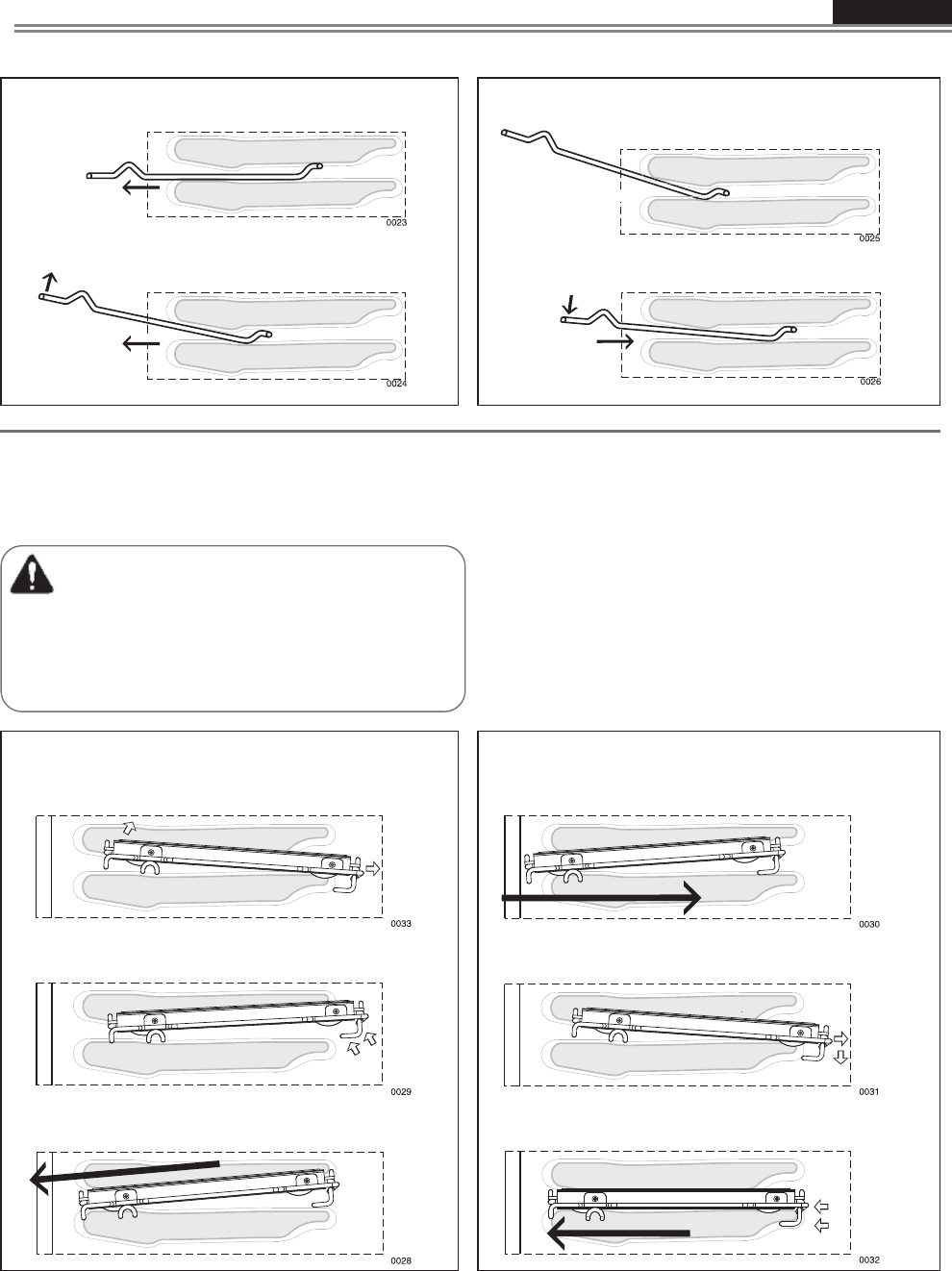
ENGLISH
Use & Care Manual
12
To remove oven rack from the oven:
1. Pull rack forward
2. Lift rack up at front and then remove it
To replace an oven rack:
1. Place rear of rack between rack level guides
2. While lifting front of rack, slide rack in all the
way while lowering the front
Oven Telescopic Racks
x The extendable rack allows for easier access to
cooking foods. It extends beyond the standard
flat rack bringing the food closer to the user.
CAUTION
When the rack is outside of the oven, slide arms do
not lock. They could unexpectedly extend if the rack
is carried incorrectly. Extending slide arms could
cause injury. Rack should only be held or carried
by grasping the sides.
NOTE: Always remove the extendable rack before
self-cleaning the oven.
CAUTION! To avoid burns, pull rack all the way out
and lift pan above handle when transferring food to
and from oven.
Please refer to illustration on Page 7 if there is any
question as to which side is the front of the rack.
To remove extendable rack from the oven:
1. Lift of rack slightly and push it until the stop
release
2. Raise back of rack until frame and stop clear
rack guide
3. Pull rack down and out
To replace an extendable rack:
1. Grasp rack firmly on both sides. Place rack
(including frame) above desired rack guide
2. Push all the way in until the back of the rack
drops into place
3. Pull both sections forward until stops activate.
Rack should be straight and flat, not crooked
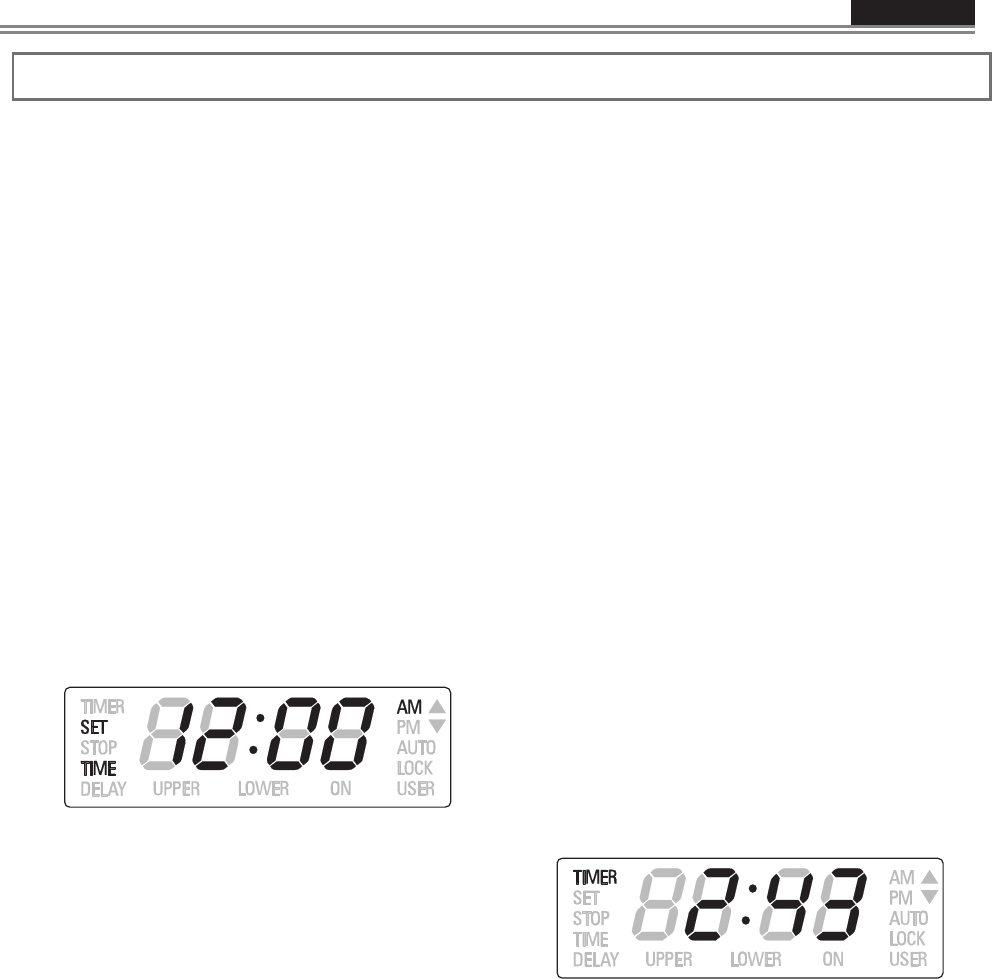
ENGLISH
Use & Care Manual
13
Setting the Clock and Timer
The time of day is displayed in hours and minutes.
Always set the clock immediately after installation or after a power failure. Once power returns to the oven, the
clock displays the time 12:00AM.
The clock time will appear during all oven operations except when there is the timer or any timed cooking
operations running.
The oven is preset to a 12-hour clock and indicates AM and PM.
To Set the Time of Day
1.
Touch [TIME] until the display shows the “SET
TIME” writing.
2.
Touch [INC] or [DEC] to set the desired time, the
hours will begin flashing: continue until the correct
hour value and AM or PM indication is selected.
3.
Touch [TIME] again to confirm the hour and minutes
will start flashing.
4.
Touch [INC] or [DEC] to set the desired minutes
value or hold the key to change by 10 minute steps.
5.
Touch [TIME] again or wait for 5 seconds in order to
confirm the time.
NOTE: The Time of Day can never be set if any time
function is already set: first delete all the active time
functions.
To Set the Timer
1.
Touch [TIME] until the display shows the
“TIMER” writing.
2.
Touch [INC] or [DEC] to set the desired timer
value, the hours will begin flashing: continue until
the desired value is set.
3.
Touch [TIME] again to confirm the hour and
minutes will start flashing.
4.
Touch [INC] or [DEC] to set the desired minutes
value or hold the key to change by 10 minute
steps.
5.
Touch [TIME] again or wait for 5 seconds in order
to confirm the time.
6.
“TIMER” will be steadily displayed.
7.
When the time ends, reminder beeps will sound
for 15 minutes or until the [TIME] key is pressed.
8.
Timer format is usually HR:MIN, switching into
MIN:SEC during the last minute.
9.
The displayed value is always rounded to the
lower minute.
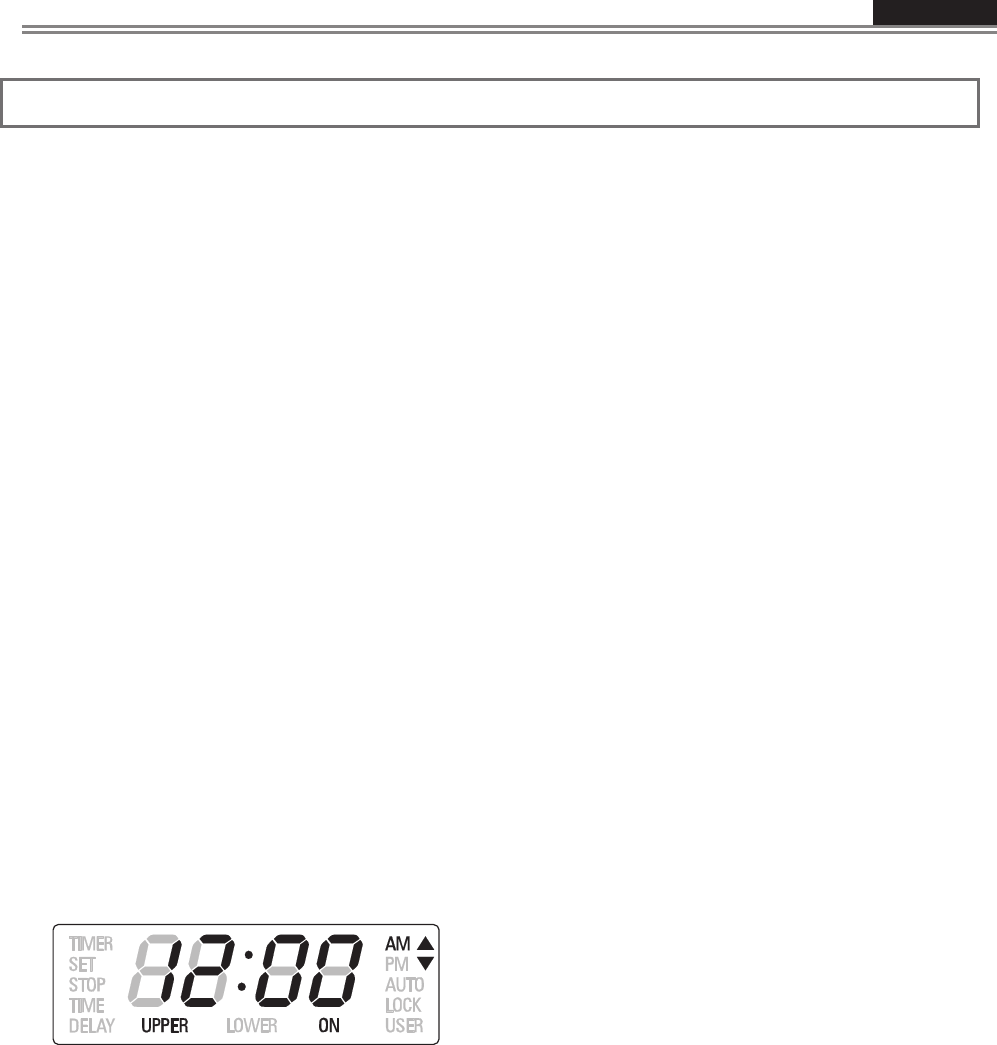
ENGLISH
Use & Care Manual
14
Selecting the Oven Mode
Setting Cooking Mode and Temperature
x The following modes can be selected by moving the
cooking mode knob to the desired position. To
select Clean, the temperature knob must be moved
into the appropriate Clean position too.
OFF
CONVECTION BAKE (CONV BAKE)
CONVECTION BROIL (CONV BROIL)
CONVECTION ROAST (CONV ROAST)
PIZZA (MULTI PIZZA)
BAKE (BAKE)
BROIL (BROIL)
DEHYDRATE(CONV DEHY)
PROOF (WARM)
DEFROST (CONV)
WARMING (WARM PLUS)
CLEAN
x Select the desired temperature by moving the selector
or leave it in the PRESET position if the proposed
value is fine. The temperature can be changed by
5°F or 5°C steps.
x Cavity will begin to heat, the “ON” writing is
displayed when the selected oven is active, oven
lights will turn on.
x “PREHEAT” writing will turn on. Once the oven has
preheated, it will beep and switch the writing off.
x To change the temperature while cooking, simply
turn the temperature knob until the display shows
the desired value.
x Move the cooking mode selector to OFF if you
intend to stop cooking.
x The triangles in the upper right corner of the display
are active when a cavity is running, even if it is not
selected on the display.
Using [OPTIONS] key to select low
temperature functions
DEHYDRATE (CONV DEHY)
PROOF (WARM)
DEFROST (CONV)
WARMING (WARM PLUS)
x Touch [OPTIONS] key to toggle between these
four modes.
x The last used is kept in memory for the next
selection.
Using Oven Lights
x A single light key activates the lights.
x Oven lights turn on and off automatically when the
door is opened and closed.
x When an oven is in use, oven lights turn on
automatically when a mode is started. Oven lights
will turn off automatically when the oven mode is
cancelled.
x The lights do not operate in the Self-Clean mode.
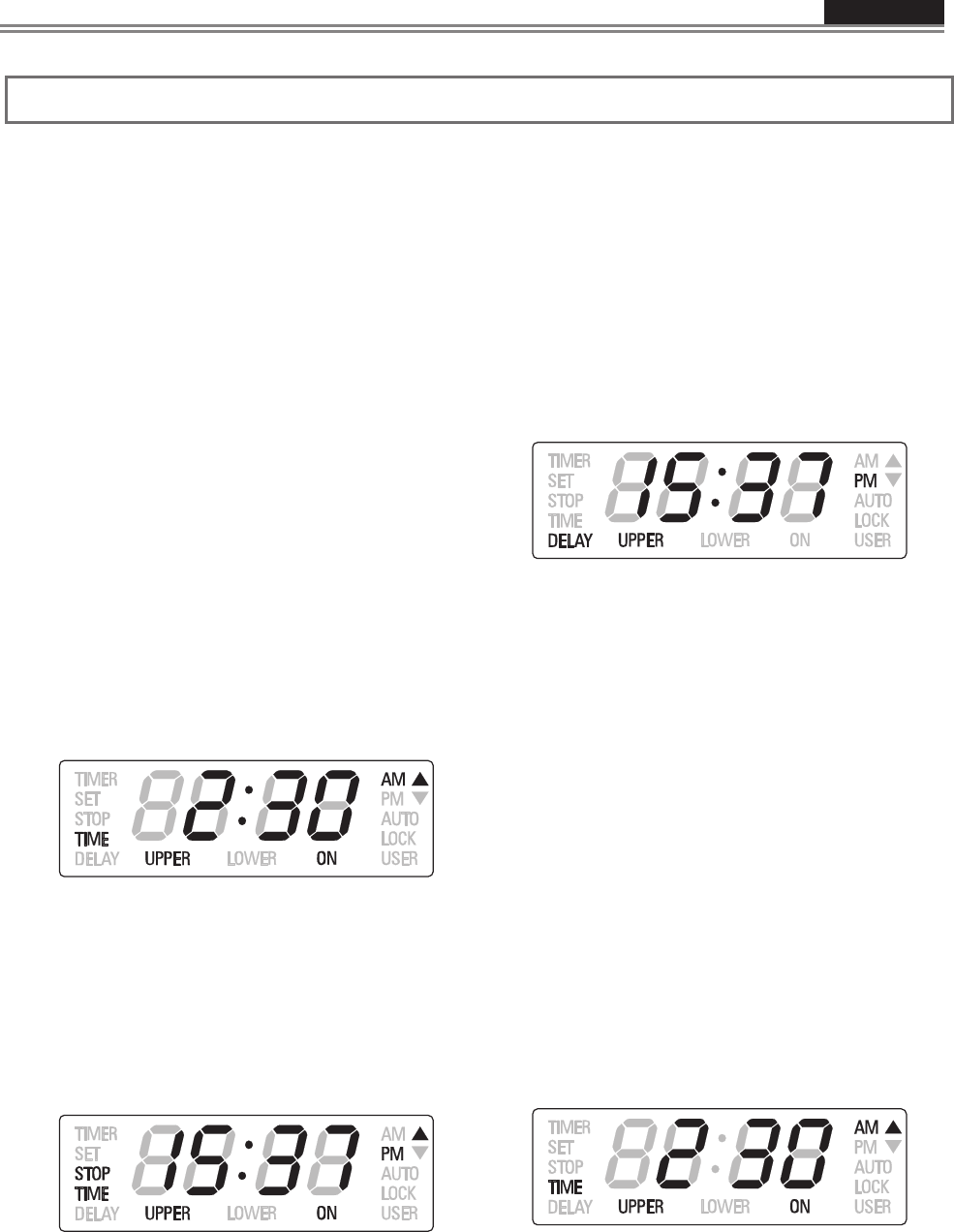
ENGLISH
Use & Care Manual
15
Time Oven Mode Operation
x Be sure that the time-of-day clock is displaying the
correct time.
x The timed mode turns off the oven at the end of the
cook time.
To Set a Timed Mode
1.
2.
Select the cooking mode and the temperature by
means of the knobs. The “ON” writing will appear in
the display.
3.
Touch [TIME] key until the “TIME” writings will
appear in the display.
4.
Touch [INC] or [DEC], the hour digits will begin
flashing. Continue to set the desired cooking time.
Keep in mind that the time required for the oven to
reach the temperature must be included in the set
cooking time.
5.
Touch [TIME] again, the hours will be confirmed
and the minute digits will begin flashing.
6.
Touch [INC] or [DEC] to change the minutes. Hold
the key to change by 10 minutes steps. Continue to
set the desired cooking time.
Touch [TIME] once again or wait for a few seconds
to confirm the cooking time value.
To Delay the Start of a Timed Mode
Follow steps 1 through 6 or 7 above.
x Touch [TIME] key until “STOP TIME” will appear in
the display.
x The control automatically calculates and displays the
initial value, adding the cooking time already set to
the time of day.
x Touch [INC] or [DEC], the hour digits will begin
flashing. Continue to set the desired stop time.
x Touch [TIME] again, the hours will be confirmed
and the minute digits will begin flashing.
x Touch [INC] or [DEC] to change the minutes. Hold
the key to change by 10 minutes steps. Continue
to set the desired stop time.
x Touch [TIME] once again or wait for a few
seconds to confirm the stop time value.
x The clock automatically calculates the time of day
at which the mode starts and stops. The “DELAY”
writing is displayed until the starting time is
reached.
When a Timed Mode is running
x As soon as the oven actually starts cooking, the
display shows the cooking time and counts down
by one minute steps. The oven will cook for the
programmed time.
x When the time expires, the oven automatically
turns off, the writings “ON” and “TIME” start
flashing and an “end of activity” beep sequence
sounds. Reminder beeps will sound for up to
fifteen minutes until any key is touched in order to
recall the user attention.
How to check a time value
x Whenever it’s necessary to check a time value
that is not displayed, touch the [TIME] key until the
proper writing is displayed to view the desired
value for 5 seconds.
x Example: if the timer value is displayed and you
want to check the cooking time, touch the [TIME]
key until “TIME” is displayed to view the cooking
time for 5 seconds.
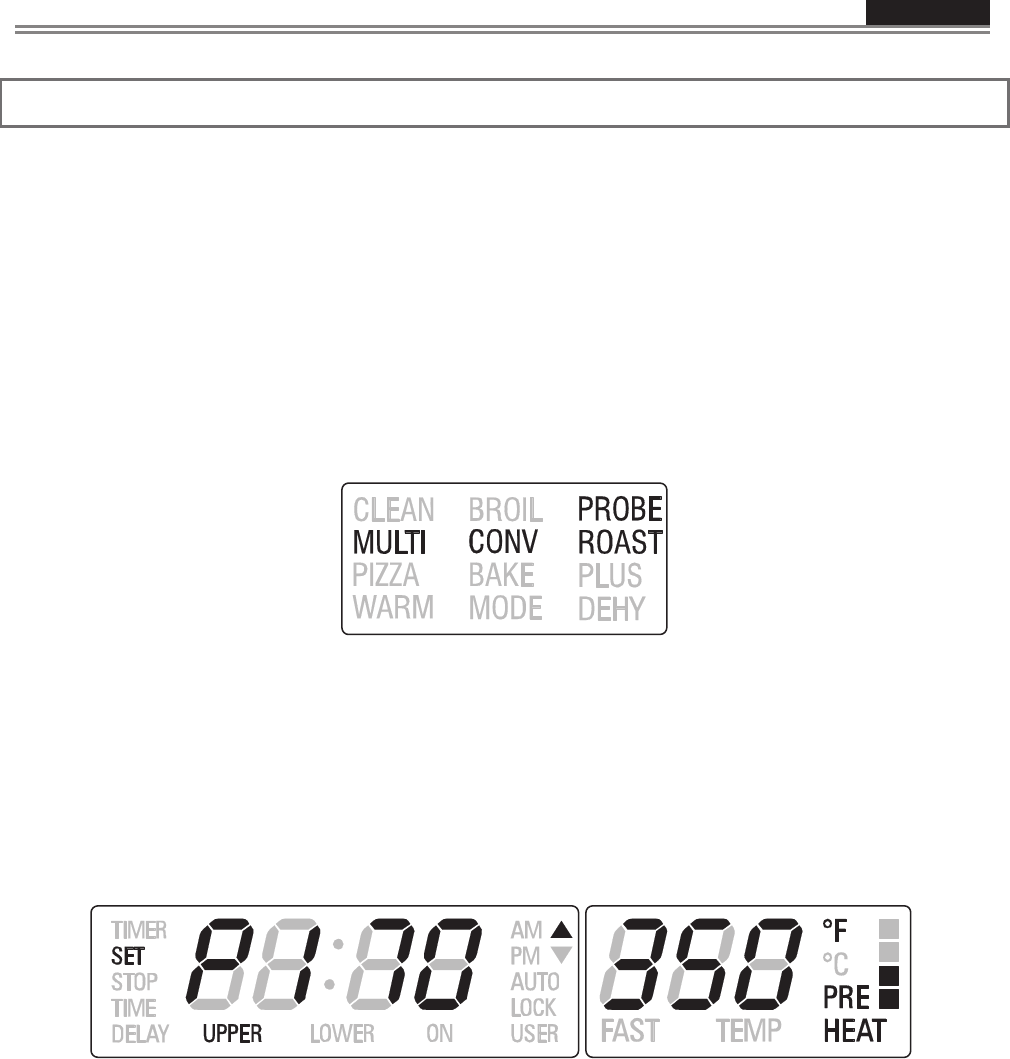
ENGLISH
Use & Care Manual
16
Setting the meat probe options
This oven is optionally provided with the meat probe
feature to sense the temperature inside meat and stop
cooking as soon as the set value is reached.
The following modes can be selected to work with the
meat probe:
CONVECTION BAKE
CONVECTION ROAST
BAKE
Other modes are not allowed to start if the probe is
inserted.
Once the probe has been inserted in its receptacle and
detected by the control, turn the cooking mode knob into a
valid position, the PROBE writing appears on the cooking
mode display with the selected function.
The meat probe standard temperature (170°F) flashes on
the clock module for 5 seconds. Using the [INC]/[DEC]
keys, it’s possible to change the probe set. The standard
probe temperature set-point is 170°F. The allowed range
is between 130°F and 210°F. The maximum cavity
temperature during cooking with meat probe is 475°F.
The resolution must be 5°F or 2.5°C both for set and
actual temperature.
After 5 seconds the value on the display is accepted and
the control starts cooking. The actual probe temperature
is now displayed.
Touch [INC] or [DEC] once to check the probe set
temperature. When it’s flashing touch it further or hold to
modify the value. As soon as the set probe temperature
is reached, the control sounds an end of cooking tone
and stops the oven.
Always turn the cooking mode in the OFF position before
re-using the oven.
The PROBE writing flashes when the mode is not valid for
cooking with probe. If the probe is removed during
cooking, or in case of a short or open circuit, a fault
message will be displayed.
Automatic time functions are disabled when using the
meat probe, only the timer can work.
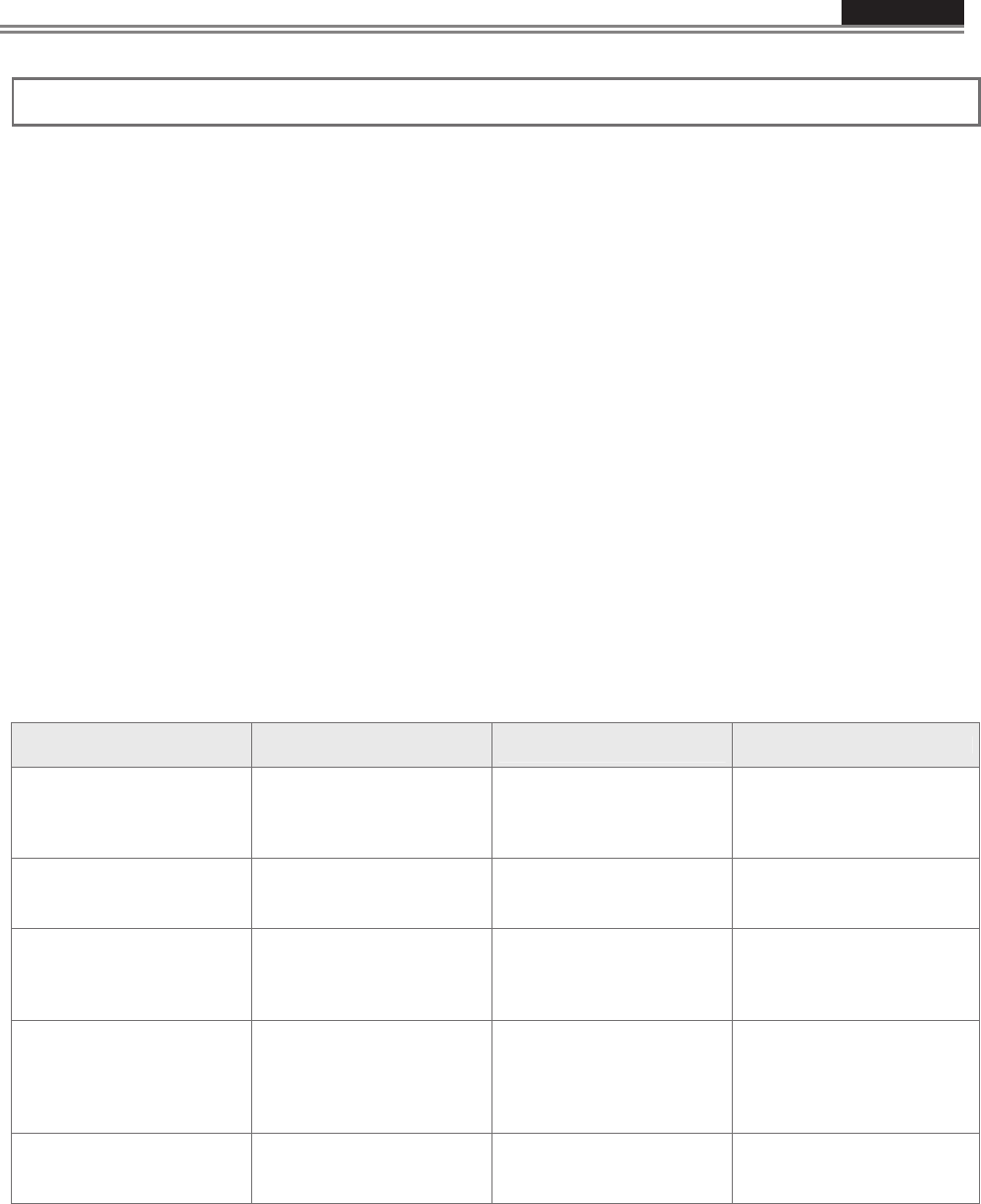
ENGLISH
Use & Care Manual
17
Bake Tips and Techniques
Baking is cooking with heated air. Both upper and
lower elements in the oven are used to heat the air
but no fan is used to circulate the heat.
Follow the recipe or convenience food directions for
baking temperature, time and rack position. Baking
time will vary with the temperature of ingredients and
the size, shape and finish of the baking utensil.
General Guidelines
x For best results, bake food on a single rack with
at least 1" - 1 ½” (2,5 - 3cm) space between
utensils and oven walls.
x Use one rack when selecting the bake mode.
x Check for doneness at the minimum time.
x Use metal bake ware (with or without a non stick
finish), heatproof glass, glass-ceramic, pottery or
other utensils suitable for the oven.
x When using heatproof glass, reduce temperature
by 25°F (15°C) from recommended temperature.
x Use baking sheets with or without sides or jelly roll
pans.
x Dark metal pans or nonstick coatings will cook
faster with more browning. Insulated bake ware will
slightly lengthen the cooking time for most foods.
x Do not use aluminum foil or disposable aluminum
trays to line any part of the oven. Foil is an
excellent heat insulator and heat will be trapped
beneath it. This will alter the cooking performance
and can damage the finish of the oven.
x Avoid using the opened door as a shelf to place
pans.
x Tips for Solving Baking Problems are found on
Page 25.
Bake Chart
FOOD ITEM RACK POSITION TEMP. °F (°C)
(PREHEATED OVEN) TIME (MIN)
Cake
Cupcakes 2 350 (175) 19-22
Bundt Cake 1 350 (175) 40-45
Angel Food 1 350 (175) 35-39
Pie
2 crust, fresh, 9" 2 375-400 (190-205) 45-50
2 crust, frozen fruit, 9" 2 375 (190) 68-78
Cookies
Sugar 2 350-375 (175-190) 8-10
Chocolate Chip 2 350-375 (175-190) 8-13
Brownies 2 350 (175) 29-36
Breads
Yeast bread loaf, 9x5 2 375 (190) 18-22
Yeast rolls 2 375-400 (190-205) 12-15
Biscuits 2 375-400 (190-205) 7-9
Muffins 2 425 (220) 15-19
Pizza
Frozen 2 400-450 (205-235) 23-26
Fresh 2 475 (246) 15-18
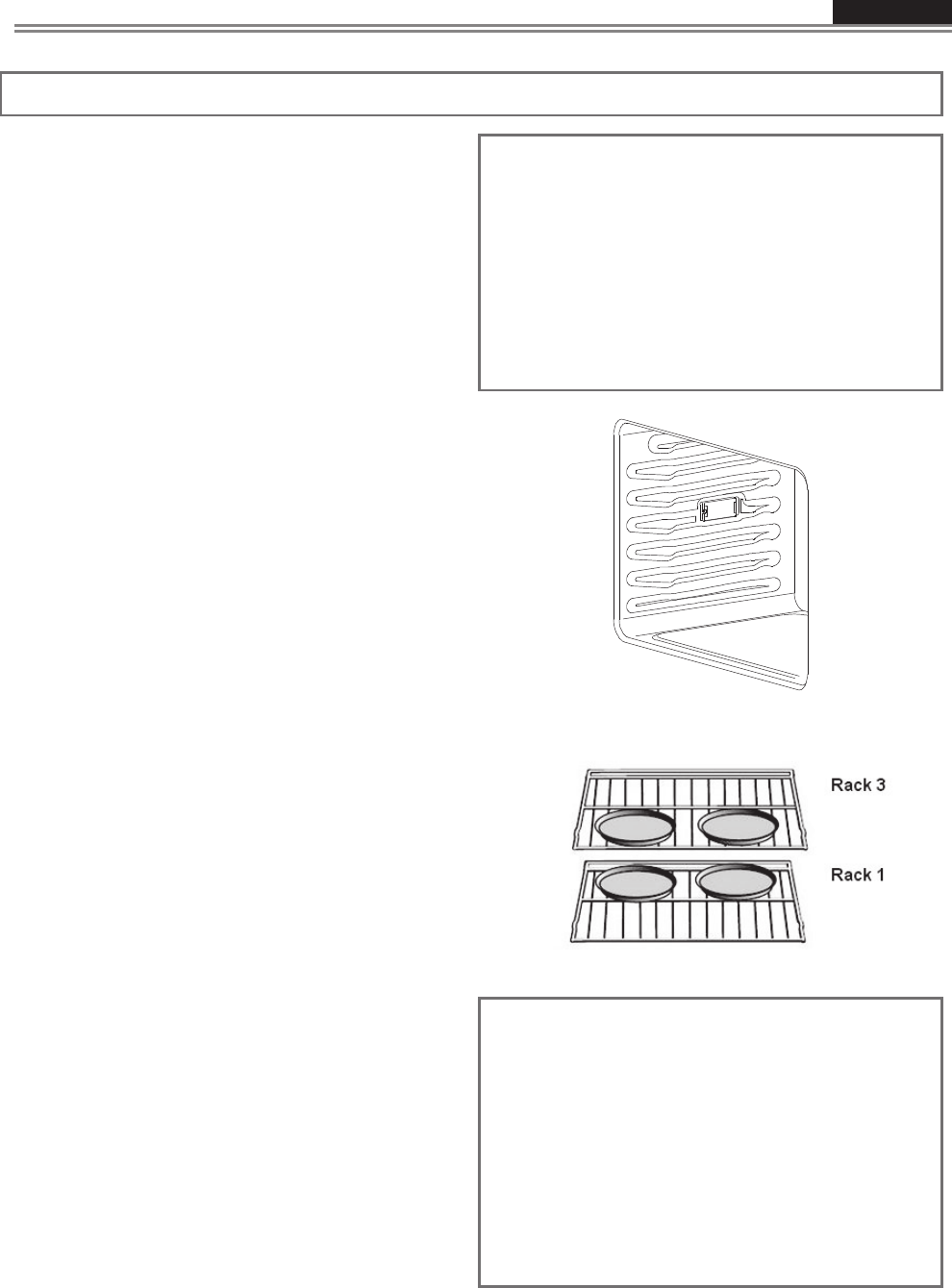
ENGLISH
Use & Care Manual
18
Convection Bake Tips and Techniques
Foods recommended for
Convection Bake mode:
Appetizers Biscuits Coffee Cakes
Cookies (2 to 4 racks) Yeast Breads
Cream Puffs
Popovers
Casseroles and One-Dish Entreés
Oven Meals (rack positions 1, 2, 3)
Air Leavened Foods (Soufflés, Meringue, Meringue-
Topped Desserts, Angel Food Cakes, Chiffon Cakes)
4
6
5
3
2
1
Rack position
Multiple rack pan placement
Reduce recipe baking temperatures by 25°F (15°C).
x For best results, foods should be cooked
uncovered, in low-sided pans to take advantage of
the forced air circulation. Use shiny aluminum pans
for best results unless otherwise specified.
x Heatproof glass or ceramic can be used. Reduce
temperature by another 25°F (15°C) when using
heatproof glass dishes for a total reduction of 50°F
(30°C).
x Dark metal pans may be used. Note that food may
brown faster when using dark metal bake ware.
x The number of racks used is determined by the
height of the food to be cooked.
x Baked items, for the most part, cook extremely well
in convection. Don’t try to convert recipes such as
custards, quiches, pumpkin pie , or cheesecakes,
which do not benefit from the convection-heating
process. Use the regular Bake mode for these
foods.
x Multiple rack cooking for oven meals is done on
rack positions 1, 2, 3 , 4 and 5. All five racks can be
used for cookies, biscuits and appetizers.
- 2 Rack baking: Use positions 1 and 3.
- 3 rack baking: Use positions 2, 3 and 4 or 1, 3 and
5.
- When baking four cake layers at the same time,
stagger pans so that one pan is not directly above
another. For best results, place cakes on front of
upper rack and back of lower rack (See graphic at
right). Allow 1" - 1 ½” (2,5 - 3cm).air space around
pans.
x Converting your own recipe can be easy. Choose a
recipe that will work well in convection.
x Reduce the temperature and cooking time if
necessary. It may take some trial and error to
achieve a perfect result. Keep track of your
technique for the next time you want to prepare the
recipe using convection.
x Tips for Solving Baking Problems are found on
Page 25.
Quick and easy recipe tips
Converting from standard BAKE
to CONVECTION BAKE:
x Reduce the temperature by 25°F (15°C).
x Use the same baking time as Bake mode if
under 10 to 15 minutes.
x Foods with a baking time of less than 30
minutes should be checked for doneness 5
minutes earlier than in standard bake recipes.
x If food is baked for more than 40 to 45
minutes, bake time should be reduced by 25%.
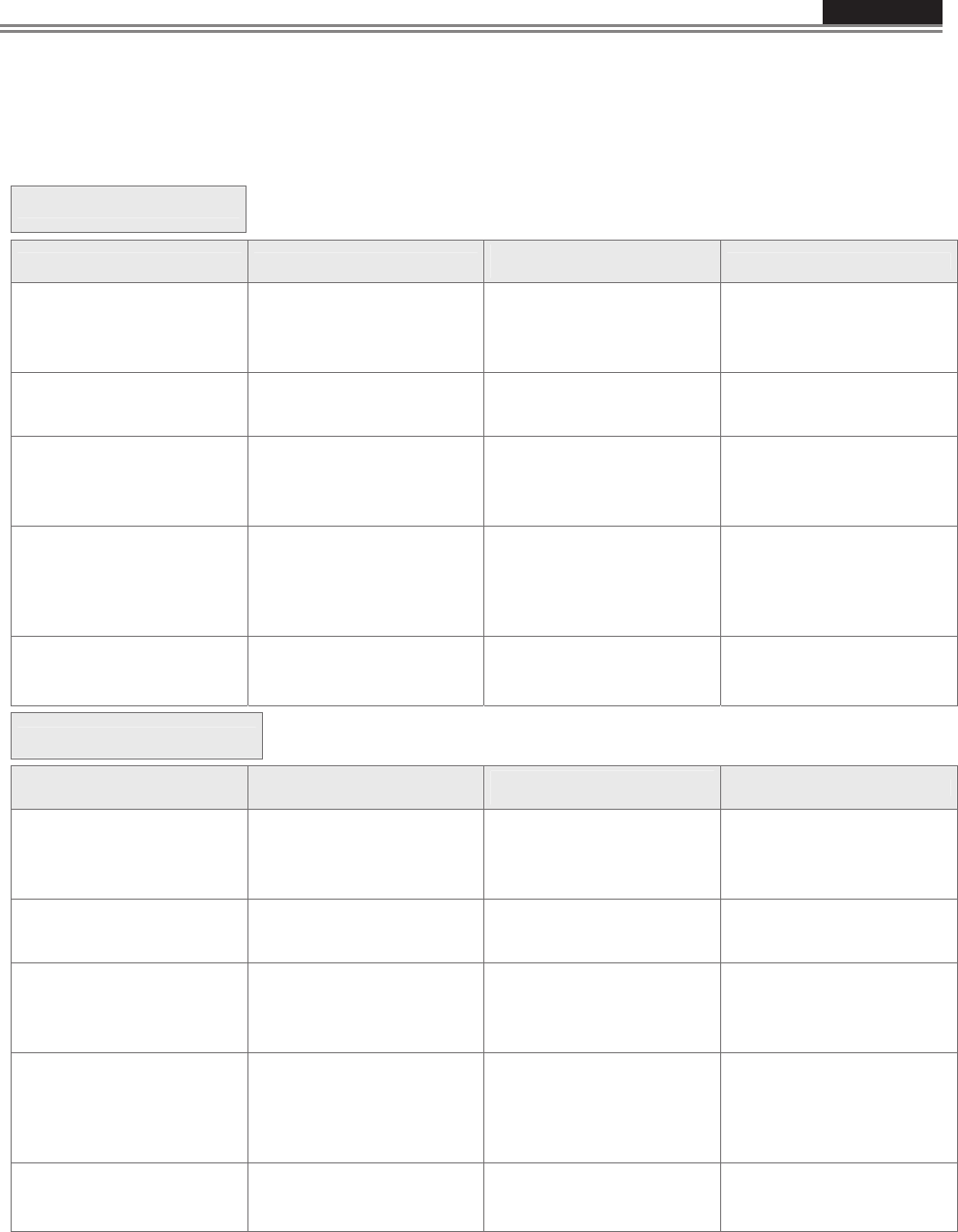
ENGLISH
Use & Care Manual
19
Convection Bake Chart
Reduce standard recipe temperature by 25 ºF (15 °C) for Convection Bake.
Temperatures have been reduced in this chart.
CONVECTION CAVITY
FOOD ITEM RACK POSITION TEMP. °F (°C)
(PREHEATED OVEN) TIME (MIN)
Cake
Cupcakes 2 325 (160) 20-22
Bundt Cake 1 325 (160) 43-50
Angel Food 1 325 (160) 43-47
Pie
2 crust, fresh, 9" 2 350-400 (175-205) 40-52
2 crust, frozen fruit, 9" 2 350 (175) 68-78
Cookies
Sugar 2 325-350 (160-175) 9-12
Chocolate Chip 2 325-350 (160-175) 8-13
Brownies 2 325 (160) 29-36
Breads
Yeast bread, loaf, 9x5 2 350 (175) 18-22
Yeast rolls 2 350-375 (175-190) 12-15
Biscuits 2 375 (190) 8-10
Muffins 2 400 (205) 17-21
Pizza
Frozen 2 375-425 (190-220) 23-26
Fresh 2 450 (232) 15-18
DOUBLE CONVECTION CAVITY
FOOD ITEM RACK POSITION TEMP. °F (°C)
(PREHEATED OVEN) TIME (MIN)
Cake
Cupcakes 2 325 (160) 16-18
Bundt Cake 1 325 (160) 37-43
Angel Food 1 325 (160) 35-39
Pie
2 crust, fresh, 9" 2 350-400 (175-205) 35-45
2 crust, frozen fruit, 9" 2 350 (175) 68-78
Cookies
Sugar 2 325-350 (160-175) 6-9
Chocolate Chip 2 325-350 (160-175) 8-13
Brownies 2 325 (160) 29-36
Breads
Yeast bread, loaf, 9x5 2 350 (175) 18-22
Yeast rolls 2 350-375 (175-190) 12-15
Biscuits 2 375 (190) 6-8
Muffins 2 400 (205) 13-16
Pizza
Frozen 2 375-425 (190-220) 23-26
Fresh 2 450 (232) 15-18
This chart is a guide. Follow recipe or package directions and reduce temperatures appropriately.
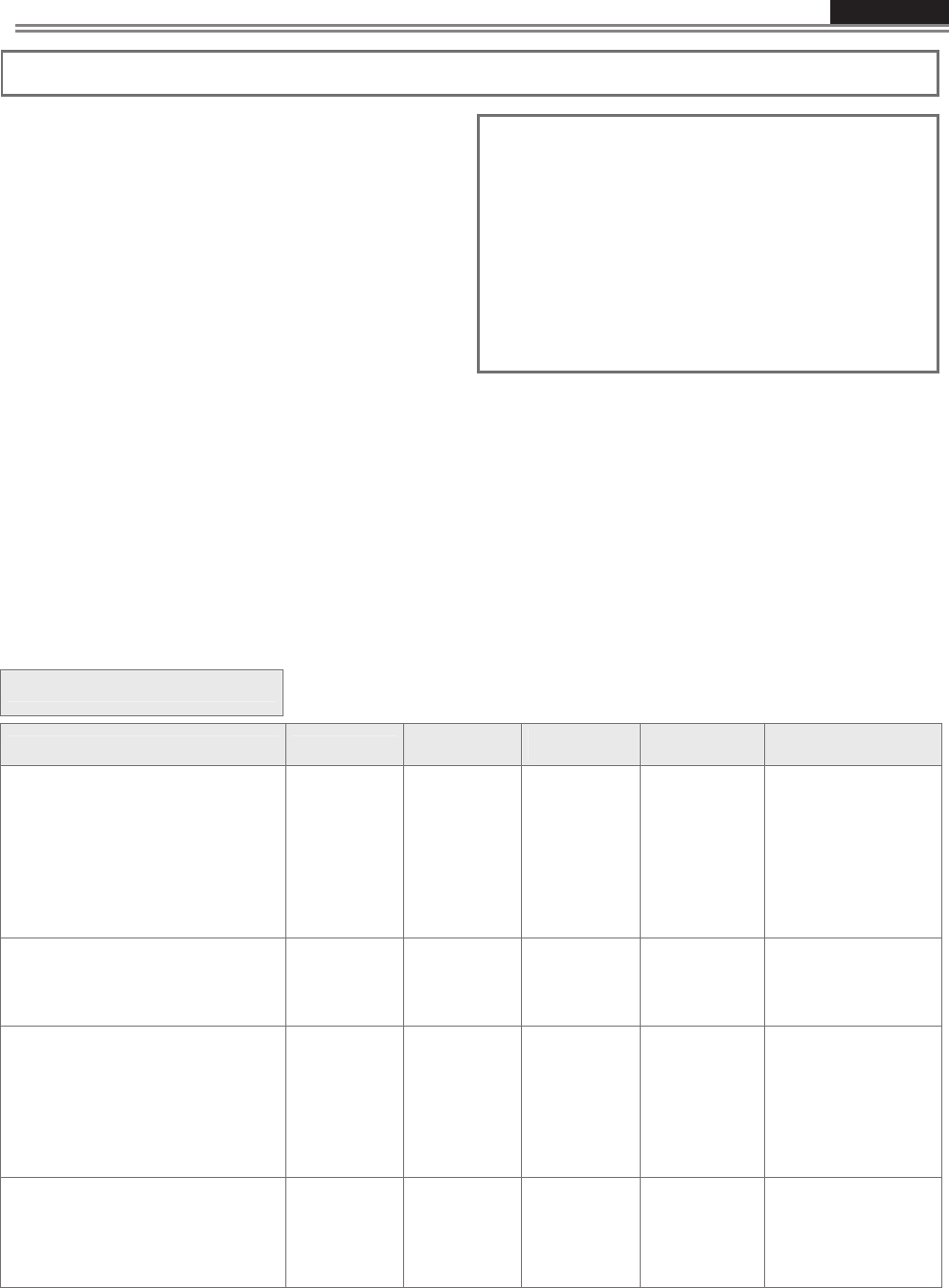
ENGLISH
Use & Care Manual
20
Convection Roast Tips and Techniques
Quick and easy recipe
tips
Con
v
e
r
ting fr
om standard
BAKE
to
CONVECTION
RO
AST
:
x
T
emperatur
e does not ha
v
e
to be lo
w
e
r
ed.
x
Roasts,
large cuts of meat and poultr
y
generall
y tak
e
10-20% less cooking time
.
Check doneness earl
y
.
x
Casser
oles or pot r
oasts that ar
e baked
co
v
e
r
ed in
CONVECTION R
O
AST
will cook in about the
same amount of time.
x Do not preheat for Convection Roast.
x Roast in a low-sided, uncovered pan.
x When roasting whole chickens or turkey, tuck wings
behind back and loosely tie legs with kitchen string.
x Use the 2-piece broil pan for roasting uncovered.
x Use the probe or a meat thermometer to determine
the internal doneness on “END” temperature (see
cooking chart).
x Double-check the internal temperature of meat or
poultry by inserting meat thermometer into another
position.
x Large birds may also need to be covered with foil
(and pan roasted) during a portion of the roasting
time to prevent over-browning.
x
The minimum safe temperature for stuffing in
poultry is 165ºF (75ºC).
x
After removing the item from the oven, cover
loosely with foil for 10 to 15 minutes before
carving if necessary to increase the final foodstuff
temperature by 5° to 10°F (3° to 6° C)
Convection Roast Chart
CONVECTION CAVITY
MEATS WEIGHT (lb) OVEN TEMP.
°F (°C)
RACK
POSITION
TIME
(min. per lb)
INTERNAL
TEMP. °F (°C)
Beef
Rib Roast 4-6 325 (160) 2 16-20 145 (63) medium rare
18-22 160 (71) medium
Rib Eye Roast, (boneless) 4-6 325 (160) 2 16-20 145 (63) medium rare
18-22 160 (71) medium
Rump, Eye, Tip, Sirloin (boneless) 3-6 325 (160) 2 16-20 145 (63) medium rare
18-22 160 (71) medium
Tenderloin Roast 2-3 400 (205) 2 15-20 145 (63) medium rare
Pork
Loin Roast 5-8 350 (175) 2 16-20 160 (71) medium
(boneless or bone-in)
Shoulder 3-6 350 (175) 2 20-25 160 (71) medium
Poultry
Chicken whole 3-4 375 (190) 2 18-21 180 (82)
Turkey, not stuffed 12-15 325 (160) 1 10-14 180 (82)
Turkey, not stuffed 16-20 325 (160) 1 9-11 180 (82)
Turkey, not stuffed 21-25 325 (160) 1 6-10 180 (82)
Turkey Breast 3-8 325 (160) 1 15-20 170 (77)
Comish Hen 1-1 ½ 350 (175) 2 45-75 total 180 (82)
Lamb
Half Leg 3-4 325 (160) 2 22-27 160 (71) medium
28-33 170 (77) well
Whole Leg 6-8 325 (160) 1 22-27 160 (71) medium
28-33 170 (77) well
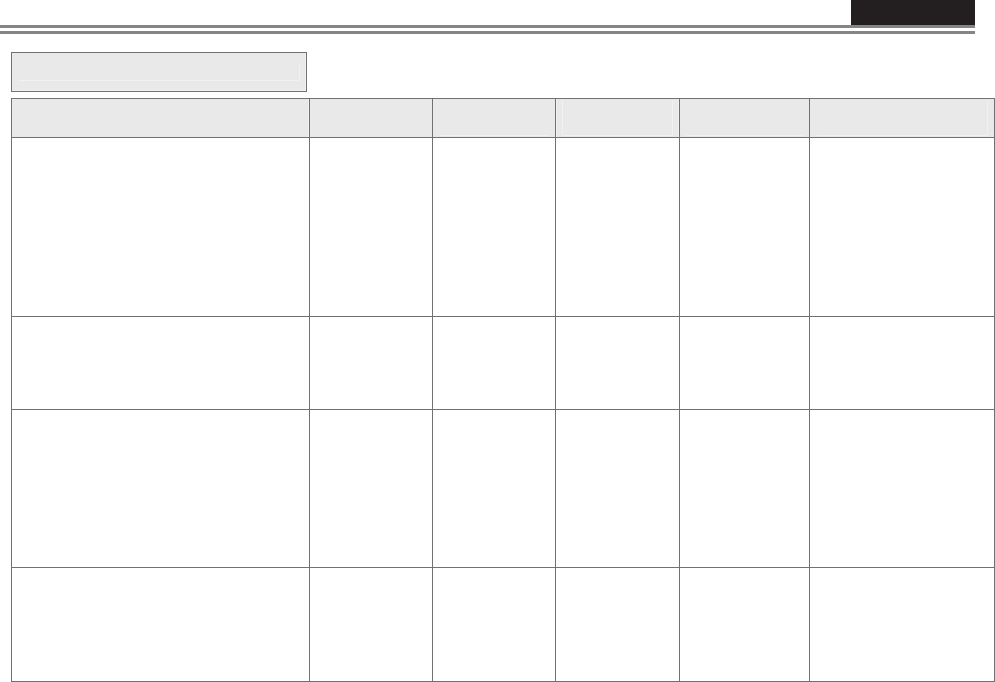
ENGLISH
Use & Care Manual
21
DOUBLE CONVECTION CAVITY
MEATS WEIGHT (lb) OVEN TEMP.
°F (°C)
RACK
POSITION
TIME
(min. per lb)
INTERNAL
TEMP. °F (°C)
Beef
Rib Roast 4-6 325 (160) 2 18-22 145 (63) medium rare
20-25 160 (71) medium
Rib Eye Roast, (boneless) 4-6 325 (160) 2 18-22 145 (63) medium rare
20-25 160 (71) medium
Rump, Eye, Tip, Sirloin (boneless) 3-6 325 (160) 2 18-22 145 (63) medium rare
20-25 160 (71) medium
Tenderloin Roast 2-3 425 (220) 2 15-20 145 (63) medium rare
Pork
Loin Roast 5-8 350 (175) 2 18-22 160 (71) medium
(boneless or bone-in)
Shoulder 3-6 350 (175) 2 20-25 160 (71) medium
Poultry
Chicken whole 3-4 375 (190) 2 20-23 180 (82)
Turkey, not stuffed 12-15 325 (160) 1 10-14 180 (82)
Turkey, not stuffed 16-20 325 (160) 1 9-11 180 (82)
Turkey, not stuffed 21-25 325 (160) 1 6-10 180 (82)
Turkey Breast 3-8 325 (160) 1 15-20 170 (77)
Comish Hen 1-1 ½ 350 (175) 2 45-75 total 180 (82)
Lamb
Half Leg 3-4 325 (160) 2 20-27 160 (71) medium
25-32 170 (77) well
Whole Leg 6-8 325 (160) 1 20-27 160 (71) medium
25-32 170 (77) well
Cooking times are indicative and also depend on the thickness and the starting temperature of the meat before cooking
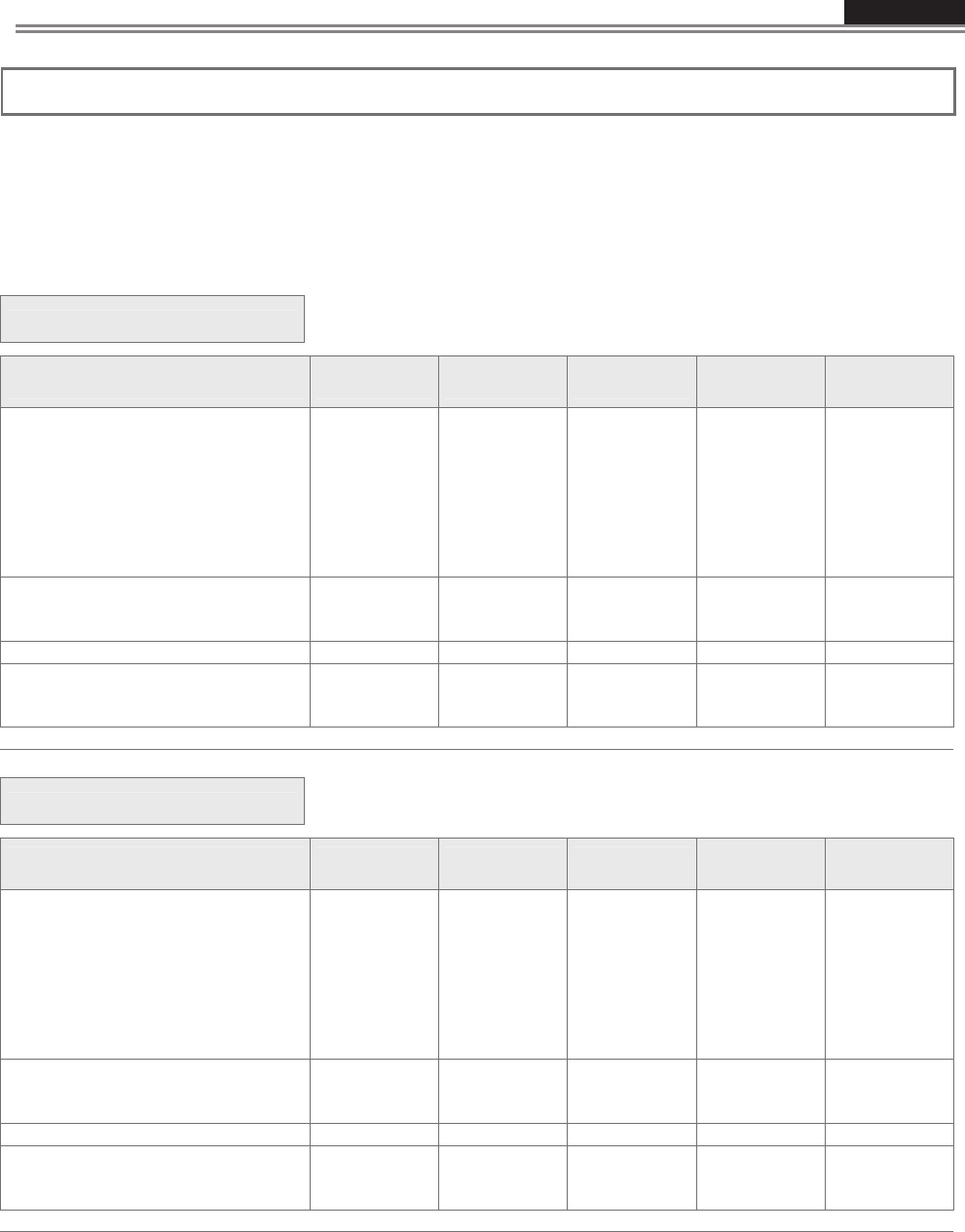
ENGLISH
Use & Care Manual
22
Convection Broil Tips and Techniques
x Place rack in the required position needed before turning on the oven.
x Use Convection Broil mode with the oven door closed.
x Do not preheat oven.
x Use the 2-piece broil pan.
x Turn meats once halfway through the cooking time (see convection broil chart).
Convection Broil Chart
CONVECTION CAVITY
FOOD AND
THICKNESS
RACK
POSITION
BROIL
SETTING °F (°C)
INTERNAL
TEMP. °F (°C)
TIME
SIDE 1
(MIN.)*
TIME
SIDE 2
(MIN.)*
Beef
Steak (1-½" or more)
Medium rare 4 450 (235) 145 (65) 9-12 8-10
Medium 4 450 (235) 160 (71) 11-13 10-12
Well 4 450 (235) 170 (77) 18-20 16-17
Hamburgers (more than 1")
Medium 4 550 (290) 160 (71) 8-11 5-7
Well 4 550 (290) 170 (77) 11-13 8-10
Poultry
Chicken Quarters 4 450 (235) 180 (82) 16-18 10-13
Chicken Halves 3 450 (235) 180 (82) 25-27 15-18
Chicken Breasts 4 450 (235) 170 (77) 13-15 9-13
Pork
Pork Chops (1¼" or more) 4 450 (235) 160 (71) 12-14 11-13
Sausage - fresh 4 450 (235) 160 (71) 4-6 3-5
* Broiling and convection broiling times are approximate and may vary slightly.
Cooking times are indicative and also depend on the thickness and the starting temperature of the meat before cooking .
DOUBLE CONVECTION CAVITY
FOOD AND
THICKNESS
RACK
POSITION
BROIL
SETTING °F (°C)
INTERNAL
TEMP. °F (°C)
TIME
SIDE 1
(MIN.)*
TIME
SIDE 2
(MIN.)*
Beef
Steak (1-½" or more)
Medium rare 4 450 (235) 145 (65) 11-13 10-12
Medium 4 450 (235) 160 (71) 15-17 13-15
Well 4 450 (235) 170 (77) 16-18 13-15
Hamburgers (more than 1")
Medium 4 550 (290) 160 (71) 9-11 5-8
Well 4 550 (290) 170 (77) 11-13 8-10
Poultry
Chicken Quarters 4 450 (235) 180 (82) 18-20 13-15
Chicken Halves 3 450 (235) 180 (82) 25-27 15-18
Chicken Breasts 4 450 (235) 170 (77) 14-16 10-14
Pork
Pork Chops (1¼" or more) 4 450 (235) 160 (71) 13-15 12-14
Sausage - fresh 4 450 (235) 160 (71) 4-6 3-5
* Broiling and convection broiling times are approximate and may vary slightly.
Cooking times are indicative and also depend on the thickness and the starting temperature of the meat before cooking .
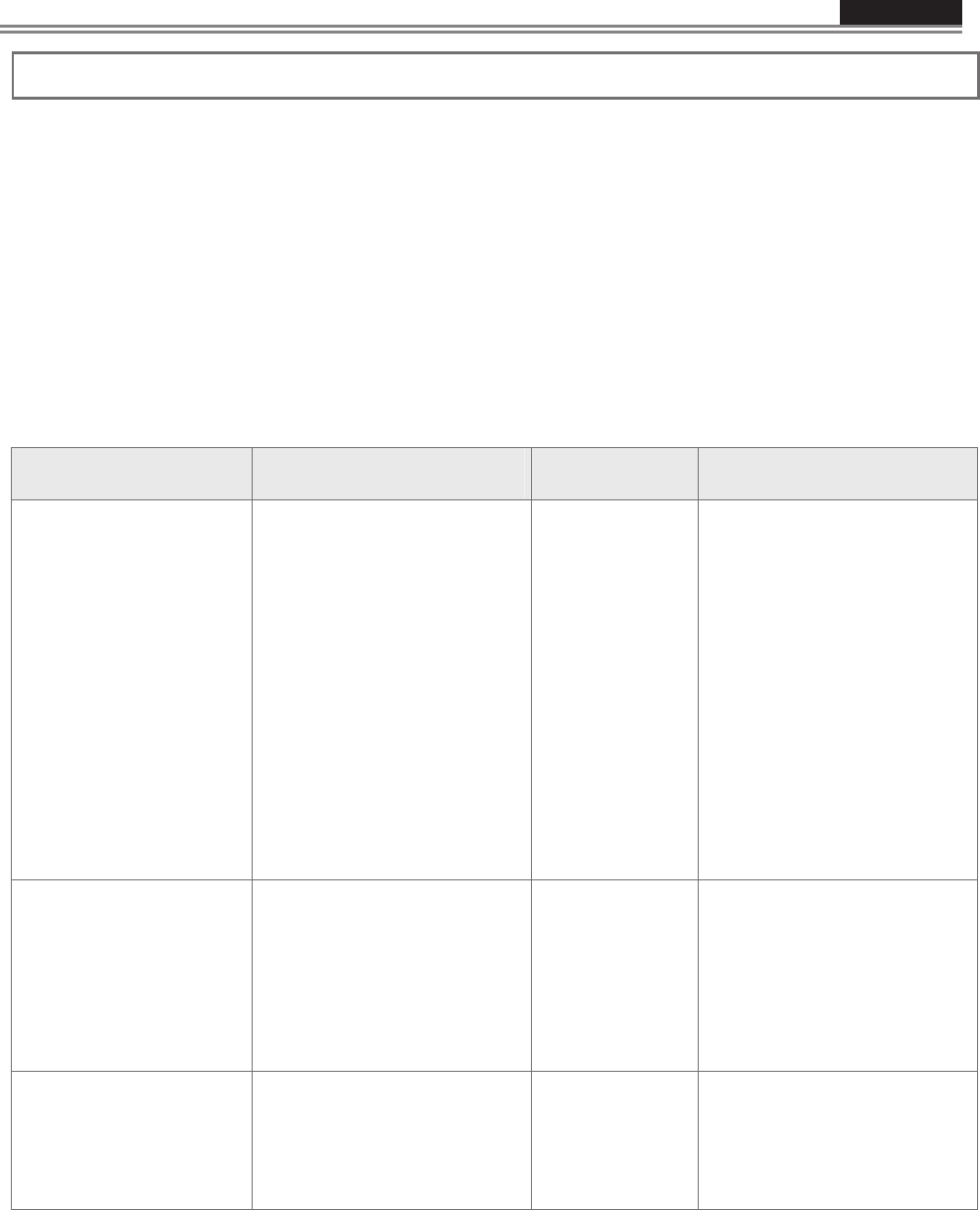
ENGLISH
Use & Care Manual
23
Dehydrate Tips and Techniques
x Dehydrating can be done using the Dehydrate mode. A lower temperature is used and the circulating
heated air slowly removes the moisture for food preservation.
x The Dehydrate mode temperature is pre-programmed at 140ºF (60ºC).
x The Dehydrate mode temperatures available are 120ºF (50ºC) to 160ºF (70ºC).
x Multiple racks can be used simultaneously.
x Some foods require as much as 14-15 hours of time to fully dehydrate.
x Consult a food preservation book for specific times and the handling of various foods.
x This mode is suitable for a variety of fruits, vegetables, herbs and meat strips.
x Drying screens can be purchased at specialty kitchen shops.
x By using paper towels, some food moisture can be absorbed before dehydrating begins (such as with
sliced tomatoes or sliced peaches).
Dehydrate Chart
FOOD
PREPARATION
APPROXIMATE
DRYING TIME*
(hrs)
TEST FOR DONENESS
Fruit
Apples
Dipped in 1/4 cup lemon juice
and 2 cups water, 1/4 slices 11-15 Slightly pliable
Bananas
Dipped in 1/4 cup lemon juice
and 2 cups water, 1/4 slices 11-15 Slightly pliable
Cherries
Wash and towel dry.
For fresh cherries, remove pits 10-15 Pliable, leathery, chewy
Oranges Peels
and slices
¼ slices of orange;
orange part of skin thinly peeled
from oranges
Peels 2-4
Slices: 12-16
Orange peel: dry and brittle
Orange slices: skins are dry
and brittle, fruit is slightly moist
Pineapple rings
Towel dried Canned: 9-13
Fresh: 8-12 Soft and pliable
Strawberries
Wash and towel dry.
Sliced ½" thick,
skin (outside) down on rack
12-17 Dry, brittle
Vegetable
Peppers
Wash and towel dry.
Remove membrane of pepper,
coarsely chopped about 1" pieces
16-20 Leathery with no moisture
inside
Mushrooms
Wash and towel dry.
Cut of stem end. Cut into 1/8" slices 7-12 Tough and leathery, dry
Tomatoes
Wash and towel dry.
Cut this slices, 1/8" thick, dry well 16-23 Dry, brick red color
Herbs
Oregano, sage parsley and
thyme, and fennel Rinse and dry with paper towel Dry at 120°F (60°C)
3-5 hrs Crisp and brittle
Basil
Use basil leaves 3 to 4 inches
from top. Spray with water,
shake off moisture and pat dry
Dry at 120°F (60°C)
3-5 hrs Crisp and brittle
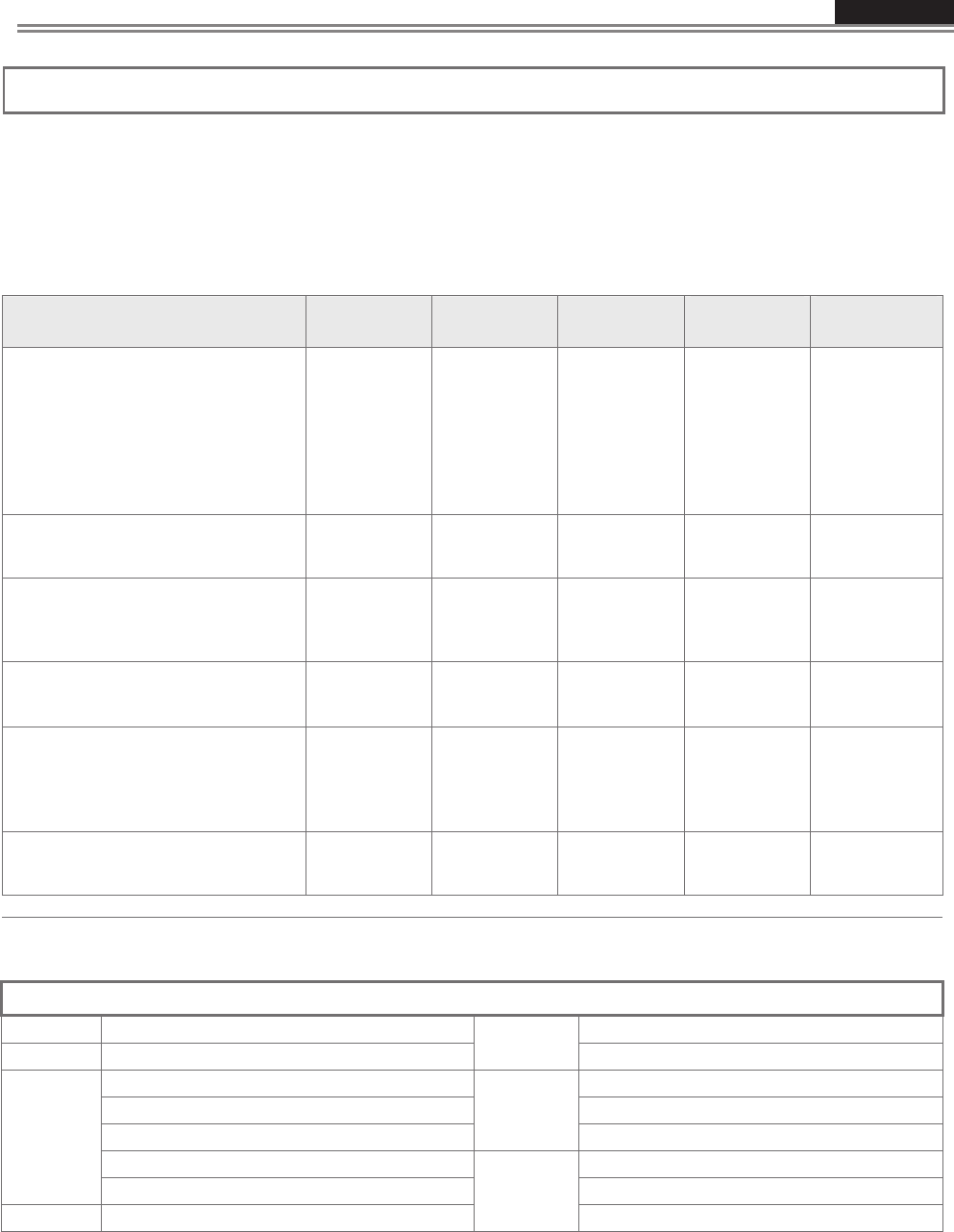
ENGLISH
Use & Care Manual
24
Broil Tips and Techniques
x Place rack in the required position needed before turning on the oven.
x Use Broil mode with the oven door closed.
x Preheat oven for 5 minutes before use.
x Use the 2-piece broil pan.
x Turn meats once halfway through the cooking time (see convection broil chart).
Broil Chart
FOOD AND
THICKNESS
RACK
POSITION
BROIL
SETTING
INTERNAL
TEMP. °F (°C)
TIME
SIDE 1
(MIN.)*
TIME
SIDE 2
(MIN.)*
Beef
Steak (3/4"-1")
Medium rare 5 5 145 (63) 5-7 4-6
Medium 5 5 160 (71) 6-8 5-7
Well 5 5 170 (77) 8-10 7-9
Hamburgers (3/4"-1")
Medium 4 5 160 (71) 8-11 6-9
Well 4 5 170 (77) 10-13 8-10
Poultry
Breast (bone-in) 4 4 170 (77) 10-12 8-10
Thigh (very well done) 4 3 180 (82) 28-30 13-15
Pork
Pork Chops (1") 5 5 160 (71) 7-9 5-7
Sausage - fresh 5 5 160 (71) 5-7 3-5
Ham Slice (½") 5 5 160 (71) 4-6 3-5
Seafood
Fish Filets, 1" 4 4 10-14
Buttered
Cook until
opaque & flakes
easily with fork
Do not turn
Lamb
Chops (1")
Medium Rare 5 5 145 (63) 5-7 4-6
Medium 5 5 160 (71) 6-8 4-6
Well 5 5 170 (77) 7-9 5-7
Bread
Garlic Bread, 1" slices 4 5 2-2,30
Garlic Bread, 1" slices 3 5 4-6
* Broiling and convection broiling times are approximate and may vary slightly
Cooking times are indicative and also depend on the thickness and the starting temperature of the meat before cooking .
Food Service Temperature Guidelines from FSIS (USDA food Safety & Inspection Service)
140°F(60°C) Ham, precooked ( to Reheat) Stuffing (cooked alone or in bird)
145°F(63°C) Fresh beef, Veal, Lamb (medium rare)
165°F
(74°C) Leftovers & Casseroles
Ground Meat & Meat mixtures (Beef, Pork, Veal Lamb) Fresh beef, Veal, Lamb (well done)
Fresh beef, Veal, Lamb (medium) Poultry breast
Fresh Pork (medium)
170°F
(77°C)
Fresh Pork (well done)
Fresh Ham (raw) Chicken and Turkey (Whole)
160°F(71°C)
Egg Dishes Poultry (thighs and wings)
165°F(74°C) Ground Meat & Meat mixtures (Turkey, Chicken)
180°F
(82°C)
Duck and Goose
Note : Eggs (alone, not used in a recipe) – cook until yolk & white are firm
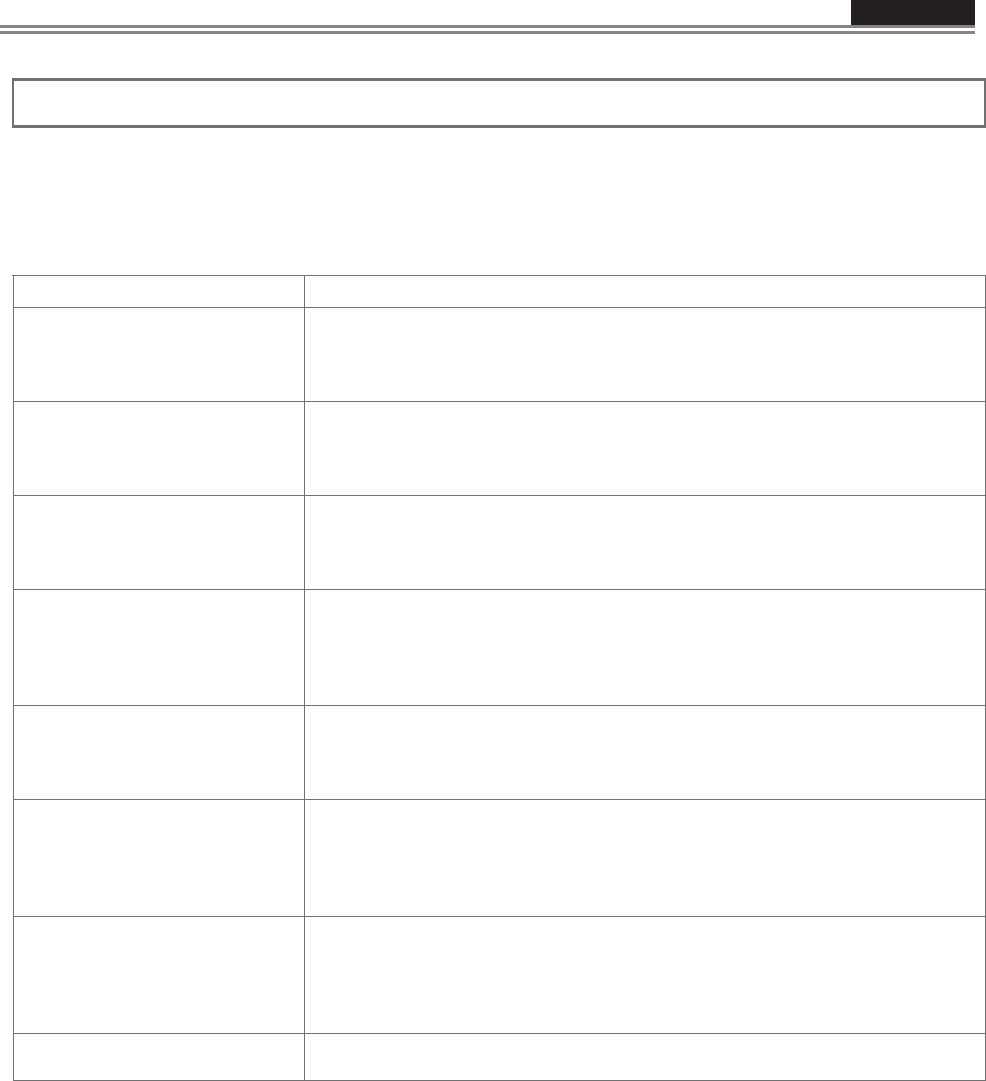
ENGLISH
Use & Care Manual
25
Solving Baking Problems
With either Bake or Convection Bake, poor results can occur for many reasons other than a malfunction of the
oven. Check the chart below for causes of the most common problems. Since the size, shape and material of
baking utensils directly affect the baking results, the best solution may be to replace old baking utensils that
have darkened and warped with age and use. Check the Baking Charts from Page 17 to 24 for the correct rack
position and baking time
Baking Problem
Cause
Food browns unevenly x Oven not preheated
x Aluminum foil on oven rack or oven bottom
x Baking utensil too large for recipe
x Pans touching each other or oven walls
Food too brown on bottom x Oven not preheated
x Using glass, dull or darkened metal pans
x Incorrect rack position
x Pans touching each other or oven walls
Food is dry or has shrunk
excessively
x Oven temperature too high
x Baking time too long
x Oven door opened frequently
x Pan size too large
Food is baking or roasting
too slowly
x Oven temperature too low
x Oven not preheated
x Oven door opened frequently
x Tightly sealed with aluminum foil
x Pan size too small
Pie crusts do not brown on
bottom or have soggy crust
x Baking time not long enough
x Using shiny steel pans
x Incorrect rack position
x Oven temperature is too low
Cakes pale, flat and may
not be done inside
x Oven temperature too low
x Incorrect baking time
x Cake tested too soon
x Oven door opened too often
x Pan size may be too large
Cakes high in middle with
crack on top
x Baking temperature too high
x Baking time too long
x Pans touching each other or oven walls
x Incorrect rack position
x Pan size too small
Pie crust edges too brown x Oven temperature too high
x Edges of crust too thin
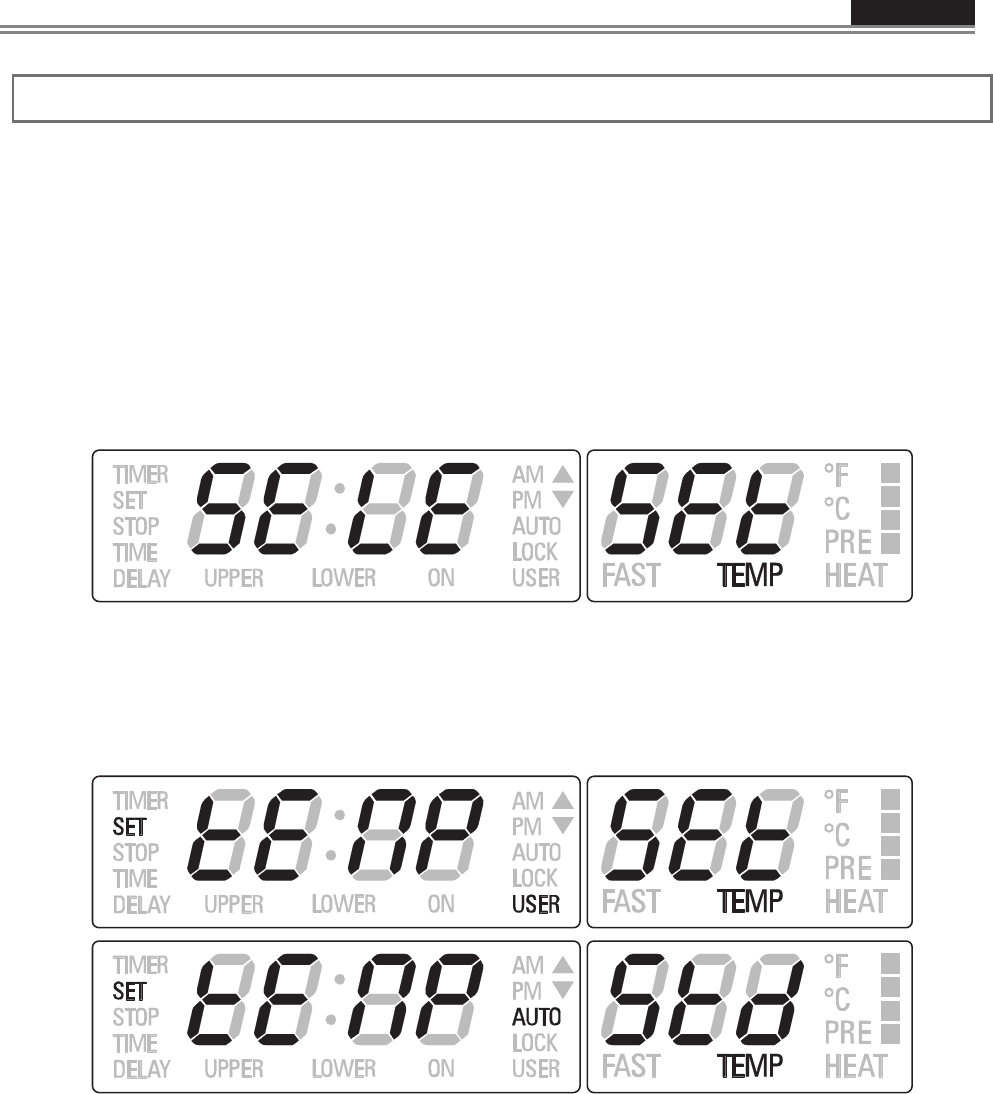
ENGLISH
Use & Care Manual
26
Special Features
The Special Features function can be used to select the following special oven features:
1. SAB => SABBATH MODE (for religious faiths with “no work” requirements on the Sabbath).
2. OFS => OVEN OFFSET (used to calibrate the oven temperature).
3. dEG => °UNIT (used to select Farhenheit or Celsius).
4. Hr => CLOCK FORMAT (used to set the time of day format as 12:00 AM/PM or 24:00).
5. Set => PRESET TEMPERATURE (it’s possible to save the standard preset temperature per every
cooking mode or to keep in memory the last used temperature).
To select special features, follow the steps below:
x Touch and hold [OPTIONS] and [TIME] keys for at least 3 seconds. Clock time disappears and the
following display is shown:
x Touch the [INC] or the [DEC] key to scroll all available options described above, until the desired one is
found.
x Touch [OPTIONS] key to edit the selected options.
x Change the value by means of [INC] or [DEC] keys.
x Touch the [OPTIONS] key to confirm the option and go back to the selection menu or hold the key for 3
second to quit the User Option Menu and go back to the clock original screen.
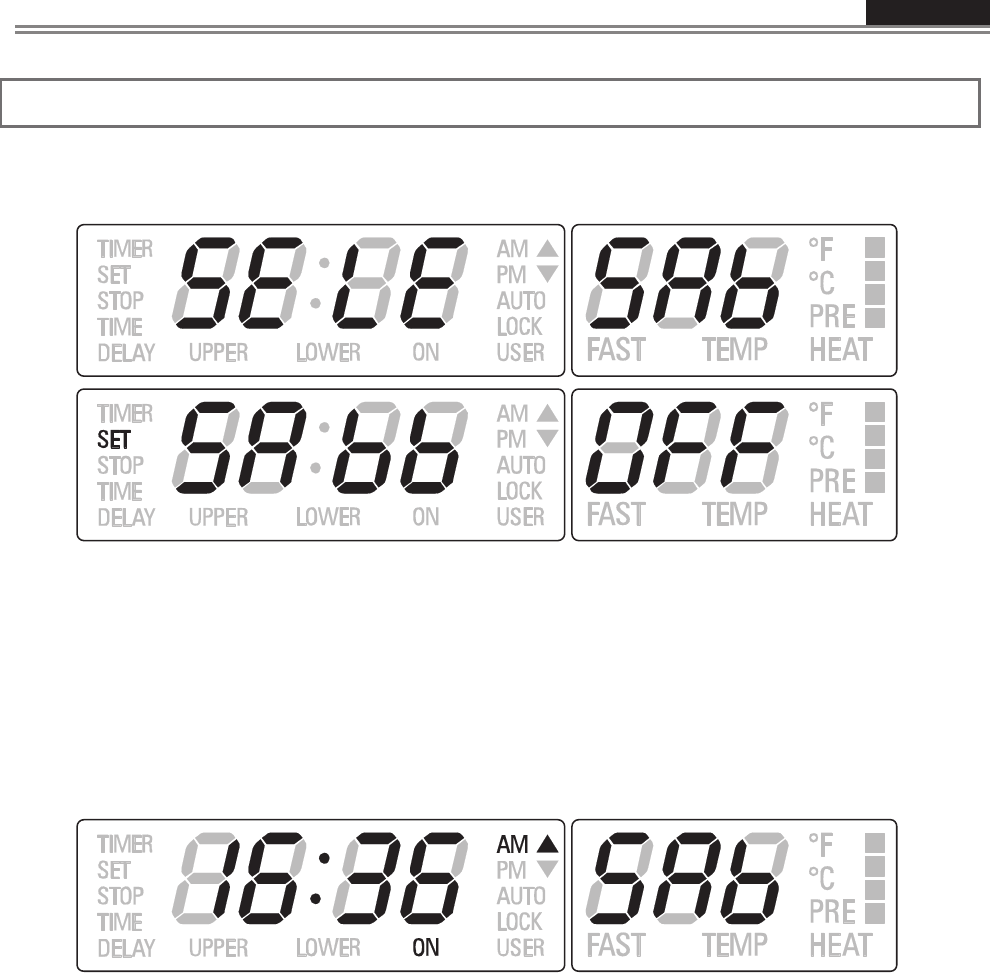
ENGLISH
Use & Care Manual
27
Sabbath Mode Instruction
x Enter the user option menu holding [OPTIONS] and [TIME] keys for 3 seconds. Scroll the option list
(dEG, OFS, Hr, Sab), shown by the red temperature module, by pressing [INC]/[DEC], until Sabbath item
is found.
x Touch [OPTIONS] to enter edit mode: the selected item switches to the green digits on the left and its status
in the red digits field starts blinking.
x Touch again [INC]/[DEC] keys to set Sabbath mode ON or OFF (Default=OFF). Touch [OPTIONS] to confirm
and come back to the option list. Hold [OPTIONS] key for 3 seconds to quit the selection menu and go back
to normal operations.
x Once Sabbath mode is set, only BAKE and OFF positions are available in the cooking mode selector. Move
the selector to BAKE then set the temperature to the desired value within 5 minutes.
x After 5 minutes, the temperature cannot be shown any more and the display appears as below: Sabbath
mode is active.
x Oven lights status cannot be changed during Sabbath time.
x Oven temperature can only be lowered but no information can be displayed.
x The cooling fan must run in Sabbath mode.
x Preheat lights are inhibited during Sabbath mode.
x The buzzer must always be silent, regardless of any fault, end of activity, etc.
x The meat probe can never be used in Sabbath mode.
x Maximum allowed cooking time must be 72 hours.
x The user is allowed to stop the oven manually, also during Sabbath, moving the cooking mode selector to
OFF position.
x Heating elements cycling must not depend on the door switch status. Opening or closing the door must not
switch the relays directly.
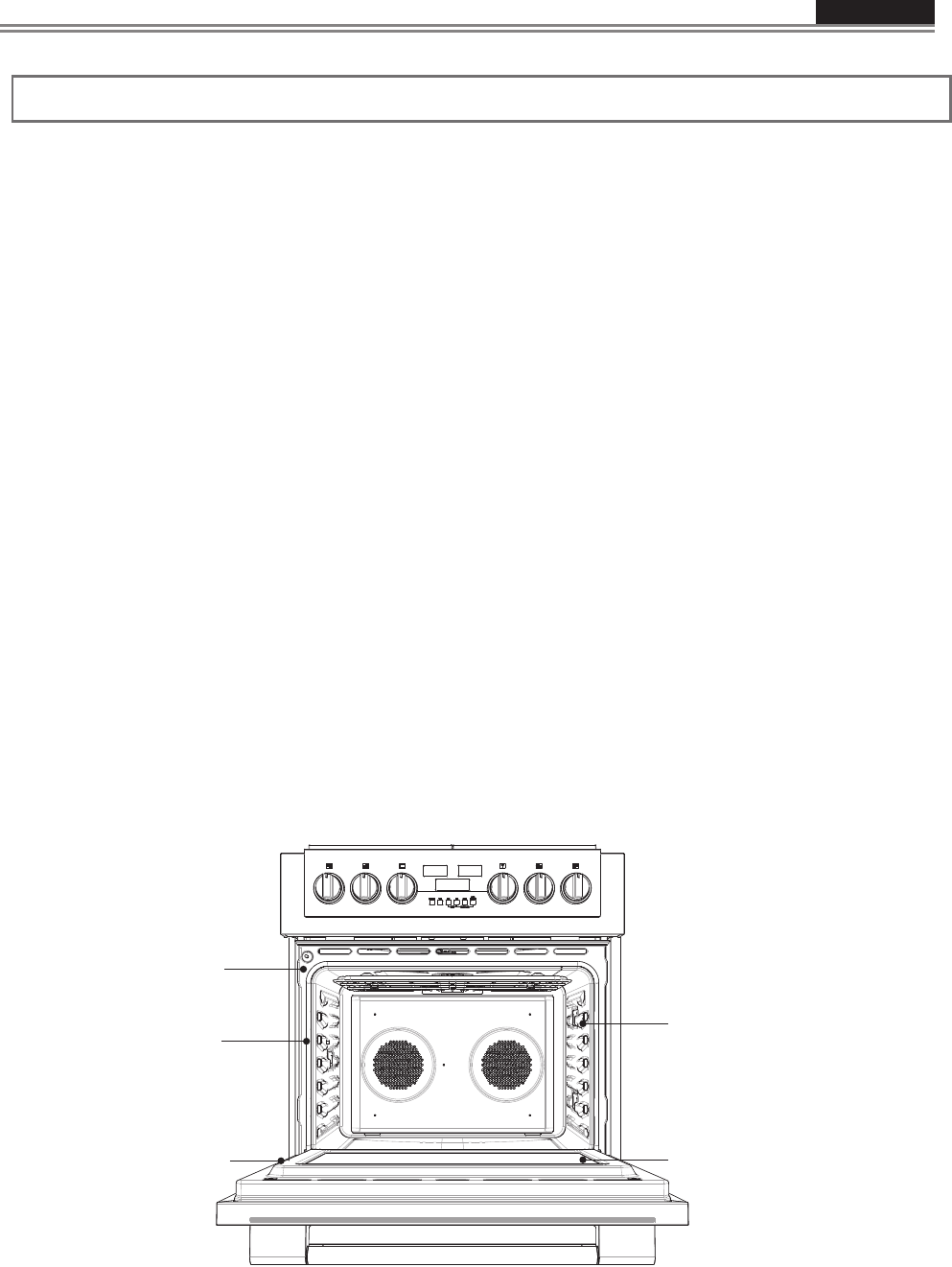
ENGLISH
Use & Care Manual
28
Oven Care and Cleaning
Self-Cleaning the Oven
This oven features a pyrolytic self-cleaning function that eliminates the difficult and time consuming manual
scrubbing of the oven interior. During self-cleaning, the oven uses a very high temperature (approx. 885°F/470°C)
to burn away food soil and grease.
x
x It is common to see smoke and/or an occasional flame-up during the Self-Clean cycle, depending on the
content and amount of soil remaining in the oven. If a flame persists, turn off the oven and allow it to cool
before opening the door to wipe up the excessive food soil.
x The door latch is automatically activated after selecting the Self-Clean cycle. The “AUTO LOCK” writings
will appear in the display. This ensures that the door cannot be opened while the oven interior is at clean
temperatures.
x The oven light does not operate during this mode.
x During Self-Clean, the kitchen should be well ventilated to help eliminate odors associated with Self-
Clean. Odors will lessen with use.
x Three hours is the preset length of cleaning.
x The mode automatically stops at the end of the clean hours.
x When the oven heat drops to a safe temperature, the automatic door lock will release and the door can
be opened.
Preparing the Oven for Self-Clean
1. Remove all utensils and bake ware.
2.
3. Wipe up any soft soil spills and grease with paper towels. Excess grease will cause flames and smoke
inside the oven during self-cleaning.
4. Review illustration below. Some areas of the oven must be cleaned by hand before the cycle begins.
They do not get hot enough during the cleaning cycle for soil to burn away. Use a soapy sponge or plastic
scrubber or a detergent-filled S.O.S.® pad. Hand-clean the oven door edge, oven front frame and up to
1-½ “ (2-3 cm) inside the frame with detergent and hot water. Do not rub the gasket on oven. Clean by
hand the oven door window. Rinse all areas thoroughly then dry.
5. Be sure oven interior lights are turned off and the light bulbs and lens covers are in place. See Pages 31.
Remove non-porcelain oven racks. If chromed racks are left in the oven during the self-clean cycle, they
will permanently lose the shiny finish and change to a dull dark finish. See Oven Cleaning Chart for
proper care, Pages 3 to 3 .
Do not use the hob during the oven self cleaning cycle.
78
Hand clean frame
area ouside gasket
DO NOT
hand clean gasket
Hand clean door
area ouside gasket
Hand clean 1” (2cm)
from rack guides
to frame of oven cavity
Hand clean door
window
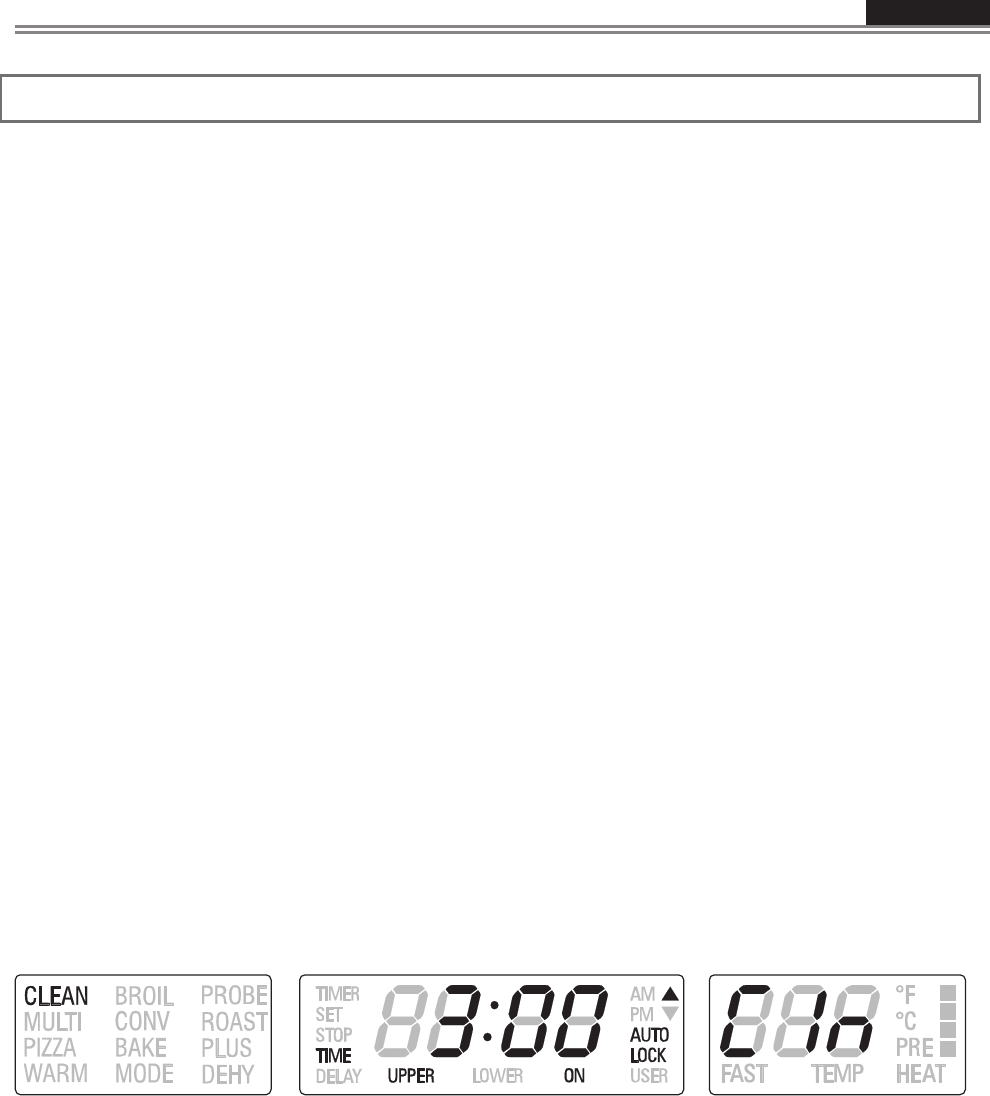
ENGLISH
Use & Care Manual
29
Setting the Self-Clean Mode
To Set the Self-Clean Mode
standard value is 3 hours.
the oven will automatically turn off.
move one of the two knobs from the cleaning
position.
Do not attempt to open the door while the door is
locked. The “AUTO LOCK” writings will flash until the
motor stops. When they are displayed, the door
cannot be opened. Check that the door has been
locked and will not open before starting the Self-Clean
mode.
If door does not lock, rotate the cooking mode knob
into the OFF position and do not start self-clean;
phone for service.
If the door is in the open position when this mode is
selected, the “AUTO LOCK” writings will flash until the
door is closed. The latch doesn’t move.
To Change the Cleaning Time
1. To change the setting from 3 hours, select
either 2 hours for light soil or 4 hours for
heavy soil immediately before starting.
2. To change the hours, touch the [TIME] key.
3. The hours will flash.
4. Use [INC] or [DEC] keys to change the value.
5. To change the minutes, touch the [TIME] key
again.
6. The minutes will flash.
7. Use [INC] or [DEC] keys to change the value.
Hold the key to change by 10 minutes steps.
8. Touch [TIME] or wait a few seconds to confirm
the new value.
To Delay the Start of Cleaning
1. Follow steps 1 through 7 above.
2. Touch the [TIME] key and verify that “STOP
TIME” appears on the display. The hours will
begin flashing.
3. Use [INC] or [DEC] keys to change the stop
time value.
4. To change the minutes, touch the [TIME] key,
the minutes will flash.
5. Use [INC] or [DEC] keys to change the value.
Hold the key to change by 10 minutes steps.
6. Touch [TIME] or wait a few seconds to confirm
the new value.
7. The latch starts moving to lock the oven door,
the display shows “DELAY”.
8. When the delay time expires, self-cleaning will
start.
9. At the end of the programmed cleaning time,
the oven will automatically turn off.
10. “End” will appear on the temperature display,
“CLEAN” on the mode display and “TIME” on
the clock display will start flashing until the
[TIME] key is touched or the knob is moved to
the OFF position.
In order to check the cleaning or the stop time during a
delayed clean, simply touch the [TIME] key until “TIME”
or “STOP TIME” writings are displayed.
1. Rotate both knobs into the clean position.
2. CLEAN & TIME appear.
3. The clean time is displayed automatically, its
4. At the end of the programmed cleaning time,
5. To stop the cleaning mode at any moment,
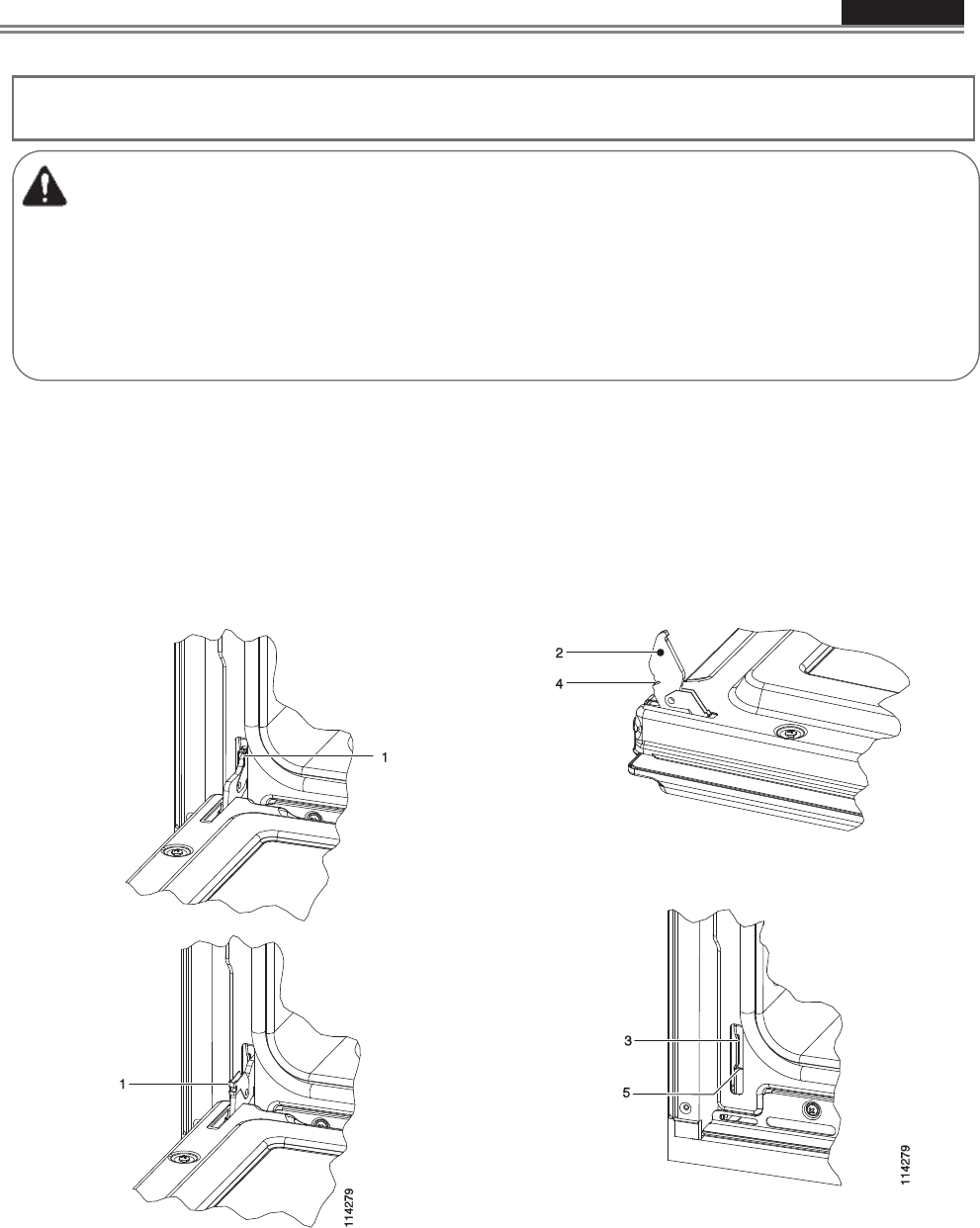
ENGLISH
Use & Care Manual
30
Do-it-Yourself Maintenance
Oven Door Removal
WARNING
x Make sure oven is cool and power to the oven has been turned off before removing the door. Failure to
do so could result in electrical shock or burns.
x The oven door is heavy and fragile. Use both hands to remove the oven door. The door front is glass.
Handle carefully to avoid breakage.
x Grasp only the sides of the oven door. Do not grasp the handle as it may swing in your hand and cause
damage or injury.
x Failure to grasp the oven door firmly and properly could result in personal injury or product damage.
To Remove Door
1. Open the door completely.
2. Lift up the hinge bracket (1).
3. Hold the door firmly on both sides using both
hands and close the door.
4. Hold firmly; the door is heavy.
5. Place the door in a convenient location.
To Replace Door
1. Insert the upper arms (2) of both hinges into the
slots (3). The recesses (4) must hook on the lips
(5).
2. Move the hinge brackets (1) back down into
position.
3. Close and open the door slowly to assure that it is
correctly and securely in place.
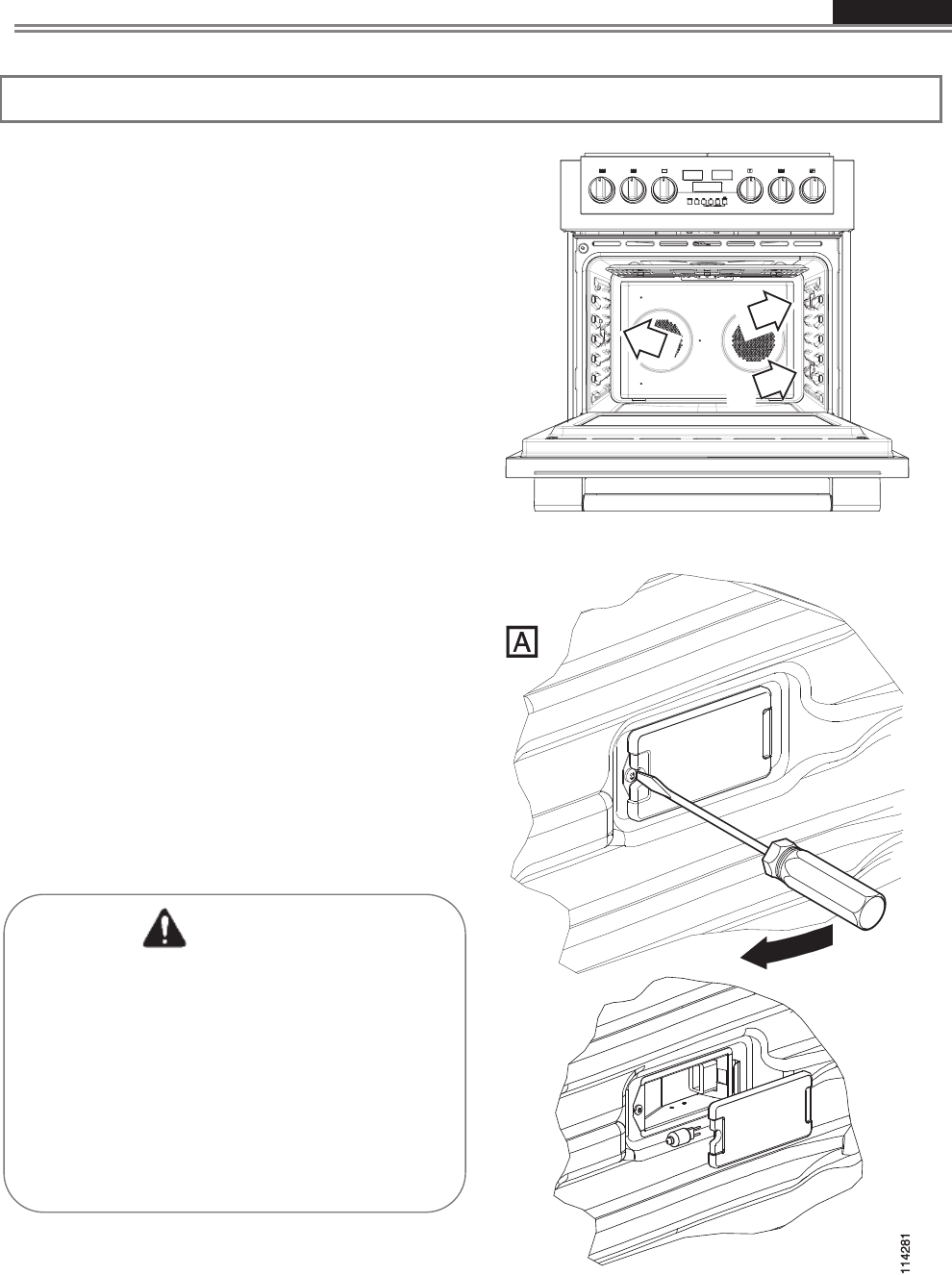
ENGLISH
Use & Care Manual
31
Replacing an Oven Light
x
x The lights are switched on when the door is
opened or when the oven is in a cooking
cycle.
x The oven lights are not illuminated during
SELF- CLEAN.
x Each light assembly consists of a removable
lens, a light bulb as well as a light socket
housing that is fixed in place. See figure on
this page.
x Light bulb replacement is considered to be a
routine maintenance item.
To Replace a Light Bulb
1. Read WARNING on this page.
2. Turn off power at the main power supply (fuse
or breaker box).
3.
5. Remove the light bulb from its socket by
pulling it.
6. Replace the bulb with a new one. Avoid
touching the bulb with fingers, as oils from
hands can damage the bulb when it becomes
hot.
7. The bulb is halogen: use one with the same
type checking Voltage and Wattage.
8. Place the lens back on.
9.
Turn power back on at the main power supply (fuse or
breaker box).
WARNING
x Make sure the oven and lights are cool and
power to the oven has been turned off before
replacing the light bulb(s). Failure to do so could
result in electrical shock or burns.
x The lenses must be in place when using the
oven.
x The lenses serve to protect the light bulb from
breaking.
x The lenses are made of glass. Handle carefully
to avoid breakage. Broken glass could cause an
injury.
Each oven is equipped with three halogen lights
(per cavity) located in the lateral walls of the oven.
In ovens with lateral rack supports, remove
them by unscrewing the four screws.
Remove the lens between screw and glass
using a screw driver.
4.
Replace the rack supports if provided is
provided with the oven model.
A
A
A
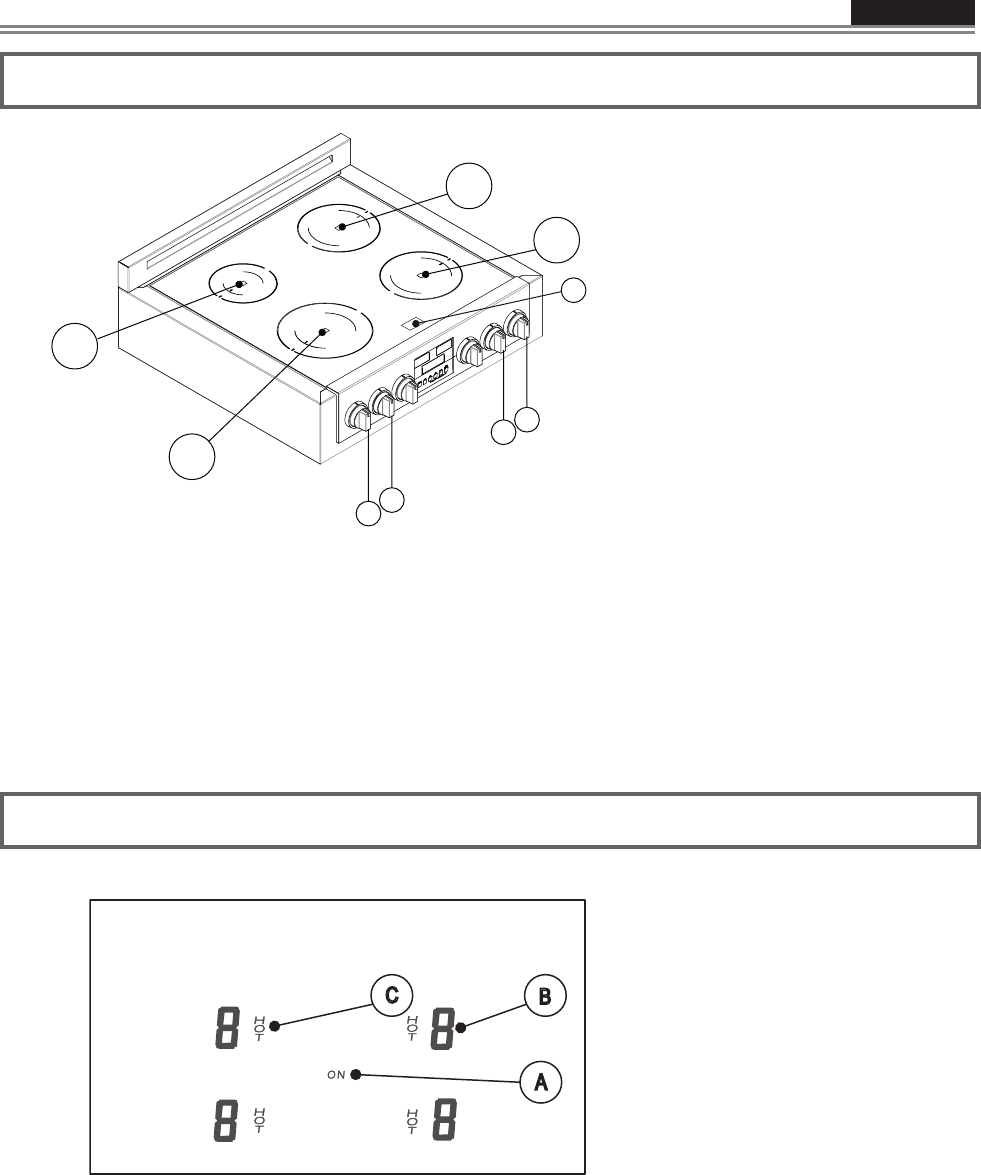
ENGLISH
Use & Care Manual
32
Features of your Cooktop
Display Unit Indications
1
2
4
3
2
1
4
3
5
Position 1 -2300W(Boost3700W)9”(230mm)-inductionelementandcontrol
Position2-1400W(Boost2200W)6”½(165mm)-inductionelementandcontrol
Position 3 -1850W(Boost3000W)7”¾(200mm)-inductionelementandcontrol
Position4-1850W(Boost3000W)7”¾(200mm)-inductionelementandcontrol
Position 5 -LedDisplay
NOTE:powerlevelsareindicativeandcanvaryaccordingtothepanusedorthesettingsmade.
A-ONdisplay
B-Powerleveldisplay
C-Residualheatdisplay
A-ONdisplay
B-Powerleveldisplay
C-Residualheatdisplay
B
C
A
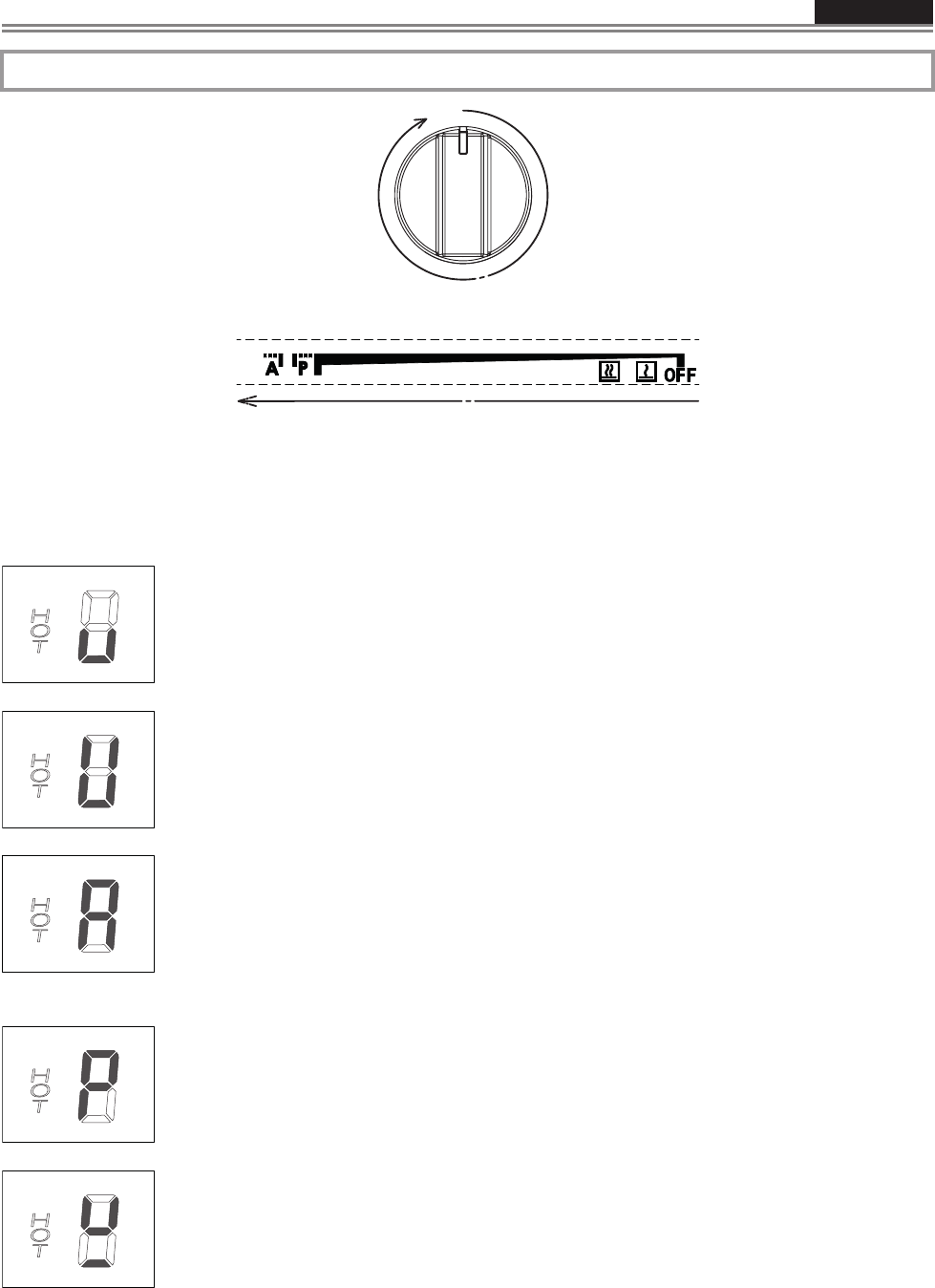
ENGLISH
Use & Care Manual
33
Element and Control Setting
Control knobs and power level adjusting
Theplacementofeachknobcorrespondstotheplacementoftheinductionelementthatitcontrols.
Toturnonany,PUSHandTURNtheknobclockwisetotherequiredsetting,oftheaccording cookingzonecanbeincreased
betweenaminimum of1toamaximumof9.Toreducethe powerofthecookingzoneagainitisnecessarytoturntheknob
anticlockwise.
Thecurrentpowerlevelisdisplayedonthedisplayunitofthehob.
Melting function
Iftheknobisturnedclockwisefromzeropositiontherst“powerlevel”reachedisthemeltingfunction.
Theaccording7segmentdisplayunitshowsthis“u”symbol.Themeltingfunctionisusedtoheatupthe
bottomofthepot(40°Cinsidethepot).Thisfunctionisusedtomeltfood.Themaximumtimeforusingthe
meltingfunctionislimitedto2hours.
Warming function
Thewarmingfunctionisthesecond“powerlevel”whichwillbeselectedwhenturningtheknobclockwise.
Theaccording7segmentdisplayunitshowsthis“U”symbol.Thewarmingfunctionisusedtoheatupthe
bottomofthepotto70°C(65°Cinsidethepot).Usingthisfunctionthefoodcanbekeptwarmoritcanbe
usedtowarmupfoodgently.
Themaximumtimeforusingthewarmingfunctionislimitedto2hours.
Automatic Heat Up time function
Toactivatetheheatuptimeautomaticpressandturntheknobcounterwiseinoverwindposition“A”until
abeepsoundsandthe“A”symbolonthedisplaystartsblinkingwaitingforaninput.Withinthenext10sa
validcookinglevelhastobeselectedfrom1to8.
Thiswillbethecookinglevelafteradenedtimeofhigherpoweroutputatlevel9.The7segmentdisplay
alternatesbetween“A”andtheselectedcookinglevel.
Iftheknobisturnedclockwisebyselectinglevel0,level9,(warming,melting)orinanypositioncounterwise
theautomaticheatupfunctionwillbeturnedoff.
Booster function
Toactivatetheboostfunctionpressandturntheknob clockwiseinoverwindposition“P” untilabeep
sounds.Thesymbolisasshown“P”andwillbedisplayed.After10minutestheboostfunctionwillbe
automaticallyswitchedoffandthe“P”isnotshownonthedisplayanymoreandtheinductioncontrolwill
besetautomaticallyatlevel9.
Cookware recognition function
Thecookinglevelofcookingzonecanbeselectedbyturningtheknobtotheaccordingpositionevenifno
potisinplace.Theoutputofpowerstartsautomaticallyassoonasanappropriatepotisputonthecooking
zone.Ifnopotisbeingdetectedthedisplaychangestotheshown“potmissing”symbolafterashorttime.
Thissymbolwillbeshownuntilaappropriatepotisputonthecookingzoneorthemaximumtimeof10
minutesexpired.Thesameappliesifthepotisremovedduringnormalcooking.
After10minuteswithoutdetectedpotthecookingzoneswitchesoffautomaticallyandcanonlybeactivated
againafterreturningtheknobintotheOFFposition.
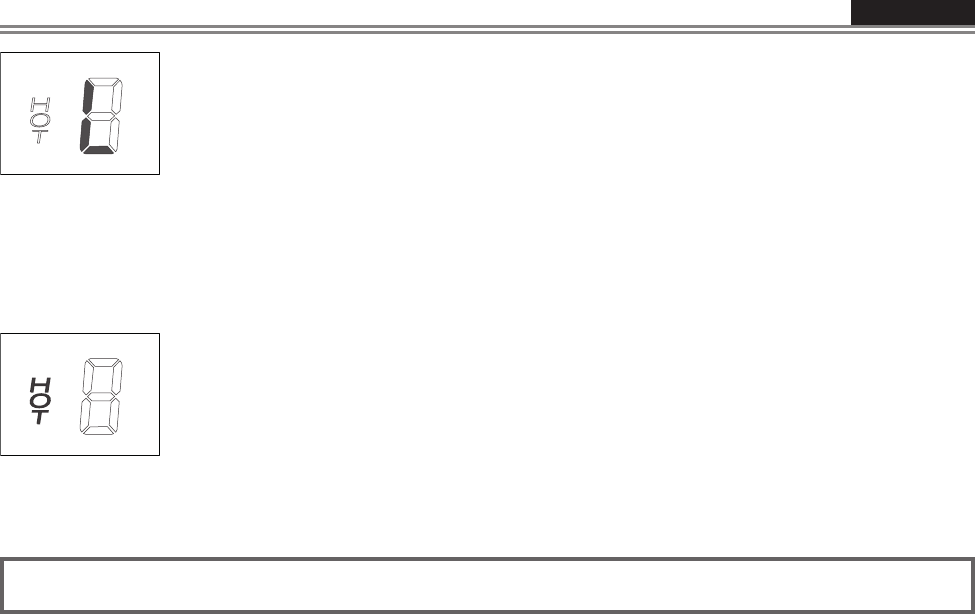
ENGLISH
Use & Care Manual
34
these directly in the
You can use the “Booster” function with water and
food to the pan.
Always use pots and pans with a proper lid.
too long.
Always choose containers of an adequate size for the
completely full consumes a lot of energy.
of the pan corresponds with the cooking area indicated
on the glass.
amount of water. Do not heat empty pans otherwise
cooking area.
6HWWLQJ5HFRPPHQGHG8VH
depend on:
• Type and quality of the pan.
these directly in the
You can use the “Booster” function with water and
food to the pan.
Always use pots and pans with a proper lid.
too long.
Always choose containers of an adequate size for the
completely full consumes a lot of energy.
of the pan corresponds with the cooking area indicated
on the glass.
amount of water. Do not heat empty pans otherwise
cooking area.
6HWWLQJ5HFRPPHQGHG8VH
depend on:
• Type and quality of the pan.
Control Lock function
The control lock is a device that protects the appliance from accidental or inappropriate use. With all
cookingzonesturnedoff,simultaneouslypressandturnthersttwoleftknobscounterwiseinoverwind
position“A”.Theyneedtobeholdinthatpositionforaleast2suntilthesymbols“L”appearonthe
displays,thenreleasetheknobs.
InordertodeactivatetheCLfunctionrepeatthesameprocedureasforactivating.
Afterunlockingallknobshavetobeturnedbackinthezeroposition(ifanyknobwasinapositiondifferent
fromzero).Thecontrolisthanoffandcanbeoperatedasexpected.
NOTE:IftheknobsarenotholdintheOWLpositionforlongenoughtheCLwillnotbeenabled/displayed.
Iftheknobsareholdinthatpositionformorethan30secondstheinputisconsideredtobeinvalidanda
errormessage“Permanentuseofkey”willbedisplayed(ashsymbol).
Residual Heat indication
Cookingzoneswhicharealreadyswitchedoffcanstillhaveahotglasssurface.Inordertowarnand
protectusersfromburningthemselvesthisconditionisvisualized,theresidualheatmeasurementisdone
fromthetemperaturesensorofeachinductivecookingzone..
Whenthemeasuredtemperaturedropsbelow60°Contheglassthesymbolindicatingthehotsurface
disappears.
Advice on cooking
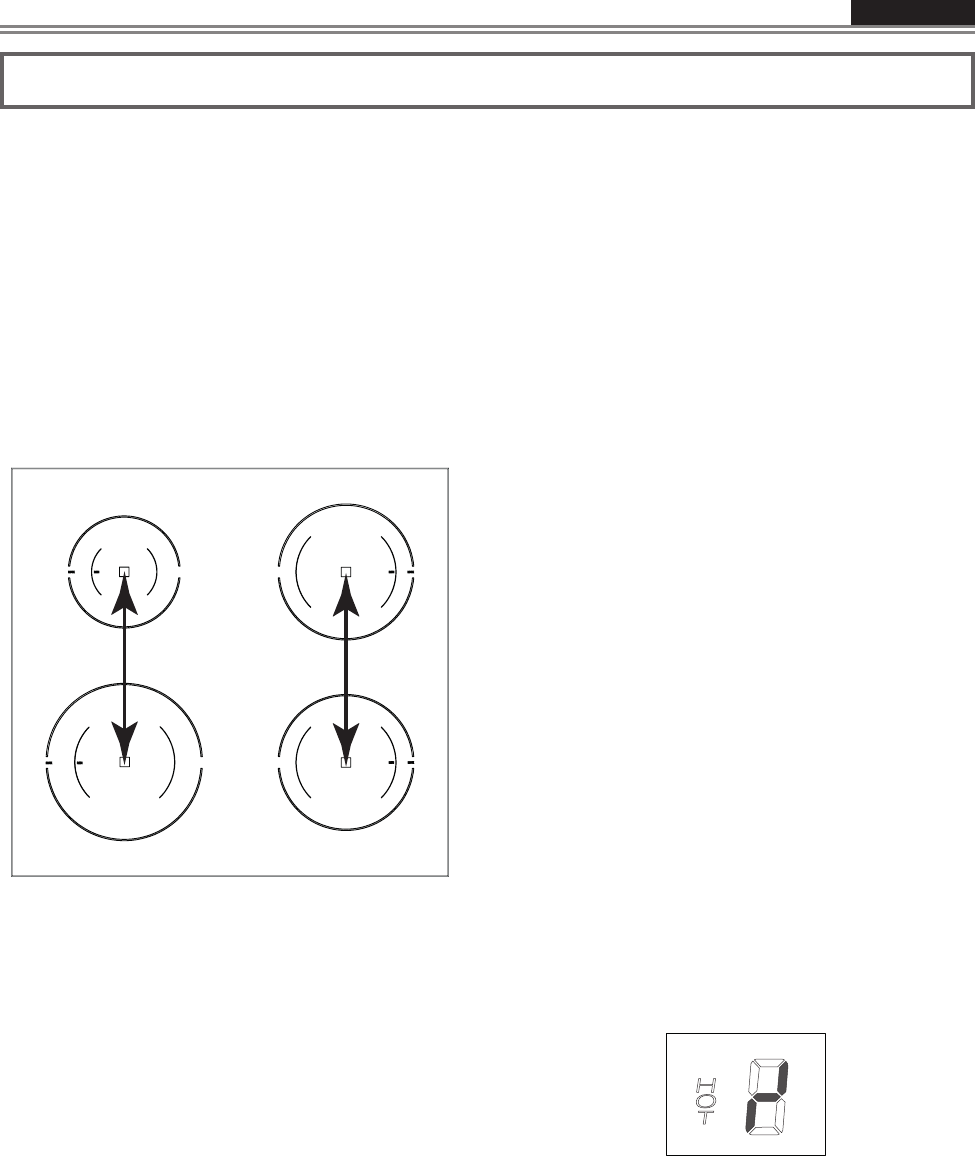
ENGLISH
Use & Care Manual
35
Induction Cooktop Operation
BEFORE USING THE COOKTOP FOR
THE FIRST TIME
● Allproductsarewipedcleanwithsolventsatthe
factory to remove any visible signs of dirt, oil,
and grease which may have remained from the
manufacturingprocess.
● Cleanyourglasstopbeforethersttimeyouuse
it.Athoroughcleaningwithaglasstopcleaneris
recommended.Itonlytakesaminuteandputsa
clean, shiny coating on the glass top before its
initialuse.
● Theremaybeaslightodourduringtherstseveral
uses:thisisnormalandwilldisappear.
● Optimum cooking result depends on the proper
cookwarebeingselectedandused.
● Thecookingsurfacewillholdtheheatandremain
hotover20minutesaftertheelementshavebeen
turnedoff.
● The glass ceramic cooking surface is a durable
materialresistanttoimpactbutnotunbreakableif
apanorotherobjectisdroppedonit.
● Donorallowpanstoboildry.Thiscandamagethe
pan,elementand/orcooktop.
● Donotslidecookwareacrosscookingsurfaceit
mayscratchtheglass
● UsingcastironcookwareontheglasscooktopIs
notrecommended.Castironretainsheatandmay
resultincooktopdamage.
Power Sharing
One generatorcontrols2elements,ortwocooking
zoneswithinaheatingsectionsharethepowerof
onegenerator.PowerSharingisactivatedwhenboth
elementsinthesamecookingzoneareactivatedand
oneelementissetforBoost(P).Theelementthatis
notsetforBoostwillchangetoalowerpowerlevel.
ThisiscalledPowerSharing:Thelatestsetcooking
levelhaspriority.
IMPORTANT!
Automatic Switch OFF
The inductionhobhasanautomaticdevicewhich
limitsthedurationofuse.
Dependingonthechosencookinglevelamaximum
operationtimelimitationisdened,thesafetydevice
willbeactivatedonlyifnochangeofcookinglevelis
done.Ifthismaximumoperatingtimeisexceededon
acookingzonethiscookingzoneisbeingswitched
off,ashortbeepsoundsandifthezoneishotthe
“residualheat”symbolisshowed.
In ordertoreactivatethiscookingzonethecontrol
knobhastobeturnedbackintoOFFposition.
IMPORTANT!
Overheating status of cooking zone
Ifthehobisusedonfullpowerforalongperiod,the
electronicscouldhavetroublecoolingdownifthe
roomtemperatureishigh.Toavoidexcessivelyhigh
temperaturesformingintheelectronics,thepowerto
thecookingzoneismanagedautomaticallytoprotect
itself.
Permanent use of keys
Iftheknobshavebeenkeptrotatedinthe“A”or“P”
positionsformorethan30secondsafaultmessage
willappearonthedisplay.
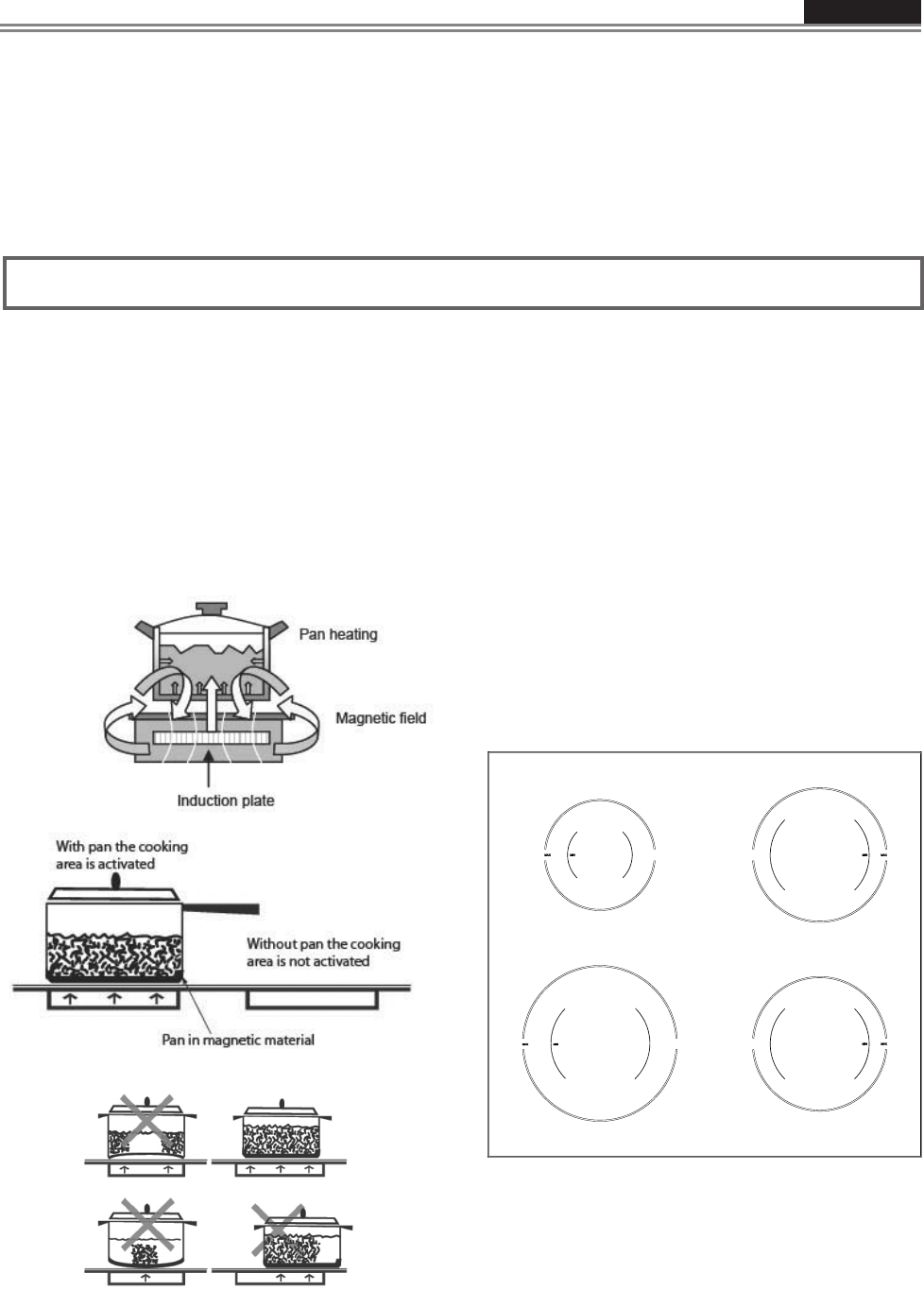
ENGLISH
Use & Care Manual
36
Cookware “noise”
Whenusingadjacentelementsthataresetatcertain
powerlevelsettings,magneticeldsmayinteractand
producealowwhistleorintermitted“hum”.Pansthat
completelycovertheelementringwillproduceless
noise.Alow “humming” noise is normal particularly
on high settings. These noise can be reduced or
eliminated by lowering or raising the power level
settingsofoneorbothoftheelements.
How INDUCTION heating works
Thereisanelectroniccircuitinsidetheinductionhob
whichpowersandcommandsacoil.Thiscreatesa
magneticeldwhichactivateswhenitcomes into
contactwithsuitablepotsandpans(magnetic
material).
Thepanonthehobwarmsupinstantly,whilethehob
remainscold.
Thereisnolossofheat.Theheatgeneratedinthe
panletsyoucookquickly,savingtimeandemergy.
Pots and pans and how to use them.
Attention!
Thereisanelectroniccircuitinsidetheinductionhob
mustbemadeofferromagneticmaterial.Theycanbe
madeofenamaledsteel,castironorspecialpansof
stainlesssteelforinduction.
Tomakesureapanissuitable,tryusingamagnet
toseeifitstickstothebottomofthepan.Neveruse
normalthinsteelnoranythingcontainingevenjustan
amountofglass,terracotta,copperoraluminum.
Thedisplayofthecookingareawillshowifthepanis
suitable,ifthepowerIndicatorashesthepanisnot
suitableorthediameterofthebottomistoosmallfor
thediameterofthecookingarea.
Thepotsandpansmust beplaced preciselyinthe
middleofthecookingarea.
In some cooking areas an internal diameter is
indicated,withalighteroutline.
3” ¾ (9,5 cm)
minimum
diameter
pan size
5” ¾ (14,5 cm)
minimum
diameter
pan size
5” ¾ (14,5 cm)
minimum
diameter
pan size
5” ¾ (14,5 cm)
minimum
diameter
pan size
Usetheminimumsizepanshownforeachcooking
element.
Cookware
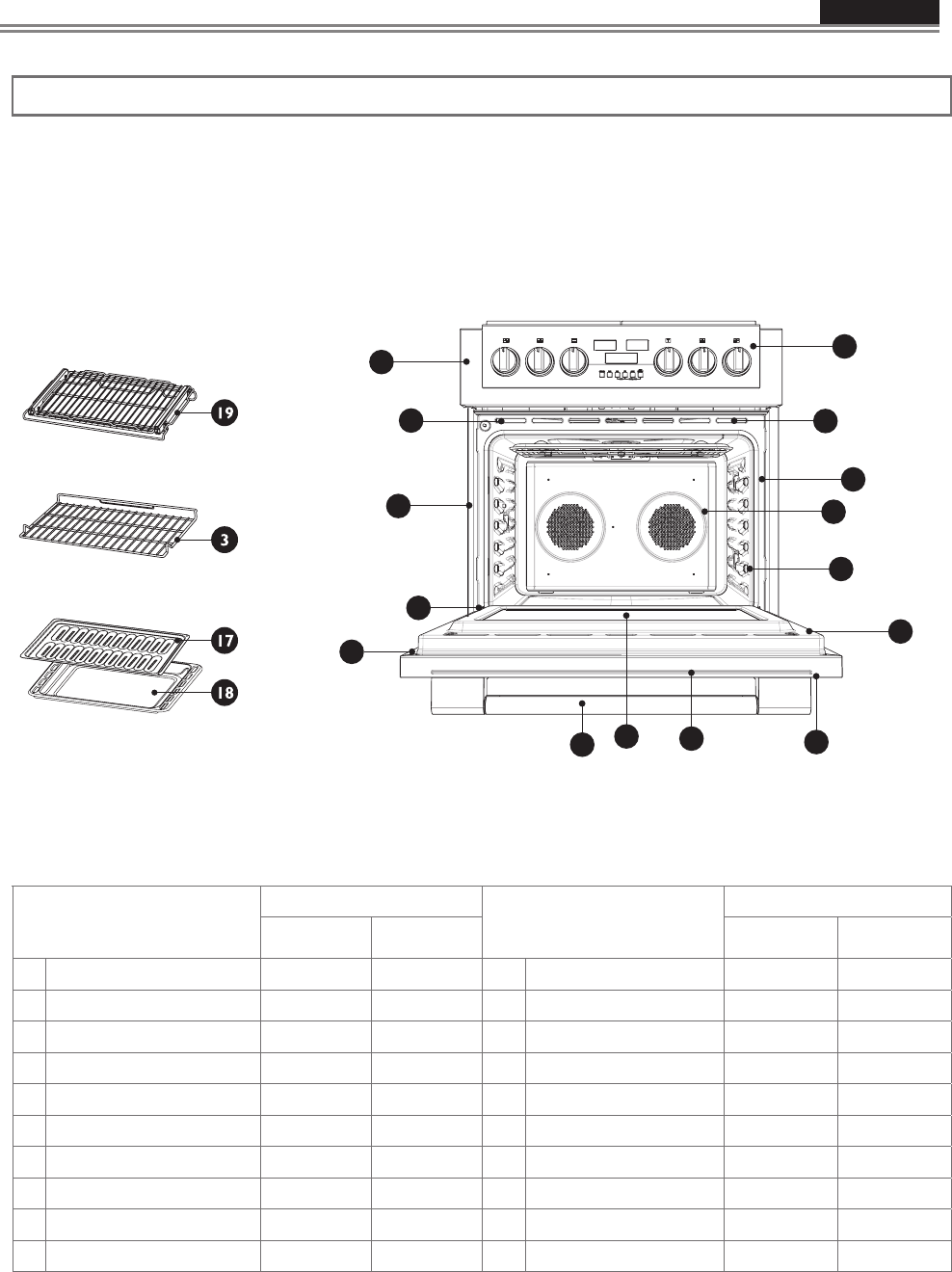
ENGLISH
Use & Care Manual
37
General Oven Care
How to Use the Oven Cleaning Chart
1. Locate the number of the part to be cleaned in the illustration on this page.
2. Find the part name in the chart.
x Use the cleaning method in the left column if the oven is black or white.
x Use the cleaning method in the right column if the oven is stainless steel.
3. Match the letter with the cleaning method on following page.
Cleaning Chart
Cleaning Method Cleaning Method
Part Stainless Stell Part Stainless Stell
1 Door frame 11 Interior Oven Door E E
2 Interior door windows F F 12 Door Handle
3 Removable Oven Racks A or E A or E 13 Door Cooling Vent E E
4 Slide Trim 14 Door Front C&D C&G
5 Control Panel Trim 15 Oven Trim D D
6 Control Panel 16 End Caps D G
7 Oven Cooling Vents D D 17 Broil Pan Rack E E
8 Oven Front Frame E E 18 Broil pan Bottom E E
9 Oven Cavity E E 19 Extendable rack A A
10 Mesh Gasket B B
Enamelled
D G
G G
G G
D G
G G
Enamelled
5
4
6
7
8
10
11
16
14
12
1
15
13
2
9
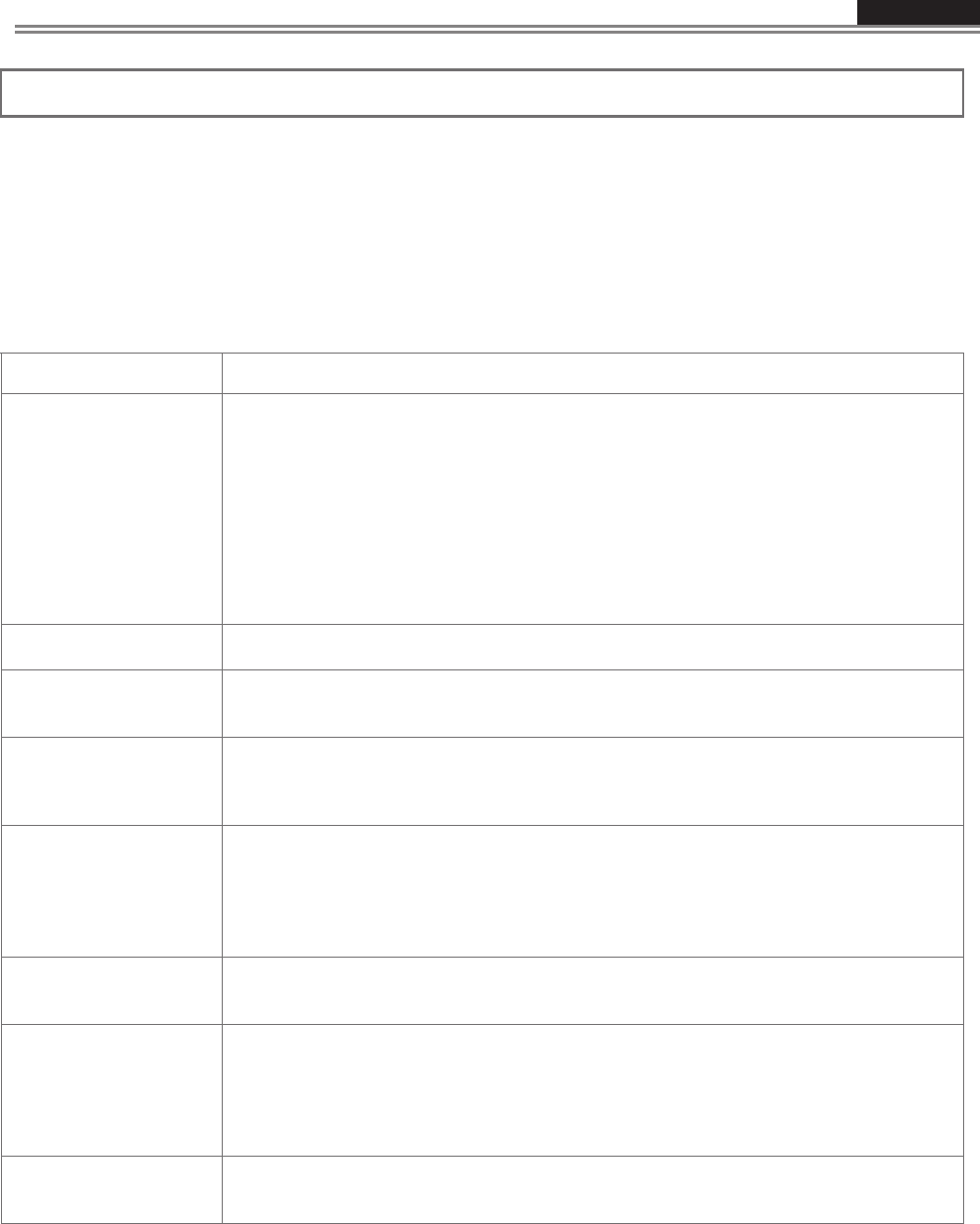
ENGLISH
Use & Care Manual
38
Oven Finishes / Cleaning Methods
The entire oven can be safely cleaned with a soapy sponge, rinsed and dried. If stubborn soil remains, follow
the recommended cleaning methods below.
x Always use the mildest cleaner that will do the job.
x Rub metal finishes in the direction of the grain.
x Use clean, soft cloths, sponges or paper towels.
x Rinse thoroughly with a minimum of water so it does not drip into door slots.
x Dry to avoid water marks.
The cleaners listed below indicate types of products to use and are not being endorsed. Use all products
according to package directions.
Part Cleaning Method
A Chrome Plated Wash with hot sudsy water. Rinse thoroughly and dry. Or, gently rub with Soft
Scrub®,
Bon-Ami®, Comet®, Ajax®, Brillo® or S.O.S.® pads as directed. Easy Off® or
Dow® Oven
Cleaners (cold oven formula) can be used, but may cause darkening and
discoloration.
Racks may be cleaned in the oven during the self-clean mode. However, chromed
racks will lose their shiny finish and permanently change to a metallic gray.
B Fiberglass Knit DO NOT HAND CLEAN GASKET.
C Glass Spray Windex® or Glass Plus® onto a cloth first then wipe to clean. Use Fantastik®
or Formula 409® to remove grease spatters.
D Painted Clean with hot sudsy water or apply Fantastik® or Formula 409® first to a clean
sponge or paper towel and wipe clean. Avoid using powdered cleansers and steel
wool pads.
E Porcelain Immediately wipe up acidic spills like frui t juice, milk and tomatoes with a dry towel. Do
not use a moistened sponge/towel on hot porcelain. When cool, clean with hot sudsy
water or apply Bon-Ami® or Soft Scrub® to a damp sponge. Rinse and dry. For
stubborn stains, gently use Brillo® or S.O.S. ® pads. It is normal for porcelain to
craze (fine lines) with age due to exposure from heat and food soil.
F Reflective Glass Clean with hot sudsy water and sponge or plastic scrubber. Rub stubborn stains with
vinegar, Windex®, ammonia or Bon-Ami®. DO NOT USE HARSH ABRASIVES.
G Stainless Always wipe or rub with grain. Clean with a soapy sponge then rinse and dry. Or,
wipe with Fantastik® or Formula 409® sprayed onto a paper towel. Protect and
polish with Stainless Steel Magic® and a soft cloth. Remove water spots with a cloth
dampened with white vinegar. Use Zud®, Cameo®, Bar Keeper’s Friend® or
RevereWare Stainless Steel Cleaner®, to remove heat discoloration.
H Probe (if present) Clean probe by hand with detergent and hot water. Then rinse and dry.
Do not so or clean in dishwasher
.
ENGLISH
Use & Care Manual
15
Cleaning the Cooktop
CAUTION
Be sure electrical power is off and all surfaces are
cool before cleaning any part of the cooktop.
Apply a small amount of cooktop cleaning specific
ceramic crème on a daily basis. this provides a
protective film that makes it easy to remove water
spots or food spatters. The temperature of the cooking
surface reduces the protective qualities of this
cleaner.
It must be reapplied before each use. Use a clean
cloth and apply cooktop cleaning crème before each
use to remove dust or metal marks that can occur on
the counter level surface between uses.
FRAME
(Stainless steel models)
Always wipe with the grain when cleaning. For
moderate/ heavy soil, use BonAmi® or Soft Scrub® (no
bleach).
Wipe using a damp sponge or cloth, rinse and dry.
DAILY CLEANING TECHNIQUES
Clean the surface when it is completely cool with the
following exception.
Remove these soils
immediately with the
razor blade scraper:
x Dry Sugar
x Sugar Syrup
x Tomato Products
x Milk
USE DAILY
Wipe off spatters with a clean, damp cloth; use white
vinegar if smudge remains; rinse.
Apply a small amount of the Cooktop Cleaning
Crème.
When dry, buff surface with a clean paper towel or
cloth.
CAUTION
Do not use any kind of cleaner on the glass while the
surface is hot; use only the razor blade scraper. The
resulting fumes can be hazardous to your health.
Heating the cleaner can chemically attack and
damage the surface.
RECOMMENDED CLEANERS
x Cooktop Cleaning Crème:
Use only a small amount; apply to a clean paper towel
or cloth. Wipe on the surface and buff with a clean dry
towel.
x BonAmi®:
Rinse and dry.
x Soft Scrub® (without bleach):
Rinse and dry.
x White Vinegar:
Rinse and dry.
x Razor blade scraper
Packaged with cooktop.
Note: The recommended cleaners indicate a type of
cleaner and do not constitute an endorsement.
AVOID THESE CLEANERS
x Glass cleaners which contain ammoniac or
chlorine bleach
These ingredients may permanently etch or stain the
cooktop.
x Caustic Cleaners
Oven cleaners such as Easy Off® may etch the
cooktop surface.
x Abrasive Cleaners
Metal scouring pads and scrub sponges such as
Scotch Brite® can scratch and / or leave metal marks.
Soap-filled scouring pads such as SOS® can scratch
the surface.
x Powdery cleaners
Containing chlorine bleach can permanently stain the
cooktop.
x Flammable cleaners
Such as lighter fluid or WD-40.
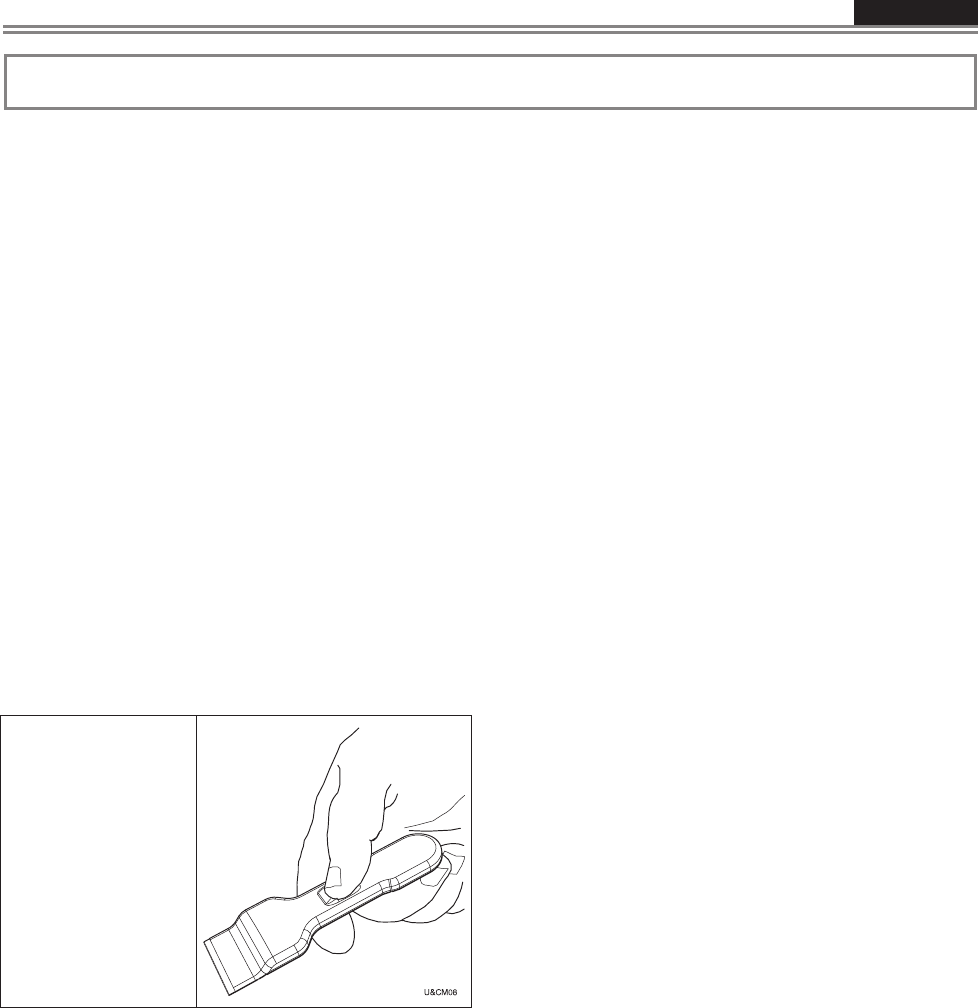
ENGLISH
Use & Care Manual
39
ENGLISH
Use & Care Manual
15
Cleaning the Cooktop
CAUTION
Be sure electrical power is off and all surfaces are
cool before cleaning any part of the cooktop.
Apply a small amount of cooktop cleaning specific
ceramic crème on a daily basis. this provides a
protective film that makes it easy to remove water
spots or food spatters. The temperature of the cooking
surface reduces the protective qualities of this
cleaner.
It must be reapplied before each use. Use a clean
cloth and apply cooktop cleaning crème before each
use to remove dust or metal marks that can occur on
the counter level surface between uses.
FRAME
(Stainless steel models)
Always wipe with the grain when cleaning. For
moderate/ heavy soil, use BonAmi® or Soft Scrub® (no
bleach).
Wipe using a damp sponge or cloth, rinse and dry.
DAILY CLEANING TECHNIQUES
Clean the surface when it is completely cool with the
following exception.
Remove these soils
immediately with the
razor blade scraper:
x Dry Sugar
x Sugar Syrup
x Tomato Products
x Milk
USE DAILY
Wipe off spatters with a clean, damp cloth; use white
vinegar if smudge remains; rinse.
Apply a small amount of the Cooktop Cleaning
Crème.
When dry, buff surface with a clean paper towel or
cloth.
CAUTION
Do not use any kind of cleaner on the glass while the
surface is hot; use only the razor blade scraper. The
resulting fumes can be hazardous to your health.
Heating the cleaner can chemically attack and
damage the surface.
RECOMMENDED CLEANERS
x Cooktop Cleaning Crème:
Use only a small amount; apply to a clean paper towel
or cloth. Wipe on the surface and buff with a clean dry
towel.
x BonAmi®:
Rinse and dry.
x Soft Scrub® (without bleach):
Rinse and dry.
x White Vinegar:
Rinse and dry.
x Razor blade scraper
Packaged with cooktop.
Note: The recommended cleaners indicate a type of
cleaner and do not constitute an endorsement.
AVOID THESE CLEANERS
x Glass cleaners which contain ammoniac or
chlorine bleach
These ingredients may permanently etch or stain the
cooktop.
x Caustic Cleaners
Oven cleaners such as Easy Off® may etch the
cooktop surface.
x Abrasive Cleaners
Metal scouring pads and scrub sponges such as
Scotch Brite® can scratch and / or leave metal marks.
Soap-filled scouring pads such as SOS® can scratch
the surface.
x Powdery cleaners
Containing chlorine bleach can permanently stain the
cooktop.
x Flammable cleaners
Such as lighter fluid or WD-40.
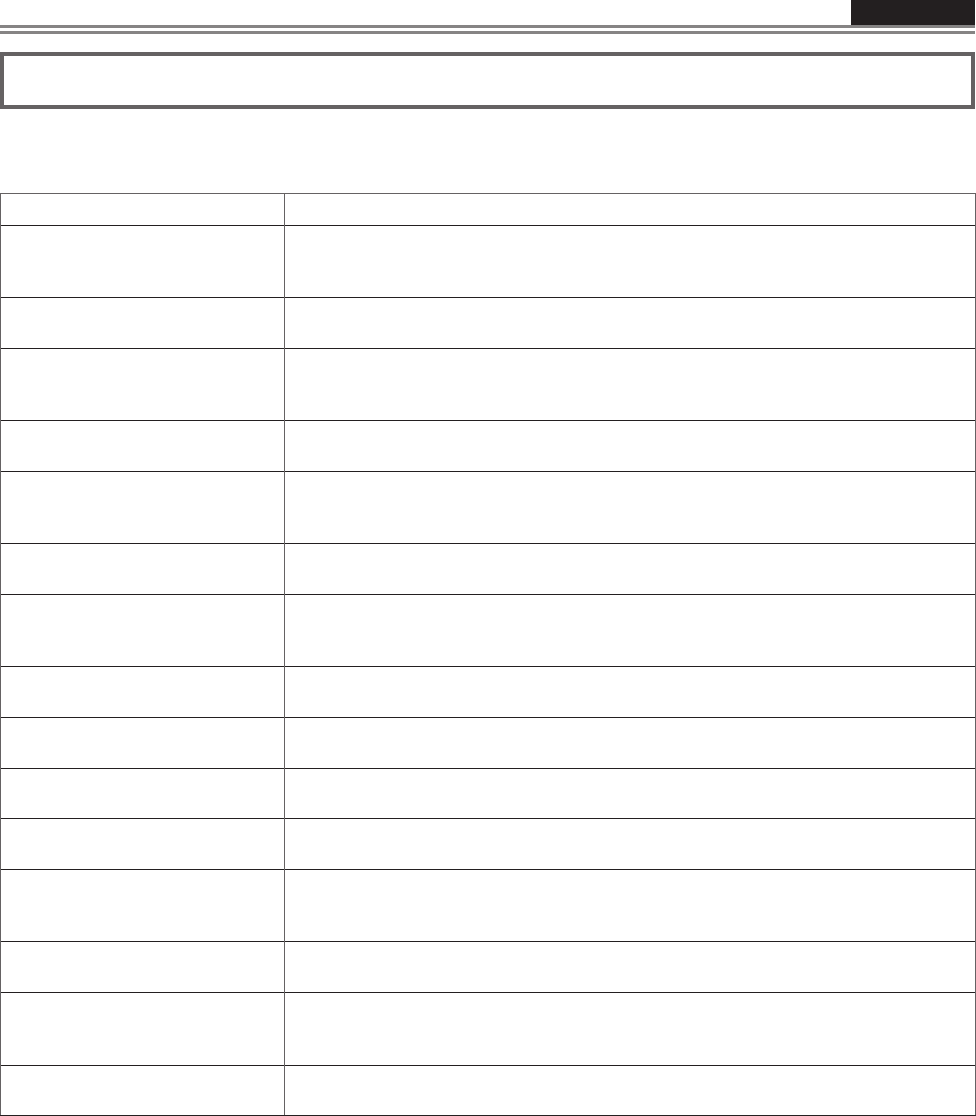
ENGLISH
Use & Care Manual
40
Beforecallingforservice,checkthefollowingtoavoidunnecessaryservicecharges.
Oven Problem Problem Solving Steps
F03orF04Errorappearsinthe
displaywindow.
Aproblemwithlatchmechanismoccurred.Removepowerandturnitbackonagain
afterafewseconds.Theovenshouldrunalatchauto–test.Ifconditionpersists,
notethecodenumberandcallanauthorizedservice.
OtherF__Errorappearsinthe
displaywindow.
Removepowerandturnitbackonagainafterafewseconds.Ifconditionpersists,
notethecodenumberandcallanauthorizedservice.
TheovendisplaystaysOFF Turnoffpoweratthemainpowersupply(fuseorbreakerbox).Turnbreakerback
on.
Ifconditionpersists,callanauthorizedservicecenter.
Coolingfancontinuestorunafter
ovenisturnedoff
Thefanturnsoffautomaticallywhentheelectroniccomponentshavecooled
sufciently.
Ovendoorislockedandwillnot
release,evenaftercooling
Turntheovenoffatthecircuitbreakerandwaitafewseconds.Turnbreakerback
on.
Theovenshouldresetitselfandwillbeoperable.
Ovenisnotheating Checkthecircuitbreakerorfuseboxtoyourhouse.Makesurethereisproper
electricalpowertotheoven.Makesuretheoventemperaturehasbeenselected.
Ovenisnotcookingevenly Checkovencalibration.Adjustcalibrationifnecessary(seeToSetTemperature,
Page14).Refertocookchartsforrecommendedrackposition.Alwaysreduce
recipetemperatureby25°F(15°C)whenbakingwithConventionBakemode.
Oventemperatureistoohotor
toocold
Theoventhermostatneedsadjustment.SeeCalibratingOvenTemperature,Page
14.
Ovenlightisnotworkingproperly Replaceorreinsertthelightbulbiflooseordefective.SeePage31.Touchingthe
bulbwithngersmaycausethebulbtoburnout.
Ovenlightstayson Checkforobstructioninovendoor.Checktoseeifhingeisbentordoorswitch
broken.
Cannotremovelenscoveron
light
Theremaybeasoilbuild-uparoundthelenscover.Wipelenscoverareawitha
cleandrytowelpriortoattemptingtoremovethelenscover.
OvenwillnotSelf-Cleanproperly AllowtheoventocoolbeforerunningSelf-Clean.Alwayswipeoutloosesoilsor
heavyspill-overbeforerunningSelf-Clean.Ifovenisbadlysoiled,setovenfora
four-hourSelf-Clean.SeePreparingtheOventoSelf-Clean,Page28.
Clockandtimerarenotworking
properly
Makesurethereisproperelectricalpowertotheoven.SeetheClockandTimer
sectionsonPage13.
Excessivemoisture WhenusingBakemode,preheattheovenrst.ConvectionBakeandConvection
Roastwilleliminateanymoistureinoven(thisisoneoftheadvantagesof
convection).
Porcelainchips Whenovenracksareremovedandreplaced,alwaystiltracksupwardanddonot
forcethemtoavoidchippingtheporcelain.
OVEN Solving Operational Problems
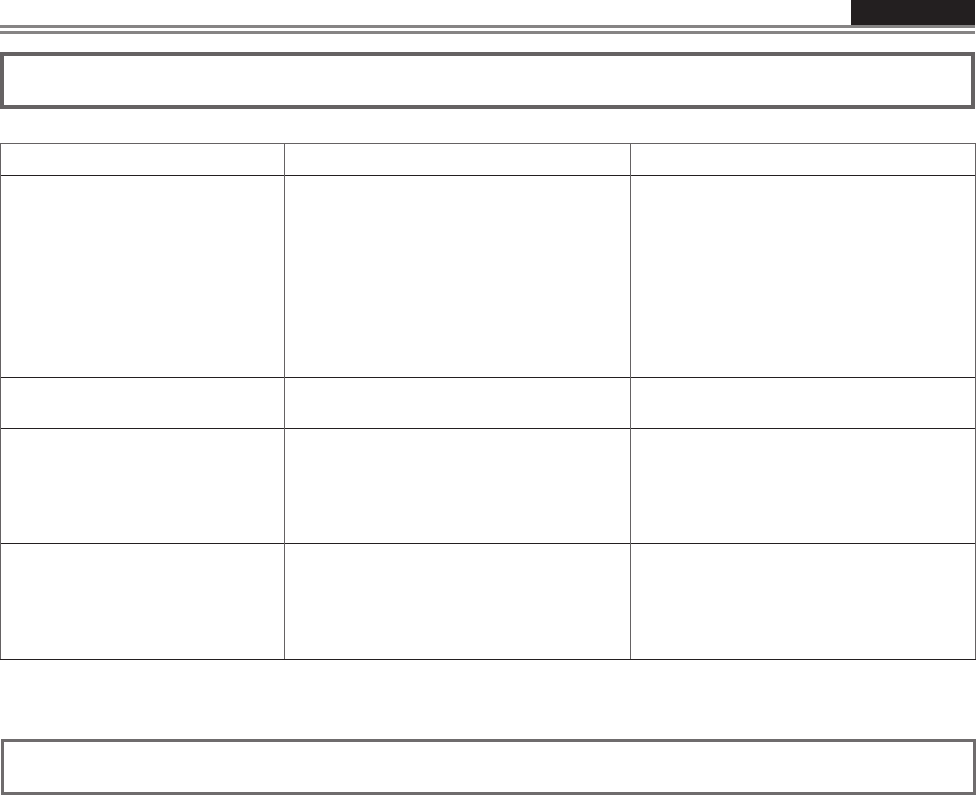
ENGLISH
Use & Care Manual
41
Problem Cause Possible Remedy
Nothingworks
Cooktop not connected to proper
electricalcircuit.
Fuseisblownorcircuitbreakeristripped.
Noelectricitytothecooktop.
Cooktopisinlockoutmode.
Have electrician verify that the proper
ratedcooktopvoltageisbeingsuppliedto
thecooktop.Haveelectricianreplacefuse
orresetcircuitbreaker.
Haveelectriciancheckyourpowersupply.
Unlockcooktop.
Heatingelementsdonotheat
properly
Impropercookwareisbeingused. Selectpropercookwareasoutlinedinthe
CooktopOperationsectionofthismanual.
Glass ceramic surface is
seethroughorappearstobered
incolor.
Under direct or bright lighting, you will
sometimes be able to see through the
glass and into the chassis due to its
transparentquality.Youmayalsonoticea
redtintundertheseconditions
Thesearenormalpropertiesofblack
ceramicglasspanels.
Lock Key blocked after rst
connectingorunresponsivetouch
control.
Whenrstconnectingelectricallyorafter
a power failure, any direct strong light
overthesensorareamayaffectthetouch
controlfunctionality.
When powering on the unit make sure
thatnostronglightisshiningdirectover
thetouchcontrolzone,itcanpromisethe
start-upsensorcalibrationresultinginan
unresponsivetouchcontrol.
Résolution de problèmes opérationnels TABLE DE CUISSON
Assistance or Service
Before calling for assistance or service, please check
"Troubleshooting." It may save you the cost of a
service call.
If you still need help, follow the instructions below.
When calling, please know the purchase date and the
complete model and serial number of your appliance.
This information will help us to better respond to your
request.
Service Data Record
For authorized service or parts information see
paragraph "WARRANTY for Home Appliances".
Now is a good time to write this
information in the space provided below. Keep your
invoice for warranty validation.
Model Number _____________________
Serial Number ______________________
Date of Installation or Occupancy ________________
ForserialtaglocationseePage7.